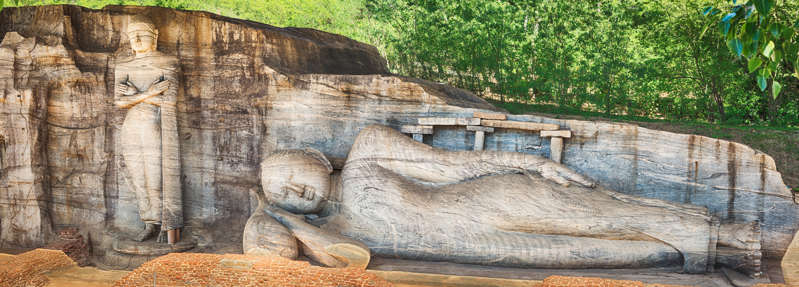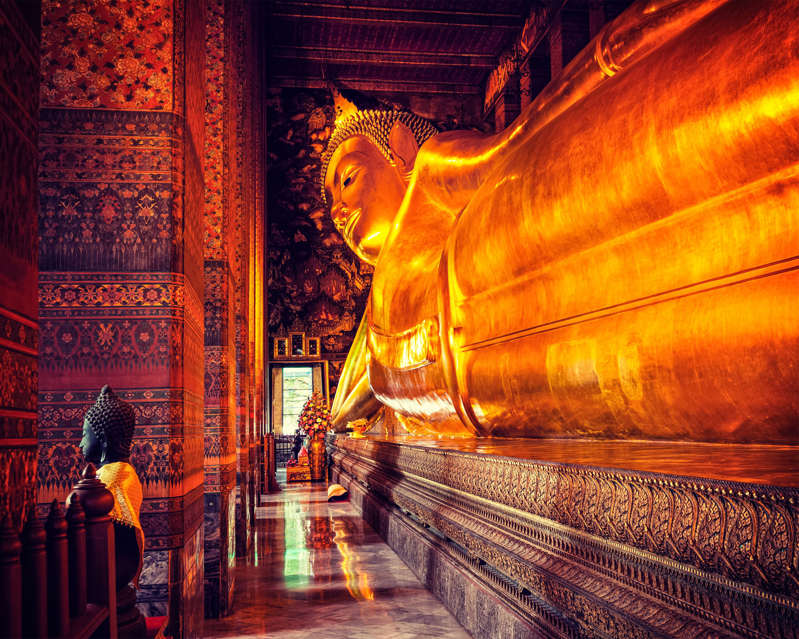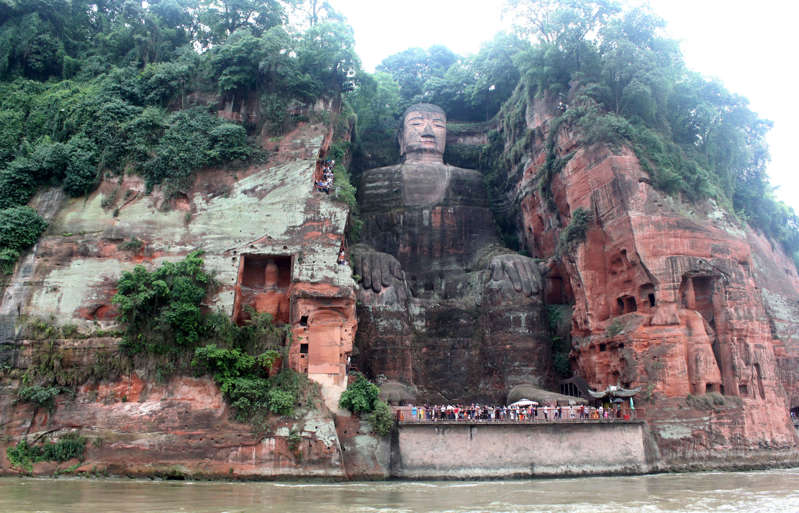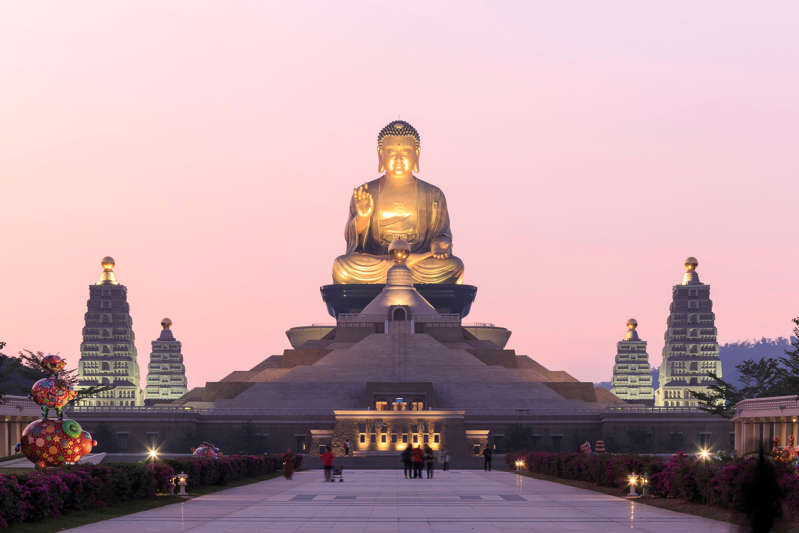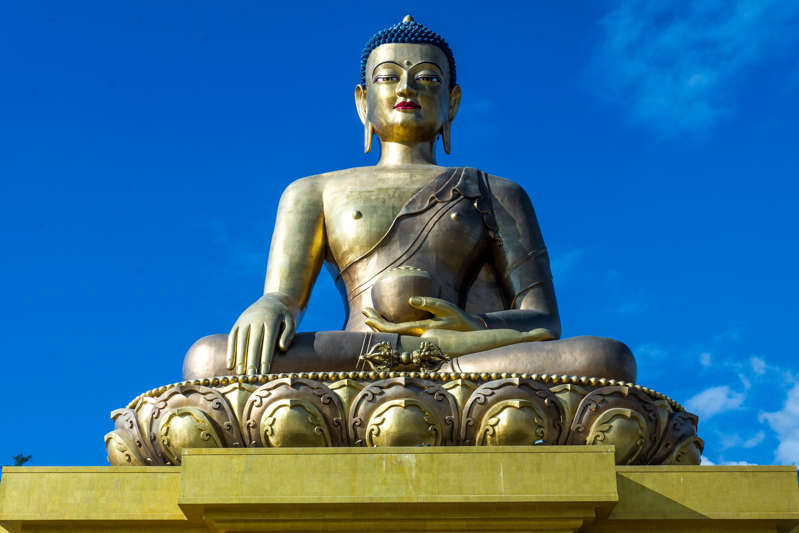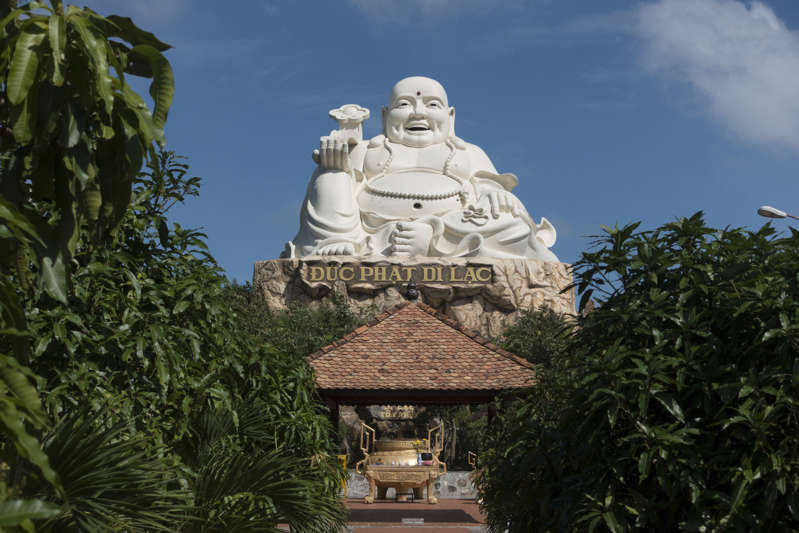For The Welfare, Happiness, Peace of All Sentient and Non-Sentient Beings and for them to Attain Eternal Peace as Final Goal. at
KUSHINARA NIBBANA BHUMI PAGODA-is a 18 feet Dia All White Pagoda with a table or, but be sure to having above head level based on the usual use of the room.
in 116 CLASSICAL LANGUAGES and planning to project Therevada Tipitaka in
Buddha’s own words and Important Places like Lumbini, Bodh
gaya,Saranath, Kushinara, Etc., in 3D 360 degree circle vision akin to
Circarama
When
you are in Bengaluru you are most welcome to visit Kushinara Nibbana Bhumi Pagoda
At
WHITE HOME
668, 5A main Road, 8th Cross, HAL III Stage,
Prabuddha Bharat Puniya Bhumi Bengaluru
Magadhi Karnataka State
PRABUDDHA BHARAT
May you, your family members and all sentient and non sentient beings be ever happy, well and secure!
May all live for 150 years
with NAD pills to be available in 2020 at a price of a cup of coffee
according to research doctors at Sydney!
May all have calm, quiet, alert and attentive and have equanimity mind with a clear understanding that everything is changing!
Suttas word by word
10 Famous Buddha Statues
09) Classical Albanian-Shqiptare klasike,
10) Classical Amharic-አንጋፋዊ አማርኛ,
11) Classical Arabic-اللغة العربية الفصحى
12) Classical Armenian-դասական հայերեն,
13) Classical Azerbaijani- Klassik Azərbaycan,14) Classical Basque- Euskal klasikoa,
15) Classical Belarusian-Класічная беларуская,
16) Classical Bengali-ক্লাসিক্যাল বাংলা,
17) Classical Bosnian-Klasični bosanski,
18) Classical Bulgaria- Класически българск,19) Classical Catalan-Català clàssic
20) Classical Cebuano-Klase sa Sugbo,
21) Classical Chichewa-Chikale cha Chichewa,
22) Classical Chinese (Simplified)-古典中文(简体),
23) Classical Chinese (Traditional)-古典中文(繁體),
24) Classical Corsican-Corsa Corsicana,
25) Classical Croatian-Klasična hrvatska,
26) Classical Czech-Klasická čeština,27) Classical Danish-Klassisk dansk,Klassisk dansk,
28) Classical Dutch- Klassiek Nederlands,30) Classical Esperanto-Klasika Esperanto,
31) Classical Estonian- klassikaline eesti keel,
32) Classical Filipino klassikaline filipiinlane,
33) Classical Finnish- Klassinen suomalainen,
34) Classical French- Français classique,
35) Classical Frisian- Klassike Frysk,
SN 22.59 (S iii 66)
Anattalakkhana Sutta
- Die kenmerk van geen-self -
[anattā · lakkhaṇa]
In hierdie baie bekende sutta lê die Boeddha vir die eerste keer sy onderrig oor anatta uit.
By
een geleentheid het die Bhagavā in Bārāṇasi in die Deer Grove in
Isipatana gebly. Daar het hy die groep van vyf bhikkhus toegespreek:
- Bhikkhus.
- Bhadante, antwoord die bhikkhus. Die Bhagavā het gesê:
-
Rūpa, bhikkhus, is anatta. En as hierdie rûpa atta, bhikkhus was, sou
hierdie rûpa hom nie verlig nie, en van rûpa kon gesê word: ‘Laat my
rûpa so wees, laat my rûpa nie so wees nie.’ Maar dit is omdat rûpa
anatta is wat rûpa hom toelaat om te verswak, en dat dit nie van rûpa
gesê kan word nie: ‘Laat my rûpa so wees, laat my rûpa nie so wees nie.’
Vedanā,
bhikkhus, is anatta. En as hierdie vedanā atta, bhikkhus, sou hierdie
vedanā hom nie verleent nie, en van vedanā kon gesê word: ‘Laat my
vedana so wees, laat my vedanā nie so wees nie.’ Maar omdat vedanā ‘n
anatta is, leen vedanā hom tot ongemak, en kan dit nie van vedanā gesê
word nie: ‘Laat my vedanā so wees, laat my vedanā nie so wees nie.’
Saññā,
bhikkhus, is anatta. En as hierdie saññā atta, bhikkhus was, sou
hierdie saññā hom nie verlig nie, en van saññā kon gesê word: ‘Laat my
saññā so wees, laat my saññā nie so wees nie.’ Maar dit is omdat saññā
‘n anatta is wat saññā hom verlig en dat dit nie van saññā gesê kan word
nie: ‘Laat my saññā so wees, laat my saññā nie so wees nie.’
Saṅkhāras,
bhikkhus, is anatta. En as hierdie saṅkhāras atta, bhikkhus was, sou
hierdie saṅkhāras hulle nie verleen nie, en van saṅkhāras kon daar gesê
word: ‘Laat my saṅkhāras so wees, laat my saṅkhāras nie so wees nie.’
Maar dit is omdat saṅkhāras ‘n anatta is wat saṅkhāras hulself verlig,
en dat dit nie van saṅkhāras gesê kan word nie: ‘Laat my saṅkhāras so
wees, laat my saṅkhāras nie so wees nie.’
Viññāṇa, bhikkhus, is
anatta. En as hierdie viññāṇa atta, bhikkhus was, sou hierdie viññāṇa
hom nie verlig nie, en daar kon van viññāṇa gesê word: ‘Laat my viññāṇa
so wees, laat my viññāṇa nie so wees nie.’ Maar dit is omdat viññāṇa ‘n
anatta is wat viññā la hom toelaat om te verswak, en dat dit nie van
viññāṇa gesê kan word nie: ‘Laat my viññāṇa so wees, laat my viññāṇa nie
so wees nie.’
Wat dink u hiervan, bhikkhus: is Rūpa permanent of anicca?
tydelik
- Anicca, Bhanthdhe
- En wat anicca is, is dit dukkha of sukha? {1}
- Dukkha, Bhante.
-
En dit wat anicca, dukkha, van nature onderhewig is aan verandering, is
dit gepas om dit te beskou as: ‘Dit is myne. Ek is dit. Dit is my atta?
‘
- Nee, Bhante.
- Is Vedanā permanent of anicca?
- Anicca, Bhante.
- En dit wat anicca is, is dit dukkha of sukha?
- Dukkha, Bhante.
-
En dit wat anicca, dukkha, van nature onderhewig is aan verandering, is
dit gepas om dit te beskou as: ‘Dit is myne. Ek is dit. Dit is my atta?
‘
- Nee, Bhante.
- Is Saññā permanent of anicca?
- Anicca, Bhante.
- En dit wat anicca is, is dit dukkha of sukha?
- Dukkha, Bhante.
-
En dit wat anicca, dukkha, van nature onderhewig is aan verandering, is
dit gepas om dit te beskou as: ‘Dit is myne. Ek is dit. Dit is my atta?
‘
- Nee, Bhante.
- Is Saṅkhāras permanent of anicca?
- Anicca, Bhante.
- En dit wat anicca is, is dit dukkha of sukha?
-
En wat anicca, dukkha, van nature onderhewig is aan verandering, is dit
gepas om dit te beskou as: ‘Dit is myne. Ek is dit. Dit is my atta? ‘
- Nee, Bhante.
- Is Viññāṇa permanent of anicca?
- Anicca, Bhante.
- En dit wat anicca is, is dit dukkha of sukha?
- Dukkha, Bhante.
-
En wat anicca, dukkha, van nature onderhewig is aan verandering, is dit
gepas om dit te beskou as: ‘Dit is myne. Ek is dit. Dit is my atta? ‘
- Nee, Bhante.
-
Daarom, bhikkhus, ongeag die rûpa, hetsy dit die verlede, die toekoms
of die hede is, intern of ekstern, grof of subtiel, minderwaardig of
verhewe, ver of naby, enige rûpa moet op hierdie manier yathā · bhūtaṃ
met behoorlike paññā gesien word: Dit is nie myne nie, ek is nie dit
nie, dit is nie my atta nie. ‘
Wat ook al vedanā, of dit nou
verby, in die toekoms of in die hede is, intern of ekstern, grof of
subtiel, minderwaardig of verhewe, ver of naby, elke vedanā is te sien
op hierdie manier yathā · bhūtaṃ met die regte paññā: ‘Dit is nie myne
nie Ek is dit nie, dit is nie my atta nie. ‘
Wat ook al saññā, of
dit nou die verlede, die toekoms of die hede is, intern of ekstern,
grof of subtiel, minderwaardig of verhewe, ver of naby, enige saññā is
op hierdie manier yathā · bhūtaṃ met behoorlike paññā te sien: ‘Dit is
nie myne nie, Ek is dit nie, dit is nie my atta nie. ‘
Wat ook al
die saṅkhāras is, of dit nou verby, in die toekoms of in die hede is,
intern of ekstern, grof of subtiel, minderwaardig of verhewe, ver of
naby, enige saṅkhāras kan gesien word op hierdie manier yathā · bhūtaṃ
met behoorlike paññā: ‘Dit is nie myne nie, Ek is dit nie, dit is nie my
atta nie. ‘
Wat ook al viññāṇa, hetsy in die verlede, in die
toekoms, of in die huidige, interne of eksterne, growwe of subtiele,
minderwaardige of verhewe, ver of naby, enige viññāṇa is te sien op
hierdie manier: Ek is dit nie, dit is nie my atta nie. ‘
gesien, is ‘n verligte edele dissipel teleurgesteld met Raba, ontevrede
met pyn, teleurgesteld met die dood, teleurgesteld met chakras en
teleurgesteld met Via. Teleurgesteld raak hy emosioneel. Deur depressie is hy verlig. Met bevryding isa: ‘bevry.’ Hy
verstaan: ‘Geboorte is verby, die Brahmaanlewe word geleef, wat gedoen
moet word, word gedoen, daar is niks anders vir hierdie bestaan nie.’
Dit is wat Bhagwar gesê het. Die groep van vyf monnike wat verheug was, was verheug oor sy woorde.
Toe hierdie openbaring gegee is, is die sitades van die groep van vyf monnike, sonder om vas te hou, van die dood bevry.
SN 22.59 (S iii 66)
Anattalakkhana Sutta
- Karakteristikë e jo-Vetë -
[anatt · lakkhaṇa]
Në këtë sutta shumë të famshme, Buda shpalos për herë të parë mësimet e tij mbi anatta.
Në një rast, Bhagavā po qëndronte në Bārāṇasi në Grove të Drerave në Isipatana. Atje, ai iu drejtua grupit prej pesë bhikkhus:
- Bhikkhus.
- Bhadante, u përgjigj bhikkhus. Bhagavā tha:
-
Rūpa, bhikkhus, është anatta. Dhe nëse kjo rūpa do të ishte atta,
bhikkhus, kjo rūpa nuk do të jepte veten për t’u çlodhur dhe mund të
[thuhej] për rūpa: ‘Le të jetë rūpa ime kështu, le të mos jetë rūpa ime
kështu.’ Por është për shkak se rūpa është anatta që rūpa jep hua për
t’u lehtësuar dhe se nuk mund të [thuhet] për rūpa: ‘Le të jetë r bepa
ime kështu, le të mos jetë rupa ime kështu.’
Vedanā, bhikkhus,
është anatta. Dhe nëse ky vedanā do të ishte atta, bhikkhus, ky vedanā
nuk do të jepte veten për t’u çlodhur dhe do të [mund të thuhej] për
vedan ‘:’ Le të jetë kështu vedanja ime, le të mos jetë kështu vedanja
ime. ‘ Por është për shkak se vedanā është anatta që vedanā jep veten
për t’u lehtësuar dhe se nuk mund të [thuhet] për vedanā: ‘Le të jetë
kështu vedanja ime, le të mos jetë kështu vedanja ime.’
Saññā,
bhikkhus, është anatta. Dhe nëse ky saññā do të ishte atta, bhikkhus, ky
saññā nuk do të jepte veten për t’u çlodhur dhe do të [mund të thuhej]
për saññā: ‘Le të jetë kështu sa my im, le të mos jetë kështu sa’. Por
është për shkak se saññā është anatta që jep veten për t’u lehtësuar dhe
se nuk mund të [thuhet] për saññā: ‘Le të jetë kështu saññā im, le të
mos jetë kështu sau im.’
Saṅkhāras, bhikkhus, janë anatta. Dhe
nëse këto sahara do të ishin atta, bhikkhus, këto sahara nuk do të
jepnin hua për t’u çlodhur dhe do të mund të [thuhej] për sahṅras: ‘Le
të jenë kështu saharat e mia, le të mos jenë sahajet e mia kështu.’ Por
është për shkak se saṅkṅras janë anatta që sahāras huazojnë veten e tyre
për t’u lehtësuar dhe se nuk mund të [thuhet] për sa :kāras: ‘Le të
jenë kështu sahahrat e mia, le të mos jenë saharat e mia kështu.’
Viññāṇa,
bhikkhus, është anatta. Dhe nëse kjo viññāṇa do të ishte atta,
bhikkhus, kjo viññāṇa nuk do të jepte veten për t’u lehtësuar dhe do të
[mund të thuhej] për viññāṇa: ‘Le të jetë kështu viça ime, le të mos
jetë kështu viça ime.’ Por është për shkak se viññāṇa është anatta që
viññāṇa jep veten për t’u lehtësuar dhe se nuk mund të [thuhet] për
viññāṇa: ‘Le të jetë kështu viça ime, le të mos jetë kështu viça ime.’
Çfarë mendoni për këtë, bhikkhus: a është Rūpa e përhershme apo anica?
i përkohshëm
- Anicca, Bhanthdhe
- Dhe ajo që është anicca, është dukkha apo sukha? {1}
- Dukkha, Bhante.
-
Dhe ajo që është anicca, dukkha, nga natyra që mund të ndryshojë, a
është e përshtatshme ta konsiderojmë si: ‘Kjo është e imja. Une jam ky
Kjo është atta ime? ‘
- Jo, Bhante.
- A është Vedanā i përhershëm apo anicca?
- Anicca, Bhante.
- Dhe ajo që është anicca, është dukkha apo sukha?
- Dukkha, Bhante.
-
Dhe ajo që është anicca, dukkha, nga natyra që mund të ndryshojë, a
është e përshtatshme ta konsiderojmë si: ‘Kjo është e imja. Une jam ky
Kjo është atta ime? ‘
- Jo, Bhante.
- A është Saññā i përhershëm apo anica?
- Anicca, Bhante.
- Dhe ajo që është anicca, është dukkha apo sukha?
- Dukkha, Bhante.
-
Dhe ajo që është anicca, dukkha, nga natyra që mund të ndryshojë, a
është e përshtatshme ta konsiderojmë si: ‘Kjo është e imja. Une jam ky
Kjo është atta ime? ‘
- Jo, Bhante.
- A janë Saṅkhāras të përhershme apo anica?
- Anicca, Bhante.
- Dhe ajo që është anicca, është dukkha apo sukha?
-
Dhe ajo që është anicca, dukkha, nga natyra që mund të ndryshojë, a
është e përshtatshme ta konsiderojmë si: ‘Kjo është e imja. Une jam ky
Kjo është atta ime? ‘
- Jo, Bhante.
- A është Viññāṇa e përhershme apo anica?
- Anicca, Bhante.
- Dhe ajo që është anicca, është dukkha apo sukha?
- Dukkha, Bhante.
-
Dhe ajo që është anicca, dukkha, nga natyra që mund të ndryshojë, a
është e përshtatshme ta konsiderojmë si: ‘Kjo është e imja. Une jam ky
Kjo është atta ime? ‘
- Jo, Bhante.
- Prandaj, bhikkhus, cilido
rūpa, qoftë i kaluar, i ardhshëm, apo i tanishëm, i brendshëm ose i
jashtëm, bruto ose delikat, inferior ose i ekzaltuar, larg apo afër, çdo
rūpa duhet të shihet yathā · bhūtaṃ me pa proper të duhur në këtë
mënyrë: ‘ Kjo nuk është e imja, unë nuk jam kjo, kjo nuk është e imja. ‘
Cilado
qoftë vedanā, qoftë e kaluara, e ardhmja, apo e tashmja, e brendshme
ose e jashtme, bruto ose delikate, inferiore ose e ekzaltuar, larg apo
afër, çdo vedanā duhet parë yathā · bhūtaṃ me pa proper të duhur në këtë
mënyrë: ‘Kjo nuk është e imja, Unë nuk jam kjo, kjo nuk është atta ime.
‘
Cilado qoftë sa be, qoftë e kaluara, e ardhmja, apo e tashmja,
e brendshme ose e jashtme, bruto ose delikate, inferiore ose e
ekzaltuar, larg apo afër, çdo saññā duhet parë yathā · bhūtaṃ me paññā
të duhur në këtë mënyrë: ‘Kjo nuk është e imja, Unë nuk jam kjo, kjo nuk
është atta ime. ‘
Cilido sahṅras, qofshin ato të kaluara, të
ardhme, apo të tashme, të brendshme ose të jashtme, bruto ose delikate,
inferiore ose të lartësuara, larg apo afër, çdo sahara duhet të shihet
yathā · bhūtaṃ me pa proper të duhur në këtë mënyrë: ‘Kjo nuk është e
imja, Unë nuk jam kjo, kjo nuk është atta ime. ‘
Cilado viññāṇa,
qoftë e kaluara, e ardhmja, apo e tashmja, e brendshme apo e jashtme,
bruto ose delikate, inferiore ose e ekzaltuar, larg apo afër, çdo
viññāṇa duhet parë yathā · bhūtaṃ me paññā të duhur në këtë mënyrë: ‘Kjo
nuk është e imja, Unë nuk jam kjo, kjo nuk është atta ime. ‘
në këtë mënyrë, një dishepull fisnik i ndriçuar zhgënjehet me Raba, i
pakënaqur me dhimbjen, i zhgënjyer me vdekjen, i zhgënjyer me chakrat
dhe i zhgënjyer me Via. I zhgënjyer, ai bëhet emocional. Përmes depresionit, ai lirohet. Me çlirimin, isa: ‘e çliruar’. Ai e kupton: ‘Lindja ka mbaruar, jeta Brahmin jetohet, bëhet ajo që duhet të bëhet, nuk ka asgjë tjetër për këtë ekzistencë.’
Kjo është ajo që tha Bhagwar. Grupi prej pesë murgjve që ishin të kënaqur ishin të kënaqur nga fjalët e tij.
Kur u dha kjo zbulesë, kështjellat e grupit prej pesë murgjish, pa u ngjitur, u çliruan nga vdekja.
SN 22.59 (S iii 66)
አናታላክቻና ሱታ
- የራስ-ማንነት ባሕርይ -
[አናታላካሃ]
በዚህ በጣም ታዋቂ ሱታ ውስጥ ቡዳ ለመጀመሪያ ጊዜ በአንታታ ላይ ትምህርቱን ገለፀ ፡፡
ባጋቫ በአንድ ወቅት በኢሲፓታና በሚገኘው የአጋዘን ግሮቭ ውስጥ ባራዛṇ ውስጥ ቆየ ፡፡ እዚያም ለአምስት የቢችሁስ ቡድን ንግግር አደረገ ፡፡
- ብሂክሁስ ፡፡
- ብሃዳንቴ ፣ ብሕክሹስ መለሰ። ብሃጋቫ እንዲህ አለ
-
ሩፓ ፣ ቢኪሁስ አናታ ነው ፡፡ እናም ይህ ሩፓ ቢታከስ ቢሆን ኖሮ ይህ ራፕ ለመረበሽ ራሱን አይሰጥም ነበር እናም
ስለ ሩፓ ‹ራፓዬ እንደዚህ ይሁን ፣ የእኔም ሩባ እንደዚህ አይሁን› ሊባል ይችላል ፡፡ ግን ራፓ እራሷን
ለማስታገስ የምትሰጥ ራታ አናታ ስለሆነች ነው ፣ እናም ስለ ሩፋ ‹ሩፓዬ እንደዚህ ይሁን ፣ የእኔም እንደዚህ
አይሁን› ሊባል ስለማይችል ነው ፡፡
ቬዳና ፣ ቢክሁሁስ አናታ ናት። እናም ይህ ቨዳአታ ቢሆን ኖሮ ፣
ቢኪክሁስ ፣ ይህ ቨዳን ለመረበሽ ራሱን አይሰጥም ነበር ፣ እናም ስለ ቬዳና ሊባል ይችላል-‹ቨዳና እንደዚህ ይሁን ፣
ቨዳና እንደዚህ አይሆንም› ግን ኢዳና አንታታ ስለሆነች ነው እናም ቨዳን ለመረበሽ የሚሰጥ ፣ እናም ቨዳና ሊባል
ስለማይችል ‹የእኔ ቨዳና እንደዚህ ይሁን ፣ ቨዳኔ እንደዚህ አይሆንም›
ሳአህ ፣ ቢክህሁስ አናታ ነው።
እናም ይህ ሳታ ቢታኪስ ቢሆን ኖሮ ይህ ሳሃ ለመረበሽ ራሱን አይሰጥም ነበር እናም ስለ ሳሃ ‹ሳሃዬ እንደዚህ ይሁን
፣ ሳሃዬ እንደዚህ አይሁን› ሊባል ይችላል ፡፡ ግን ሳዓ ለጭንቀት ራሱን አሳልፎ የሰጠ አንታ ስለሆነ ነው እናም
ስለ ሳሃ ሊባል ስለማይችል ‹የእኔ ሳሃ እንደዚህ ይሁን ፣ የእኔም እንደዚህ አይሁን› ፡፡
ሳህካራስ ፣
ቢክህሁስ አናታ ናቸው። እናም እነዚህ ሳህካራዎች ቢታክሁስ ቢሆኑ ኖሮ እነዚህ ሳህካሮች ለችግር ራሳቸውን አይሰጡም
ነበር እናም ስለ ሳህካራስ ‹የእኔ ሳካህራህ እንደዚህ ይሁን ፣ የእኔ ሳህካራራ እንደዚህ አይሁን› ሊባል ይችላል
፡፡ ግን ሳህካራ አንታታ በመሆናቸው ሳሃካራስ ራሳቸውን ለማስቻል ያበደሩ ስለሆኑ እና ስለ ሳህካራስ ‹የእኔ
ሳካህራህ እንደዚህ ይሁን ፣ የእኔ ሳህካራራ እንደዚህ አይሁን› ሊባል ስለማይችል ነው ፡፡
ቪያና ፣
ቢኪክሁስ አናታ ነው። እናም ይህ ቪኒያ እና ቢቺክስ ቢሆን ኖሮ ይህ ቪዛ ለመረበሽ ራሱን አይሰጥም ነበር እናም ስለ
ቪያና ‹ቪያናዬ እንደዚህ ይሁን ፣ ቪያናዬ እንደዚህ አይሁን› ሊባል ይችላል ፡፡ ግን viññā ana anatta
ስለሆነ ነው ቪያና ለመከራ የሚሰጥ ፣ እና ስለ ቪያና ሊባል ስለማይችል ‹ቪያናዬ እንደዚህ ይሁን ፣ ቪዬና እንደዚህ
አይሆንም›
ቢቺሁስ ስለዚህ ምን ይመስላችኋል-ሩፓ ቋሚ ወይም አኒካካ ነው?
ጊዜያዊ
- አኒካካ, ባንትህደ
- እና አኒካካ የሆነው ዱካ ወይም ሱካ ነው? {1}
- ዱክሃ ፣ ባህንት ፡፡
- እናም አኒካካ ፣ ዱካ ፣ በተፈጥሮው ሊለወጥ የሚችል ፣ እንደ ‹ይህ የእኔ ነው› ብሎ መቁጠር ተገቢ ነው ፡፡ እኔ ነኝ ፡፡ ይህ የእኔ አተታ ነው? ‘
- የለም ፣ ብሃንት ፡፡
- ቬዳና ዘላቂ ወይም አኒካካ ነው?
- አኒካካ ፣ ባንተ ፡፡
- እና አኒካካ የሆነው ዱካካ ነው ወይስ sukha?
- ዱክሃ ፣ ባህንት ፡፡
- እናም አኒካካ ፣ ዱካካ በተፈጥሮው ሊለወጥ የሚችል ፣ እንደ ‹ይህ የእኔ ነው› ብሎ መቁጠር ተገቢ ነው ፡፡ እኔ ነኝ ፡፡ ይህ የእኔ አተታ ነው? ‘
- የለም ፣ ብሃንት ፡፡
- ሳአሳ ቋሚ ነው ወይም አኒካካ ነው?
- አኒካካ ፣ ባንተ ፡፡
- እና አኒካካ የሆነው ዱካካ ነው ወይስ sukha?
- ዱክቻ ፣ ባህንት ፡፡
- እና አኒካካ ፣ ዱካ ፣ በተፈጥሮው ሊለወጥ የሚችል ፣ እንደ ‹ይህ የእኔ ነው› ብሎ መቁጠር ተገቢ ነው ፡፡ እኔ ነኝ ፡፡ ይህ የእኔ አተታ ነው? ‘
- የለም ፣ ብሃንት ፡፡
- ሳህካራስ ቋሚ ነው ወይስ አኒካካ?
- አኒካካ ፣ ባንተ ፡፡
- እና አኒካካ የሆነው ዱካ ወይም ሱካ ነው?
- እናም አኒካካ ፣ ዱካካ በተፈጥሮው ሊለወጥ የሚችል ፣ እንደ ‹ይህ የእኔ ነው› ብሎ መቁጠር ተገቢ ነው ፡፡ እኔ ነኝ ፡፡ ይህ የእኔ አተታ ነው? ‘
- የለም ፣ ብሃንት ፡፡
- ቪያና ዘላቂ ወይም አኒካካ ነው?
- አኒካካ ፣ ባንተ ፡፡
- እና አኒካካ የሆነው ዱካካ ነው ወይስ sukha?
- ዱክሃ ፣ ባህንት ፡፡
- እና አኒካካ ፣ ዱካ ፣ በተፈጥሮው ሊለወጥ የሚችል ፣ እንደ ‹ይህ የእኔ ነው› ብሎ መቁጠር ተገቢ ነው ፡፡ እኔ ነኝ ፡፡ ይህ የእኔ አተታ ነው? ‘
- የለም ፣ ብሃንት ፡፡
-
ስለዚህ ፣ ቢኪክሁስ ፣ ምንም ይሁን ምንም ሩፓ ፣ ያለፈ ፣ የወደፊቱ ወይም የአሁኑ ፣ ውስጣዊም ሆነ ውጫዊ ፣
ከባድ ወይም ረቂቅ ፣ የበታች ወይም ከፍ ያለ ፣ ሩቅም ይሁን ቅርብ ፣ ማንኛውም ሩፓ በዚህ መንገድ በተገቢው ፓሻ
አማካኝነት ያትባህታይ መታየት አለበት: - ይህ የእኔ አይደለም ፣ እኔ ይህ አይደለሁም ፣ ይህ የእኔ የእኔ ፍላጎት
አይደለም። ’
ምንም ይሁን ፣ ያለፈ ፣ የወደፊቱ ወይም የአሁኑ ፣ ውስጣዊም ሆነ ውጫዊ ፣ ከባድ ወይም
ረቂቅ ፣ የበታች ወይም ከፍ ያለ ፣ ቅርብም ይሁን ከፍ ያለ ማንኛውም ቨዳና በዚህ መንገድ በተገቢው ፓሻ
አማካኝነት ያትባህታይ መታየት አለበት-‹ይህ የእኔ አይደለም ፣ እኔ ይህ አይደለሁም ፣ ይህ የእኔ ፍላጎት አይደለም
፡፡
ያለፈው ፣ የወደፊቱ ወይም የአሁኑ ፣ ውስጣዊም ሆነ ውጫዊ ፣ ከባድ ወይም ረቂቅ ፣ የበታች ወይም
ከፍ ያለ ፣ ሩቅ ይሁን ቅርብ የሆነ ማንኛውም ሳዓ በዚህ መንገድ በተገቢው ፓሻ አማካኝነት ያትባህታይ መታየት
አለበት-‹ይህ የእኔ አይደለም ፣ እኔ ይህ አይደለሁም ፣ ይህ የእኔ ፍላጎት አይደለም ፡፡
የትኛውም
ሳካህራስ ያለፈ ፣ የወደፊቱ ወይም የአሁኑ ፣ ውስጣዊም ሆነ ውጫዊ ፣ ከባድ ወይም ረቂቅ ፣ የበታች ወይም ከፍ ያለ
፣ ቅርብም ይሁን ቅርብ ፣ ማንኛውም ሳህካራ በዚህ መንገድ በተገቢው ፓሻ አማካኝነት ያትባህታይ መታየት
አለበት-‹ይህ የእኔ አይደለም ፣ እኔ ይህ አይደለሁም ፣ ይህ የእኔ ፍላጎት አይደለም ፡፡
ቪያና ያለፈው
፣ የወደፊቱ ወይም የአሁኑ ፣ ውስጣዊም ሆነ ውጫዊ ፣ ከባድ ወይም ረቂቅ ፣ የበታች ወይም ከፍ ያለ ፣ ቅርብም
ይሁን ቅርብ ፣ ማንኛውም ቪያና በዚህ መንገድ በተገቢው ፓሻ አማካኝነት ያትባህታይ መታየት አለበት ‹ይህ የእኔ
አይደለም ፣ እኔ ይህ አይደለሁም ፣ ይህ የእኔ ፍላጎት አይደለም ፡፡
ብሃገር የተናገረው ይህ ነው ፡፡ የተደሰቱ አምስት መነኮሳት ቡድን በቃላቱ ተደስተዋል ፡፡
ይህ መገለጥ ሲሰጥ የአምስት መነኮሳት ቡድን ሰፈሮች ሳይጣበቁ ከሞት ተለቀዋል ፡፡
SN 22.59 (S iii 66)
Anattalakkhana Sutta
- صفة اللاذات -
[anattā lakkhaṇa]
في هذه السوتا الشهيرة جدًا ، يشرح بوذا لأول مرة تعاليمه عن الأناتا.
في إحدى المناسبات ، كان البهاغافا يقيمون في باراسي في دير غروف في إسيباتانا. هناك خاطب جماعة الخمسة من البيك خوس:
- بخس.
- Bhadante ، أجاب bhikkhus. قال البهاغافا:
-
Rūpa ، bhikkhus ، هو عناتا. وإذا كانت هذه rūpa هي atta ، bhikkhus ، فإن
هذا rūpa لن يفسح المجال للازعاج ، ويمكن [أن يقال] عن rūpa: “فلتكن ربا
على هذا النحو ، فليكن rūpa هكذا.” ولكن لأن rūpa هو anatta ، فإن rūpa
يفسح المجال للقلق ، ولا يمكن [أن يقال] عن rūpa: “دع ربا يكون هكذا ، دع
ربا لا يكون هكذا”.
Vedanā ، bhikkhus ، هو عناتا. وإذا كانت هذه
الفدانا عطا ، بخس ، فإن هذه الفدانا لن تكون قابلة للتخفيف ، ويمكن [أن
يقال] عن فيدانا: “ليكن فدانا هكذا ، فلا يكون فدانا هكذا”. ولكن لأن
فيدانا عناتة ، فإن فيدانا يفسح المجال للمرض ، ولا يمكن [أن يقال] عن
فيدانا: “فليكن فدانا هكذا ، فلا تكون فدانا هكذا”.
سانيا ،
bhikkhus ، هي عناتا. وإذا كانت هذه السانا هي آتا ، بهيكه ، فلن تكون هذه
السانا قابلة للازعاج ، ويمكن [أن يُقال] عن سانا: “دعنا سنانا هكذا ، دعني
لا تكون هكذا”. ولكن لأن sañā هو anatta ، فإن sañā يفسح المجال للقلق ،
ولا يمكن [أن يقال] عن sañā: “دع السانا الخاصة بي تكون هكذا ، دعها لا
تكون هكذا”.
Saṅkhāras ، bhikkhus ، هم عناتا. ولو كانت هذه الصحارى
عطا ، بخس ، فهذه الصحارى لن تكون قابلة للازعاج ، ويمكن أن يقال عن
الصحارى: “لتكن صحارى على هذا النحو ، فلا تصح صحارى هكذا”. لكن لأن
السحارات هي عنات هي التي تستدعي السخارات نفسها للتخفيف ، ولا يمكن [أن
يقال] عن الصحارى: “فلتكن صحارتي هكذا ، فلا تصح صحارتي هكذا”.
Viñāa
، bhikkhus ، هو عناتا. وإذا كانت هذه viñāa هي atta ، bhikkhus ، فلن
تكون هذه viñāa قابلة للازعاج ، ويمكن [أن يقال] عن viñāa: “دع فينيانا
تكون هكذا ، دع فينيانا لا تكون هكذا”. ولكن نظرًا لأن viñāṇa هو anatta ،
فإن viñāa يفسح المجال للتخفيف ، ولا يمكن [أن يُقال] عن viññāa: “دع viñāa
يكون هكذا ، دع فطري لا يكون هكذا”.
ما رأيك في هذا ، bhikkhus: هل Rūpa دائم أم أنيكا؟
مؤقت
- Anicca، Bhanthdhe
- وما هي الأنيكا ، هل هي دخان أم سخة؟ {1}
- Dukkha، Bhante.
- وما هو anicca ، dukkha ، بطبيعته عرضة للتغيير ، فهل من المناسب اعتباره على أنه: انا هذا. هذا هو عطا الخاص بي؟
- لا ، بهانت.
- هل فيدانا دائم أم أنيكا؟
- أنيكا ، بهانت.
- وما أنيكا هل هي دخا أم سخة؟
- Dukkha، Bhante.
- وما هو anicca ، dukkha ، بطبيعته عرضة للتغيير ، فهل من المناسب اعتباره على أنه: ‘هذا هو لي. انا هذا. هذا هو عطا الخاص بي؟
- لا ، بهانت.
- هل سانيا دائمة أم أنيكا؟
- أنيكا ، بهانت.
- وما أنيكا هل هي دخا أم سخنة؟
- Dukkha، Bhante.
- وما هو anicca ، dukkha ، بطبيعته عرضة للتغيير ، فهل من المناسب اعتباره على أنه: ‘هذا هو لي. انا هذا. هذا هو عطا الخاص بي؟
- لا ، بهانت.
- هل الساخرات دائمة أم أنيكا؟
- أنيكا ، بهانت.
- وما أنيكا هل هي دخا أم سخة؟
- وما هو anicca ، dukkha ، بطبيعته عرضة للتغيير ، فهل من المناسب اعتباره على أنه: ‘هذا هو لي. انا هذا. هذا هو عطا الخاص بي؟
- لا ، بهانت.
- هل Viñāa دائم أم أنيكا؟
- أنيكا ، بهانت.
- وما أنيكا هل هي دخا أم سخة؟
- Dukkha، Bhante.
- وما هو anicca ، dukkha ، بطبيعته عرضة للتغيير ، فهل من المناسب اعتباره على أنه: ‘هذا هو لي. انا هذا. هذا هو عطا الخاص بي؟
- لا ، بهانت.
-
لذلك ، bhikkhus ، بغض النظر عن rūpa ، سواء كان ذلك في الماضي أو
المستقبل أو الحاضر ، داخليًا أو خارجيًا ، فظيعًا أو دقيقًا ، أدنى أو
مرتفعًا ، بعيدًا أو قريبًا ، أي rūpa يجب رؤيته yathā · bhūtaṃ مع البانيا
المناسبة بهذه الطريقة: هذا ليس لي ، أنا لست هذا ، هذا ليس عطا.
مهما
كانت الفدانا ، سواء كانت في الماضي أو المستقبل أو الحاضر ، داخلية أو
خارجية ، فاضحة أو خفية ، أدنى أو مرتفعة ، بعيدة أو قريبة ، يجب رؤية أي
فيدانا مع البانيا المناسبة بهذه الطريقة: “ هذا ليس لي ، أنا لست هذا ،
هذا ليس عطا الخاص بي.
مهما كانت السانيا ، سواء كانت في الماضي أو
المستقبل أو الحاضر ، داخلية أو خارجية ، فاضحة أو خفية ، أدنى أو ممجدة ،
بعيدة أو قريبة ، فإن أي سانا يمكن رؤيتها مع البانيا المناسبة بهذه
الطريقة: ‘هذا ليس لي ، أنا لست هذا ، هذا ليس عطا الخاص بي.
مهما
كانت السحارات ، سواء كانت سابقة أو مستقبلية أو حاضرة ، داخلية أو خارجية ،
فاضحة أو خفية ، أدنى أو عالية ، بعيدة أو قريبة ، يجب رؤية أي ساحرات مع
البانيا الصحيحة بهذه الطريقة: “ هذا ليس لي ، أنا لست هذا ، هذا ليس عطا
الخاص بي.
أيًا كان vññāa ، سواء كان في الماضي أو المستقبل أو
الحاضر ، داخليًا أو خارجيًا ، فاضحًا أو خفيًا ، أدنى أو مرتفعًا ، بعيدًا
أو قريبًا ، يجب رؤية أي vññāa مع paññā بطريقة صحيحة بهذه الطريقة: “
هذا ليس لي ، أنا لست هذا ، هذا ليس عطا الخاص بي.
الطريقة ، يشعر تلميذ نبيل مستنير بخيبة أمل من رابا ، غير راضٍ عن الألم ،
محبط من الموت ، محبط من الشاكرات ، وخيب أمل من فيا. بخيبة أمل ، يصبح عاطفيًا. من خلال الاكتئاب ، يشعر بالارتياح. مع التحرير عيسى: “حرر”. إنه يفهم: “الولادة انتهت ، وعشت حياة براهمين ، وما يجب القيام به هو القيام به ، ولا يوجد شيء آخر لهذا الوجود”.
هذا ما قاله بهاجوار. وقد سُرَّت كلماته المجموعة المكونة من خمسة رهبان.
عندما أُعطي هذا الوحي ، تحررت قلاع المجموعة المكونة من خمسة رهبان ، دون أن تلتصق ، من الموت.
SN 22.59 (S iii 66)
Anattalakkhana Sutta
- Ոչ-ի բնութագիրը -
[anattā · lakkhaṇa]
Այս շատ հայտնի սուտայում Բուդդան առաջին անգամ բացատրում է իր ուսմունքը անատտայի մասին:
Մի առիթով, Bhagavā- ն բնակվում էր Bārāṇasi- ում, Isipatana- ի Deer Grove- ում: Այնտեղ նա դիմեց հինգ բիխխուսների խմբին.
- Բհիկխուս:
- Բադանտե, - պատասխանեց բհիկխուսը: Բհագավն ասաց.
-
Rūpa, bhikkhus, անատտա է: Եվ եթե այս ռիփան լիներ ատհա, բիխխուս, ապա այս
ռափան իրեն թույլ չէր տա խանգարել, և կարող էր [ասել] ռապայի մասին. «Թող
իմ ռիփան այսպիսին լինի, թող իմ ռյուփան այդպես չլինի»: Բայց այն պատճառով,
որ rūpa- ն անատտա է, որը rpa- ն իրեն տրամադրում է հանգստանալու, և որ
rupa- ի մասին չի կարելի [ասել]. «Թող իմ rūpa- ն այսպիսին լինի, թող իմ
rūpa- ն այսպիսին չլինի»:
Vedanā, bhikkhus, անատտա է: Եվ եթե այս
vedanā- ը atta, bhikkhus լիներ, ապա այս vedanā- ն իրեն թույլ չէր տա
խանգարել, և vedanā- ի մասին [կարելի էր ասել]. «Թող իմ vedan- ը այսպես
լինի, թող իմ vedanā- ն այդպես չլինի»: Բայց այն պատճառով, որ vedanā- ն
անատտա է, որը vedanā- ն իրեն տրամադրում է հանգստանալու, և որ չի կարող
[ասել] vedanā- ի մասին. «Թող իմ վեդը լինի այսպես, թող իմ վեդը չլինի
այդպիսին»:
Saññā, bhikkhus, անատտա է: Եվ եթե այս saññā- ն Atta,
bhikkhus լիներ, ապա այս saññā- ը չէր տա իրեն հանգստանալու, և կարելի էր
[ասել] saññā- ի մասին. «Թող իմ saññā- ն այսպես լինի, թող իմ saññā- ն
այդպես չլինի»: Բայց այն պատճառով, որ saññā- ն անատտա է, որն իրեն
տրամադրում է հանգստանալու, և որ չի կարող [ասել] saññā- ի մասին.
Saṅkhāras,
bhikkhus, անատտա են: Եվ եթե այս սախիրաները լինեին ատհա, բիկխուս, ապա
այս սախարաները չէին տա իրենց տհաճություն, և կարելի էր [ասել] սախիրաների
մասին. «Թող իմ սախարաներն այսպիսին լինեն, թող իմ սախարանաներն այսպիսին
չլինեն»: Բայց սա այն պատճառով է, որ սախիրաներն անատտան են, որ սախիրան
իրեն թույլ է տալիս հանգստանալ, և որ չի կարող [ասվել] սախիրայի մասին.
«Թող իմ սախարաններն այսպիսին լինեն, թող իմ սախարանաներն այսպիսին
չլինեն»:
Viññāṇa, bhikkhus, անատտա է: Եվ եթե այս viññāṇa- ն atta,
bhikkhus լիներ, ապա այս viññāṇa- ն իրեն չէր տա հանգստանալու, և կարելի
էր [ասել] viññāṇa- ի մասին. «Թող իմ viññāṇa- ն այսպես լինի, թող viññāṇa-
ն այդպես չլինի»: Բայց այն պատճառով, որ viññāṇa- ն անատտա է, viññāṇa- ն
իրեն տրամադրում է հանգստանալու, և որ չի կարելի [ասել] viññāṇa- ի մասին.
«Թող իմ viññāṇa- ն այսպես լինի, թող viññāṇa- ն այդպես չլինի»:
Ի՞նչ եք մտածում այս մասին, բհիկխուս. Rūpa- ն մշտական է, թե անիկկա:
ժամանակավոր
- Անիկկա, Բանթդհե
- Եվ այն, ինչը անիկկա է, դա դուխխա՞ է, թե՞ սուխա: {1}
- Դուկխա, Բհանտե:
- Եվ այն, ինչը անիկկա է, դուխխա, ըստ էության փոփոխման ենթակա է, պատշաճ է՞ համարել այն ՝ «Սա իմն է: Ես սա եմ Սա իմ ատտա՞ն է »:
- Ոչ, Բհանտե:
- Vedanā- ն մշտակա՞ն է, թե՞ անիկկա:
- Անիկկա, Բհանտե:
- Եվ այն, ինչը անիկկա է, դո՞ւխկա է, թե՞ սուխա:
- Դուկխա, Բհանտե:
- Եվ այն, ինչը անիկկա է, դուխխա, ըստ էության փոփոխման ենթակա է, պատշաճ է՞ համարել այն ՝ «Սա իմն է: Ես սա եմ Սա իմ ատտա՞ն է:
- Ոչ, Բհանտե:
- Saññā- ը մշտակա՞ն է, թե՞ անիկկա:
- Անիկկա, Բհանտե:
- Եվ այն, ինչը անիկկա է, դա դուխխա՞ է, թե՞ սուխա:
- Դուկխա, Բհանտե:
- Եվ այն, ինչը անիկկա է, դուխխա, ըստ էության փոփոխման ենթակա է, պատշաճ է՞ համարել այն ՝ «Սա իմն է: Ես սա եմ Սա իմ ատտա՞ն է »:
- Ոչ, Բհանտե:
- Saṅkhāras- ը մշտակա՞ն է, թե՞ անիկկա:
- Անիկկա, Բհանտե:
- Եվ այն, ինչը անիկկա է, դո՞ւխկա է, թե՞ սուխա:
-
Եվ այն, ինչը անիկկա է, դուխխա, ըստ էության փոփոխման ենթակա է, պատշաճ է
այն համարել այսպես. «Սա իմն է: Ես սա եմ Սա իմ ատտա՞ն է »:
- Ոչ, Բհանտե:
- Viññāṇa- ն մշտակա՞ն է, թե՞ անիկկա:
- Անիկկա, Բհանտե:
- Եվ այն, ինչը անիկկա է, դա դուխխա՞ է, թե՞ սուխա:
- Դուկխա, Բհանտե:
- Եվ այն, ինչը անիկկա է, դուխխա, ըստ էության փոփոխման ենթակա է, պատշա՞ր է այն համարել որպես. «Սա իմն է: Ես սա եմ Սա իմ ատտա՞ն է:
- Ոչ, Բհանտե:
-
Հետևաբար, բհիկխուսը, անկախ նրանից, լինի դա անցյալ, ապագա, թե ներկա,
ներքին կամ արտաքին, կոպիտ կամ նուրբ, ստորադաս կամ վեհացված, հեռու կամ
մոտ, ցանկացած ռեպպա պետք է տեսնի յաթբահհաթա ՝ համապատասխան պատշաճ կերպով
այս եղանակով. Սա իմը չէ, ես սա չեմ, սա իմ ատան չէ »:
Ինչ էլ որ
լինի, լինի դա անցյալ, ապագա, թե ներկա, ներքին կամ արտաքին, կոպիտ կամ
նուրբ, ստորադաս կամ վեհացված, հեռու կամ մոտ, ցանկացած vedan to պետք է
տեսվի yathā · bhūtaū ՝ համապատասխան պատշաճ կերպով այս եղանակով. «Սա իմը
չէ, Ես սա չեմ, սա իմ ատան չէ »:
Ինչ էլ որ լինի, լինի դա անցյալ,
ապագա, թե ներկա, ներքին կամ արտաքին, կոպիտ կամ նուրբ, ստորադաս կամ
վեհացվող, հեռու կամ մոտ, ցանկացած Saññā պետք է տեսնվի yathā · bhūtaṃ ՝
համապատասխան պատշաճ կերպով այս եղանակով. «Սա իմը չէ, Ես սա չեմ, սա իմ
ատան չէ »:
Անկախ որևէ սախարայից, լինեն դրանք անցյալ, ապագա կամ
ներկա, ներքին կամ արտաքին, կոպիտ կամ նուրբ, ստորադաս կամ վեհացված, հեռու
կամ մոտ, ցանկացած սախարա պետք է տեսնվի yathā · bhūtaṃ ՝ համապատասխան
կերպով ՝ այսպես. «Սա իմը չէ, Ես սա չեմ, սա իմ ատան չէ »:
Անկախ
որևէ վիշա, լինի դա անցյալ, ապագա, թե ներկա, ներքին կամ արտաքին, կոպիտ
կամ նուրբ, ստորադաս կամ վեհացվող, հեռու կամ մոտ, ցանկացած viññāṇa պետք է
տեսնվի yathā · bhūtaṃ ՝ համապատասխան կերպով ՝ այս եղանակով. «Սա իմը չէ,
Ես սա չեմ, սա իմ ատան չէ »:
տեսքով լուսավորված ազնվական աշակերտը հիասթափված է Ռաբայից, դժգոհ է
ցավից, հիասթափվում է մահից, հիասթափվում է չակրաներից և հիասթափվում է
Վիայից: Հիասթափվելով ՝ նա հուզվում է: Դեպրեսիայի միջոցով նա թեթեւանում է: Ազատագրմամբ, isa. «Ազատագրված»: Նա հասկանում է. «Birthնունդն ավարտվեց, Բրահմանի կյանքն ապրեց, արվեց այն, ինչ պետք է արվի, այլ բան չկա այս գոյության համար»:
Ահա թե ինչ ասաց Բագվարը: Հինգ վանականներից բաղկացած խումբը հիացած էր նրա խոսքերով:
Երբ այս հայտնությունը տրվեց, հինգ վանականների խմբի միջնաբերդերը, առանց կպչելու, ազատվեցին մահից:
SN 22.59 (S iii 66)
Anattalakkhana Sutta
- Heç-özünəməxsus xüsusiyyət -
[anattā · lakkhaṇa]
Buda çox məşhur sutta, Buddha ilk dəfə anatta haqqında öyrətdiyini izah edir.
Bir dəfə Bhagavā, Isipatana’daki Geyik Meşəsindəki Bārāṇasi’də qalırdı. Orada beş hicquh qrupuna müraciət etdi:
- Bhikkhus.
- Bhadante, bhikkhus cavab verdi. Bhagava dedi:
-
Rūpa, bhikkhus, anattadır. Və əgər bu rpa atta olsaydı, bhikkhus, bu
rpa özünü rahatlaşdırmayacaqdı və rpa haqqında belə deyilə bilər: ‘Rəhəm
belə olsun, rəfam belə olmasın’. Ancaq rpa anatta olduğuna görə rpa
özünü rahatlaşdırmağa borcludur və rpa haqqında belə deyilə bilməz:
‘Rapam belə olsun, rpaım belə olmasın.’
Vedanā, bhikkhus,
anattadır. Və bu vedana atta olsaydı, bhikkhus, bu vedana özünü azaltmaq
üçün borc verməzdi və vedanaya belə deyilə bilər: ‘Mənim vedanam belə
olsun, mənim vedanam belə olmasın’. Lakin vedananın anatta olduğu üçün
vedananın özünü rahatlaşdırmağa borc verdiyi və vedana ilə [deyilə
bilmədiyi üçün: ‘Mənim vedanam belə olsun, mənim vedanam belə olmasın.’
Saññā,
bhikkhus, anatta. Və əgər bu bənzər atta, bhikkhus olsaydı, bu bənzər
özünü azaltmaq üçün borc verməzdi və sanqa belə deyilə bilər: ‘Qoy
sağlığım belə olsun, qoy mənim belə olmasın’. Fəqət saññā ananasadır ki,
saññā özünü rahatlaşdırmağa borc verir və saññā deyilə bilməz: ‘Mənim
sañam belə olsun, mənim sañam belə olmasın.’
Saṅkhāras, bhikkhus,
anatta. Və əgər bu sahharalar atta, bhikkhus olsaydı, bu saxaralar
özlərini rahatlaşdırmaq üçün borc verməzdilər və saxaralar haqqında
[deyilə bilər]: ‘Mənim saxaralarım belə olsun, mənim saaharalarım belə
olmasın’. Ancaq səharələrin anatta olduqları üçün sahharasların özlərini
rahatlaşdırmağa borc verdikləri və saxaralar haqqında deyilə bilmədiyi
üçün: ‘Qoy mənim saxaralarım belə olsun, mənim səhralarım belə olmasın’.
Viññāṇa,
bhikkhus, anattadır. Və əgər bu vínñāṇa atta, bhikkhus olsaydı, bu
vínñāṇa özünü azaltmaq üçün borc verməzdi və viññāṇa’dan [deyilə bilər]:
‘Qoy mənim vínñāṇa belə olsun, mənim vínñāṇa belə olmasın’. Lakin
viññāṇa anatta olduğundan, viññāṇa özünü rahatlaşdırmağa borc verir və
viññāṇa haqqında [deyilə] bilməz: ‘Qoy mənim viññāṇa belə olsun, mənim
viññāṇa belə olmasın.’
Bu barədə nə düşünürsən, bhikkhus: Rūpa qalıcıdır, yoxsa anicca?
müvəqqəti
- Anicca, Bhanthdhe
- Və anikca olan dukha, yoxsa suha? {1}
- Dukkha, Bhante.
-
Və təbiətə görə dəyişməyə məruz qalan anikka olan dukxa, bunu belə
qiymətləndirmək düzgündür: ‘Bu mənimdir. Mən bu. Bu mənim atta? ”
- Xeyr, Bhante.
- Vedanā qalıcıdır, yoxsa anicca?
- Anicca, Bhante.
- Və anikca olan, dukxa, yoxsa suha?
- Dukkha, Bhante.
-
Və təbiətə görə dəyişməyə məruz qalan anikka olan dukxa, bunu belə
qiymətləndirmək düzgündür: ‘Bu mənimdir. Mən bu. Bu mənim atta? ”
- Xeyr, Bhante.
- Saññā qalıcıdır, yoxsa anicca?
- Anicca, Bhante.
- Və anikca olan, dukxa, yoxsa suha?
- Dukkha, Bhante.
- Və təbiətcə dəyişdirilə bilən anikca olan dukxa, bunu belə qiymətləndirmək düzgündür: ‘Bu mənimdir. Mən bu. Bu mənim atta? ”
- Xeyr, Bhante.
- Saṅkhāras qalıcıdır, yoxsa anicca?
- Anicca, Bhante.
- Və anikca olan, dukxa, yoxsa suha?
-
Və təbiətə görə dəyişməyə məruz qalan anikka olan dukxa, bunu belə
qiymətləndirmək düzgündür: ‘Bu mənimdir. Mən bu. Bu mənim atta? ”
- Xeyr, Bhante.
- Viññāṇa qalıcıdır, yoxsa anicca?
- Anicca, Bhante.
- Və anikca olan, dukxa, yoxsa suha?
- Dukkha, Bhante.
-
Və təbiətə görə dəyişməyə məruz qalan anikka olan dukxa, bunu belə
qiymətləndirmək düzgündür: ‘Bu mənimdir. Mən bu. Bu mənim atta? ”
- Xeyr, Bhante.
-
Buna görə də, bhikkhuslar, keçmiş, gələcək və ya indiki, daxili və ya
xarici, qaba və ya incə, aşağı və ya uca, uzaq və ya yaxın olan hər
hansı bir rupa, yathābhūta proper’ı müvafiq bir pankon ilə bu şəkildə
görmək lazımdır: ‘ Bu mənim deyil, bu deyiləm, bu mənim atta deyil. ‘
Keçmiş,
gələcək və ya indiki, daxili və ya xarici, kobud və ya incə, aşağı və
ya uca, uzaq və ya yaxın nə olursa olsun, hər hansı bir vedana bu
şəkildə müvafiq pankon ilə yathābhūtaṃ görüləcəkdir: ‘Bu mənim deyil,
Mən bu deyiləm, bu mənim atta deyil. ‘
Keçmiş, gələcək və ya
indiki, daxili və xarici, kobud və ya incə, aşağı və ya uca, uzaq və ya
yaxın nə olursa olsun, hər hansı bir bənzər bir şəkildə bu şəkildə uyğun
bir pankon ilə yathābhūtaṃ görüləcəkdir: ‘Bu mənim deyil, Mən bu
deyiləm, bu mənim atta deyil. ‘
Keçmiş, gələcək və ya indiki,
daxili və xarici, kobud və ya incə, aşağı və ya uca, uzaq və ya yaxın nə
olursa olsun, hər hansı bir saṅkhāras yathābhūtaṃ ilə uyğun bir şəkildə
görünməlidir: ‘Bu mənim deyil, Mən bu deyiləm, bu mənim atta deyil. ‘
Keçmiş,
gələcək və ya indiki, daxili və xarici, kobud və ya incə, aşağı və ya
uca, uzaq və ya yaxın nə olursa olsun, hər hansı bir vínñāṇa
yathābhūtaṃ’ı uyğun bir şəkildə bu şəkildə görmək lazımdır: ‘Bu mənim
deyil, Mən bu deyiləm, bu mənim atta deyil. ‘
şəkildə görünən aydın bir nəcib şagird Rabadan məyus olur, ağrıdan
narazıdır, ölümdən məyus, çakralardan məyus və Via ilə məyusdur. Məyus olduqdan sonra o, emosional olur. Depressiya ilə rahatlanır. Qurtuluşla, isa: ‘azad edildi.’ Anlayır: ‘Doğum bitdi, Brahmin həyatı yaşandı, edilməsi lazım olanlar edildi, bu varlıq üçün başqa bir şey yoxdur.’
Bhagwar dedi. Sevinən beş rahibdən ibarət qrup onun sözlərindən məmnun qaldı.
Bu vəhy verildikdə, beş keşiş qrupunun qalaları, yapışmadan ölümdən azad edildi.
Gal Vihara, Sri Lanka
© GoodOlga/Getty Images
The UNESCO World Heritage Site, located in the ancient city of
Polonnaruwa in North Central Province of Sri Lanka, is considered as one
of the most important examples of ancient Sinhalese art. Constructed in
the 12th century, the Gal Vihara consists of granite sculptures of a
seated, standing and reclining Buddha.
Beautiful Buddha statues around the world
Apart from being the instruments of deep spiritual beliefs,
Buddha statues around the world are admired for their architectural
greatness. From rock reliefs to brightly painted sculptures, take a look
at some of these awe-inspiring intricate structures.
Reclining Buddha of Wat Pho, Thailand
© f9photos/Getty Images
One of the oldest temples in the country, situated in the capital city
of Bangkok, houses the largest reclining gold-plated Buddha built in
1848. The statue is 150 feet (46 meters) long and 49 feet (15 meters)
high and its eyes and feet are decorated with engraved mother of pearl.
Around 108 characteristics of the true Buddha are displayed on the soles
of the statue.
Leshan Giant Buddha, China
© Sipa Asia/Shutterstock
At 233 feet (71 meters) high, the world’s largest Buddha is carved on
the side of an eighth century cliff, looking down on the confluence of
three rivers – the Minjiang, Dadu and Qingyi – in Sichuan province’s
Leshan city. The construction of this statue was started by monk Haitong
in 730 AD and completed in 803 AD by his disciples.
The Great Buddhas of Monywa, Myanmar
© Shutterstock
The massive Buddhist complex, Thanboddhay Pagoda, houses two giant
Buddha statues – one standing and one reclining. The former, built in
1995, is the second tallest Buddha statue in the world at 424 feet
(129.23 meters). It has 31 stories, but there is no tourist access
beyond the 25th floor.
Meanwhile, the reclining Buddha, built in
1991, measures 312 feet (95.09 meters). It has a dark interior, with
etchings that illustrate Buddha’s life, that can be accessed through a
door on the statue’s backside.
The Daibutsu of Kamakura, Japan
© Boonrit Panyaphinitnugoon/Getty Images
The 37-foot-tall (11.4 meters) bronze statue is the second largest
monumental Buddha in the country after the Nara Daibutsu which is nearly
50 feet (15 meters). The statue weighing around 121 tons was completed
in 1252. Initially housed in a huge hall which was washed away by a
tsunami in 1498, it now sits in the open.
Fo Guang Shan, Taiwan
© Fabio Nodari/Getty Images
The largest Buddhist monastery in the country aims to promote a new form
of humanistic Buddhism. Located in Kaohsiung City, it houses a 118-foot
(36-meter) tall statue of Amitabha or “Buddha of Infinite Light,” a
university and various shrines, and covers an area of over 74 acres (30
hectares).
Buddha Dordenma Statue, Bhutan
© Sura Ark/Getty Images
The 167.32-foot-tall (51 meters) statue is made of bronze and gilded in
gold. It is located on a hill in Thimpu, housing 125,000 smaller statues
of Buddha which have been made using the same material. It was
completed in 2015, to mark the 60th birthday of the fourth king of
Bhutan, Jigme Singye Wangchuck.
Laughing Buddha, Vietnam
© J W Alker/imageBROKER/Shutterstock
The Vĩnh Tràng temple in Mekong Delta houses three enormous Buddha
statues among which is the laughing Buddha, symbolizing happiness and
good fortune. Standing out with its big grin and belly, the statue is
particularly popular with young children.
Tian Tan Buddha, Lantau Island, Hong Kong
© Joshua Davenport/REX/Shutterstock
Constructed in 1993, the 111.55-foot-tall (34 meters) bronze statue is
surrounded by six smaller Buddha statues which represent generosity,
morality, patience, zeal, meditation and wisdom. To reach the base of
the huge statue, the visitors need to climb 268 stairs.
Ushiku Daibutsu Buddha, Japan
© Shutterstock
Completed in 1993, the 394-foot-tall (120 meters) bronze statue in
Ibaraki Prefecture depicts Amitabha Buddha. Visitors are permitted to go
up to the observation floor that is 279 feet (85 meters) off the
ground. Except for the top level from where visitors can view the
surrounding areas, other levels are dedicated to music and scriptural
studies.
Ling Shan Great Buddha, China
© Sino Images/Getty Images
Completed in 1996, the bronze statue near Mashan stands 288.71 feet
tall (88 meters) and weighs over 700 tons. It is the center piece of a
Buddhist theme park which comprises Brahma Palace, Nine Dragons Bathing
Sakyamuni, Xiangfu Temple and Five Mudra Mandala.
© Getty Images
Founded in 794, the Buddhist temple is located at Samseong-dong in the
center of Seoul. It is renowned for its “Temple Stay Program” which lets
visitors stay and experience the life of a monk.
TOPICS FOR YOU
10 Famous Buddhist Temples
Buddhism
is a major world religion and philosophy founded in northeastern India
in the 5th century BC. It is based on the teachings of Siddhartha
Gautama, commonly known as “The Buddha”, who was born in what is today
Nepal. Buddhism takes as its goal the escape from suffering and from the
cycle of rebirth: the attainment of nirvana. There are between 230
million and 500 million Buddhists worldwide. An overview of the most famous Buddhist temples in the world.
14) Classical Basque- Euskal klasikoa,
Esnatuaren Aurkikuntza Unibertsoarekin (DAOAU)
SN 22.59 (S iii 66)
Anattalakkhana Sutta
- Norbere buruaren ezaugarria -
[anattā · lakkhaṇa]
Sutta oso ospetsu honetan, Budak lehen aldiz azaltzen du anattari buruzko irakaskuntza.
Behin batean, Bhagavā Bārāṇasi-n egon zen Isipatanako Deer Grove-n. Han, bost bhikkhus taldeari zuzendu zitzaion:
- Bhikkhus.
- Bhadante, erantzun zuten bhikkhusek. Bhagavak esan zuen:
- Rūpa, bhikkhus, anatta da. Eta rūpa hau atta balitz, bhikkhus, rūpa horrek ez luke bere burua lasaituko, eta [r ]pa esan liteke: ‘Nire rūpa horrela izan dadila, nire rūpa ez dadila horrela izan’. Baina rūpa anatta delako, rūpa bere burua lasaitzeko uzten du eta ezin da [r] esan [r ]pa: ‘Nire rūpa horrela izan dadila, nire rūpa ez dadila horrela izan’.
Vedanā, bhikkhus, anatta da. Eta vedanā hau atta balitz, bhikkhus, vedanā hori ez litzaioke lasaitasuna ematen utziko, eta vedanāri buruz esan liteke: “Nire vedana horrela izan dadila, nire vedana ez dadila horrela izan”. Baina vedanā anatta delako vedanāk lasaitzeko ematen du, eta ezin da vedanā-ri buruz esan: ‘Nire vedana horrela izan dadila, nire vedana ez dadila horrela izan’.
Saññā, bhikkhus, anatta da. Eta saññā hau atta balitz, bhikkhus, saññā hori ez litzaioke erraztasunik emango, eta saññāri buruz esan liteke: ‘Nire saññā horrela izan dadila, nire saññā ez dadila horrela izan’. Saññā anatta delako saññā disgraziorako prest dago eta ezin da saññāri buruz esan: ‘Nire saññā horrela izan dadila, nire saññā ez dadila horrela izan’.
Saṅkhāras, bhikkhus, anatta dira. Eta saṅkhāra horiek atta balira, bhikkhus, saṅkhāra horiek ez lirateke beren burua lasaitzeko prest utziko, eta saṅkhārasi buruz esan liteke: ‘Nire saṅkhrarak horrela izan daitezen, nire saṅkhrarak ez daitezela horrela izan’. Saṅkhāras anatta direlako saṅkhāras lasaitasunerako uzten dute, eta ezin da saṅkhārasi buruz esan: ‘Nire saṅkhāras horrela izan dadila, nire saṅkhrarak ez daitezela horrela izan’.
Viññāṇa, bhikkhus, anatta da. Eta viññāṇa hau atta balitz, bhikkhus, viññāṇa horrek ez luke lasaitasunerako emango, eta viññāṇari buruz esan liteke: “Nire viññāṇa horrela izan dadila, nire viññāṇa ez dadila horrela izan”. Baina viññāṇa anatta delako, viññāṇa bere burua lasaitzeko ematen da, eta ezin da viññā ofaz esan: “Nire viññāṇa horrela izan dadila, ez dadila nire viññāṇa horrela izan”.
Zer deritzozu honi, bhikkhus: Rūpa iraunkorra edo anicca da?
aldi baterako
- Anicca, Bhanthdhe
- Eta anicca dena, dukkha edo sukha da? {1}
- Dukkha, Bhante.
- Eta anicca, dukkha, berez aldatu daitekeen hori, egokia al da honela jotzea: ‘Hau nirea da. Hau naiz. Hau da nire atta? ‘
- Ez, Bhante.
- Vedanā iraunkorra edo anicca al da?
- Anicca, Bhante.
- Eta anicca dena, dukkha edo sukha da?
- Dukkha, Bhante.
- Eta anicca, dukkha, berez aldatu daitekeen hori, egokia al da honela jotzea: ‘Hau nirea da. Hau naiz. Hau da nire atta? ‘
- Ez, Bhante.
- Saññā iraunkorra edo anicca da?
- Anicca, Bhante.
- Eta anicca dena, dukkha edo sukha da?
- Dukkha, Bhante.
- Eta anicca, dukkha, berez aldatu daitekeen hori, egokia al da honela jotzea: ‘Hau nirea da. Hau naiz. Hau da nire atta? ‘
- Ez, Bhante.
- Saṅkhāras iraunkorrak edo anicca al dira?
- Anicca, Bhante.
- Eta anicca dena, dukkha edo sukha da?
- Eta anicca, dukkha dena, aldatu daitekeen izaeraz, egokia al da honela jotzea: ‘Hau nirea da. Hau naiz. Hau da nire atta? ‘
- Ez, Bhante.
- Viññāṇa iraunkorra edo anicca da?
- Anicca, Bhante.
- Eta anicca dena, dukkha edo sukha da?
- Dukkha, Bhante.
- Eta anicca, dukkha dena, aldatu daitekeen izaeraz, egokia al da honela jotzea: ‘Hau nirea da. Hau naiz. Hau da nire atta? ‘
- Ez, Bhante.
- Hori dela eta, bhikkhus, edozein rūpa, iragana, etorkizuna edo oraina, barnekoa edo kanpokoa, gordina edo sotila, beherakoa edo goratua, urruna edo gertu, edozein rūpa yathā · bhūtaṃ paññā egokiarekin ikusi behar da modu honetan: Hau ez da nirea, ni ez naiz hau, hau ez da nire atta ».
Edozein vedanā, iragana, etorkizuna edo oraina, barnekoa edo kanpokoa, gordina edo sotila, beherakoa edo goratua, urruna edo hurbilekoa, edozein vedana yathā · bhūtaṃ paññā egokiarekin ikusi behar da modu honetan: ‘Hau ez da nirea, Ez naiz hau, hau ez da nire atta ».
Saññā edozein dela ere, iragana, etorkizuna edo oraina, barnekoa edo kanpokoa, gordina edo sotila, beherakoa edo goratua, urruna edo gertu, edozein saññā yathā · bhūtaṃ paññā egokiarekin ikusi behar da modu honetan: ‘Hau ez da nirea, Ez naiz hau, hau ez da nire atta ».
Edozein saṅkhāra, izan iragana, etorkizuna edo oraina, barnekoa edo kanpokoa, gordina edo sotila, beheragokoa edo goratua, urruna edo gertu, edozein saṅkhra yathā · bhūtaṃ paññā egokiekin ikusi behar da modu honetan: ‘Hau ez da nirea, Ez naiz hau, hau ez da nire atta ».
Viññāṇa edozein dela ere, iragana, etorkizuna edo oraina, barnekoa edo kanpokoa, gordina edo sotila, beheragokoa edo goratua, urruna edo gertu, edozein viññāṇa yathā · bhūtaṃ paññā egokiarekin ikusi behar da modu honetan: ‘Hau ez da nirea, Ez naiz hau, hau ez da nire atta ».Horrela ikusita, diziplina noble ilustratu bat Rabarekin etsita dago, minarekin pozik, heriotzarekin etsita, chakrarekin etsita eta Viarekin etsita. Etsita, emozional bihurtzen da. Depresioaren bidez, lasaitu egiten da. Askapenarekin, isa: ‘askatu’. Ulertzen du: ‘Jaiotza amaitu da, bizitza braminoa bizi da, egin beharrekoa egina dago, ez dago beste existentziarik’.
Hau da Bhagwarrek esan zuena. Pozik zeuden bost fraideen taldea pozik agertu zen bere hitzekin.
Errebelazio hori eman zenean, bost fraide taldeko zitadelak, itsatsi gabe, heriotzatik libratu ziren.
15) Classical Belarusian-Класічная беларуская,
Адкрыццё Абуджанага з Усведамленнем Сусвету (DAOAU)
SN 22,59 (S iii 66)
Анатталакхана Сута
- Характарыстыка не-Я -
[anattā · lakkhaṇa]
У гэтай вельмі вядомай сутце Буда ўпершыню выкладае сваё вучэнне пра анатту.
Аднойчы Бхагава спыняўся ў Баранасі ў Аленевай гаі ў Ісіпатане. Там ён звярнуўся да групы з пяці бхікху:
- Бхікхус.
- Бхадантэ, - адказалі бхікху. Бхагава сказаў:
- Рупа, бхікхус, анатта. І калі б гэтая рупа была ата, бхікху, гэтая рупа не паддалася б разлад, і пра рупу можна [сказаць]: “Хай мая рупа будзе такой, хай мая рупа не будзе такой.” Але гэта таму, што рупа - гэта анатта, і рупа прыносіць нязручнасць, і гэтага нельга [сказаць] пра рупу: “Хай мая рупа будзе такой, хай мая рупа не будзе такой.”
Ведана, бхікху, - гэта анатта. І калі б гэтая веда была ата, бхікху, гэтая веда не магла б пагоршыць сябе, і пра гэта можна было б сказаць [веда]: “Няхай мая веда будзе такой, хай мая веда не будзе такой”. Але гэта таму, што веда - гэта анатта, - ведана здольная разраджацца, і пра гэта не можа быць сказана: “хай мая веда будзе такой, хай мая веда не будзе такой”.
Саньша, бхікху, - анатта. І калі б гэтая санья была ата, бхікху, гэтая санья не паддалася б непрыемнасцям, і пра гэта можна было б сказаць [санья]: “Хай мая санья будзе такой, хай мая санья не будзе такой”. Але гэта таму, што саньша - гэта анатта, якая дазваляе саннье разладжваць сябе, і яе нельга [сказаць] пра саньсу: “Хай мая санья будзе такой, хай мая санья не будзе такой”.
Сангхары, бхікху, - гэта аната. І калі б гэтыя сангхары былі ата, бхікху, гэтыя сангхары не маглі б сябе здзіўляць, і пра сандхары можна было б [сказаць]: “Няхай мае сангхары будуць такімі, хай мае сангхары не будуць такімі”. Але гэта таму, што сангхары - гэта анатта, з якой сандхары могуць разрадзіцца, і пра сандхары гэтага нельга сказаць: “хай мае сангхары будуць такімі, хай мае сангхары не будуць такімі”.
Віньньяна, бхікху, - гэта анатта. І калі б гэтая віньяна была ата, бхікху, гэтая віньшана не паддалася б разладу, і пра гэта можна было б сказаць [віньяна]: “Няхай мая віньшаня будзе такой, хай мая віньшана не будзе такой”. Але гэта таму, што віньшана - гэта анатта, што віньшаня падвяргаецца нязручнасці, і яе нельга [сказаць] пра віньшану: “Няхай мая віньшаня будзе такой, хай мая віньшана не будзе такой”.
Што вы думаеце пра гэта, бхікху: Рупа пастаянная ці анічка?
часовы
- Аніка, Бхантдэ
- А што анічка, гэта дуккха ці сукха? {1}
- Дукха, Бхантэ.
- І тое, што аніка, дуккха, ад прыроды падвяргаецца зменам, ці правільна гэта лічыць: “Гэта маё. Я гэта. Гэта мой ата?
- Не, Бхантэ.
- Ведана пастаянная альбо аніка?
- Аніка, Бхантэ.
- А што анічка, гэта дуккха ці сукха?
- Дукха, Бхантэ.
- І тое, што аніка, дуккха, ад прыроды падвяргаецца зменам, ці правільна лічыць гэта: “Гэта маё. Я гэта. Гэта мой ата?
- Не, Бхантэ.
- Санья пастаянная альбо аніка?
- Аніка, Бхантэ.
- А што анічка, гэта дуккха ці сукха?
- Дукха, Бхантэ.
- І тое, што аніка, дуккха, ад прыроды падвяргаецца зменам, ці правільна лічыць гэта: “Гэта маё. Я гэта. Гэта мой ата?
- Не, Бхантэ.
- Сангхарас пастаянны альбо аніка?
- Аніка, Бхантэ.
- А што анічка, гэта дуккха ці сукха?
- І тое, што аніка, дуккха, ад прыроды падвяргаецца зменам, ці правільна лічыць гэта: “Гэта маё. Я гэта. Гэта мой ата?
- Не, Бхантэ.
- Віньшана пастаянная альбо аніка?
- Аніка, Бхантэ.
- А што анічка, гэта дуккха ці сукха?
- Дукха, Бхантэ.
- І тое, што анікка, дуккха, ад прыроды падвяргаецца зменам, ці правільна гэта лічыць: “Гэта маё. Я гэта. Гэта мой ата?
- Не, Бхантэ.
- Такім чынам, бхікху, незалежна ад рупы, няхай гэта будзе мінулая, будучая альбо цяперашняя, унутраная альбо знешняя, грубая ці тонкая, непаўнавартасная альбо ўзнёслая, далёкая альбо блізкая, любую рупу трэба разглядаць ятха · бхутаṃ з належнай паньшнай такім чынам: ‘ Гэта не маё, я не гэта, гэта не маё ата “.
Незалежна ад веданы, няхай гэта будзе мінулая, будучая ці цяперашняя, унутраная альбо знешняя, грубая ці тонкая, непаўнавартасная альбо ўзнёслая, далёкая ці блізкая, любую ведану трэба разглядаць ятха · бхутаṃ з належным паньшам такім чынам: «Гэта не маё, Я не гэта, гэта не мой ата ‘.
Якая б ні была саньша, няхай гэта будзе мінулая, будучая ці цяперашняя, унутраная альбо знешняя, грубая ці тонкая, непаўнавартасная альбо ўзнёслая, далёкая ці блізкая, любую саньшу трэба разглядаць ятха · бхутаṃ з належнай панньёй такім чынам: Я не гэта, гэта не мая атака “.
Якімі б не былі санхары, няхай яны будуць мінулымі, будучымі альбо сапраўднымі, унутранымі альбо знешнімі, грубымі ці тонкімі, непаўнавартаснымі альбо ўзнёслымі, далёкімі ці блізкімі, любых сангхараў трэба разглядаць ятха · бхутаṃ з належнымі паньшамі такім чынам: ‘Гэта не маё Я не гэта, гэта не мая атака “.
Незалежна ад віньшаны, няхай гэта будзе мінулая, будучая ці цяперашняя, унутраная ці знешняя, грубая ці тонкая, непаўнавартасная альбо ўзнёслая, далёкая ці блізкая, любую віньшану трэба разглядаць ятха · бхутаю з належнай паньшай такім чынам: ‘Гэта не маё, Я не гэта, гэта не мая атака “.У такім выглядзе прасветлены высакародны вучань расчараваны Рабай, незадаволены болем, расчараваны смерцю, расчараваны чакрамі і расчараваны Віяй. Расчараваны, ён становіцца эмацыянальным. Праз дэпрэсію ён адчувае палёгку. З вызваленнем, isa: “вызвалены”. Ён разумее: “Нараджэнне скончылася, жыццё брахмана пражыта, зроблена тое, што трэба зрабіць, нічога іншага для гэтага існавання няма”.
Гэта сказаў Бхагвар. Група пяці манахаў, якія былі ў захапленні, была ў захапленні ад яго слоў.
Калі было дадзена гэтае адкрыццё, цытадэлі групы пяці манахаў, не прыліпаючы, былі вызвалены ад смерці.
16) Classical Bengali-ক্লাসিক্যাল বাংলা,
সচেতনতা ইউনিভার্স (ডিএওএইউ) দিয়ে জাগ্রত ব্যক্তির আবিষ্কার
এসএন 22.59 (এস আইআইআই 66)
আনতলখনা সুত্ত
- স্ব-স্ব বৈশিষ্ট্য -
[আনতাā লক্ষখা]
অত্যন্ত বিখ্যাত এই সূত্রে বুদ্ধ প্রথমবার অনাতায় তাঁর শিক্ষার ব্যাখ্যা দিয়েছিলেন।
একসময়, ভগবতা ইসিপাতানার হরিণ গ্রোভের বরসিয়াসে অবস্থান করছিলেন। সেখানে তিনি পাঁচটি ভিক্ষু দলকে সম্বোধন করেছিলেন:
- ভিক্ষুস
- ভাদান্তে, ভিক্ষু জবাব দিল। ভাগব বলেছেন:
- রেপা, ভিক্ষুস, আনাত্তা। আর যদি এই রাপা আতা, ভিক্ষুস হত তবে এই রাপা নিজেকে অনর্থক-স্বাচ্ছন্দ্যে leণ দিতেন না, এবং রাপা সম্পর্কে বলা যেতে পারে: ‘আমার রাপা যেন এমন হয়, আমার রাপা যেন এমন না হয়।’ তবে এ কারণেই রাপা অনাত্ত্র যা রাপা নিজেকে অনিচ্ছায়িত করার জন্য ঘৃণা করে, আর এটিকে রাপা সম্পর্কে বলা যায় না: ‘আমার রাপা যেন এমন হয়, আমার রাপা যেন এমন না হয়।’
বেদনা, ভিক্ষুস, আনাত্তা। এবং যদি এই বেদানা আতা, ভিক্ষুস হত তবে এই বেদানাটি নিজেকে সহজেই অনর্থক toণ দিতো না, এবং বেদানের কথাও বলা যেতে পারে: ‘আমার বেদানা যেন এমন হয় তবে আমার বেদনা এমন না হয়।’ তবে এটি বেদানাট হ’ল আনাট্ট যা বেদানা নিজেকে অবিরাম করতে ঘৃণা করে এবং বেদ সম্পর্কে [তা বলা যায় না]: ‘আমার বেদানা যেন এমন হয়, আমার বেদনা এমন না হয়।’
সাঃ, ভিক্ষুস, আনাত্তা। আর যদি এই সাতা আতা, ভিক্ষুস হত তবে এই সা’আ নিজেকে অবিরাম করতে ঘৃণা করতেন না, এবং এটি সা’য়ের কথা বলা যেতে পারে: ‘আমার সা’টা যেন এমন হয়, আমার সা’টা এমন না হয়।’ তবে এটি হ’ল অনাটি হ’ল সাঁতা নিজেকে অস্বাচ্ছন্দ্যের জন্য ndsণ দেয় এবং এটি ‘সা’-এর বিষয়ে বলা যায় না:’ আমার সা’টা যেন এমন হয়, আমার সা’টা এমন না হয়। ‘
সখরাস, ভিক্ষুস, আনাত্তা। আর যদি এই সখররা আতা, ভিক্ষুস হত তবে এই সখরাশরা নিজেদেরকে অনিচ্ছার জন্য ndণ দিত না, এবং সখখরাস সম্পর্কে [বলা যেতে পারে): ‘আমার সখরাশরা যেন এ রকম হয় তবে আমার সখরাশরা এ রকম না হয়।’ তবে এটি কারণ, কারণ সখররা অনত হ’ল যে সখররা নিজেকে অনাচারের জন্য leণ দেয়, এবং এটি সখখরাস সম্পর্কে বলা যায় না: ‘আমার সখরাশরা যেন এমন হয়, আমার সখরাশরা এ রকম না হয়।’
ভাইয়া, ভিক্ষুস, আনাত্তা। আর যদি এই ভাইটা আতা, ভিক্ষুস হত তবে এই ভাইয়া নিজেকে সহজেই অনর্থক বলে মনে করত না, এবং ভাইয়ার কথাও বলা যেতে পারে: ‘আমার ভাইয়া যেন এমন হয়, আমার ভাইয়া এমন না হয়।’ তবে এটি হ’ল অনাটি হ’ল যে ভাইয়া নিজেকে সহজেই অদৃশ্য করার জন্য ññāṇণ দেয় এবং এটি ভাইয়ার বিষয়ে [বলা যায় না]: ‘আমার ভাইয়া এমনভাবেই হোক, আমার ভাইয়া এমনভাবে না ঘটে।’
এই সম্পর্কে আপনার কী ধারণা, ভখখুস: রাপা স্থায়ী নাকি অ্যানিক্কা?
অস্থায়ী
- আনিকা, ভান্থে
- আর যা আনিচা, তা কি দুখখা নাকি সুখ? {1}
- দুখখা, ভাঁতে।
- এবং যা অনীক, দুখা, প্রকৃতির পরিবর্তনের সাপেক্ষে, এটিকে বিবেচনা করা কি যথাযথ: ‘এটি আমার। আমি এই। এটা আমার আতা? ‘
- না, ভাঁতে।
- বেদান স্থায়ী নাকি অ্যানিকা?
- আনিকা, ভাঁতে।
- আর যা আনিচা, তা কি দুখখা নাকি সুখ?
- দুখখা, ভাঁতে।
- এবং যা অনীক, দুখ, প্রকৃতির পরিবর্তনের সাপেক্ষে, এটিকে বিবেচনা করা কি যথাযথ: ‘এটি আমার। আমি এই। এটা আমার আতা? ‘
- না, ভাঁতে।
- সাññā স্থায়ী নাকি অ্যানিকা?
- আনিকা, ভাঁতে।
- আর যেটা আনিচা, তা কি দুখখা নাকি সুখ?
- দুখখা, ভাঁতে।
- এবং যা অনীক, দুখ, প্রকৃতির পরিবর্তনের সাপেক্ষে, এটিকে বিবেচনা করা কি যথাযথ: ‘এটি আমার। আমি এই। এটা আমার আতা? ‘
- না, ভাঁতে।
- সখরাস কি স্থায়ী নাকি অ্যানিকা?
- আনিকা, ভাঁতে।
- আর যেটি আনিচা, তা কি দুখখা নাকি সুখ?
- এবং যা অনীক, দুখা, প্রকৃতির পরিবর্তনের সাপেক্ষে, এটিকে বিবেচনা করা কি যথাযথ: ‘এটি আমার। আমি এই। এটা আমার আতা? ‘
- না, ভাঁতে।
- ভাইয়া কি স্থায়ী নাকি অ্যানিকা?
- আনিকা, ভাঁতে।
- আর যেটা আনিচা, তা কি দুখখা নাকি সুখ?
- দুখখা, ভাঁতে।
- এবং যা অনীক, দুখা, প্রকৃতির পরিবর্তনের সাপেক্ষে, এটিকে বিবেচনা করা কি যথাযথ: ‘এটি আমার। আমি এই। এটা আমার আতা? ‘
- না, ভাঁতে।
- অতএব, ভিক্ষুস, যা-ই হোক না কেন, তা অতীত, ভবিষ্যত, বা বর্তমান, অভ্যন্তরীণ বা বাহ্যিক, স্থূল বা সূক্ষ্ম, নিকৃষ্ট বা উচ্চতর, দূর বা নিকটবর্তী, কোনও রাপকে যথাযথ পাঠের সাথে এইভাবেই দেখতে পাওয়া যায়: ‘ এটি আমার নয়, আমি এটি নই, এটি আমার আতা নয় ‘’
বেদনা যাই হউক না কেন, অতীত, ভবিষ্যত বা বর্তমান, অভ্যন্তরীণ বা বাহ্যিক, স্থূল বা সূক্ষ্ম, নিকৃষ্ট বা উচ্চতর, সুদূর বা নিকটবর্তী, যে কোনও বেদানকে যথাযথ পন্থায় ইয়াত ভক্তকে দেখা যেতে পারে: ‘এটি আমার নয়, আমি এটি নই, এটি আমার আতা নয়। ‘
যাই হোক না কেন, তা অতীত, ভবিষ্যত বা বর্তমান, অভ্যন্তরীণ বা বাহ্যিক, স্থূল বা সূক্ষ্ম, নিকৃষ্ট বা উচ্চতর, সুদূর বা নিকটবর্তী, যে কোনও সাথকে যথাযথ পায়ের সাথে এইভাবে দেখা যেতে হবে: ‘এটি আমার নয়, আমি এটি নই, এটি আমার আতা নয়। ‘
যেই সখীরা হোক না কেন, সেগুলি অতীত, ভবিষ্যত বা বর্তমান, অভ্যন্তরীণ বা বাহ্যিক, স্থূল বা সূক্ষ্ম, নিকৃষ্ট বা উচ্চতর, সুদূর বা নিকটেই হোক, যে কোনও সখরীরা এইভাবে যথাযথ পন্থায় ইয়াতভক্তকে দেখা যাবে: ‘এটি আমার নয়, আমি এটি নই, এটি আমার আতা নয়। ‘
যেকোনো viia, তা অতীত, ভবিষ্যত বা বর্তমান, অভ্যন্তরীণ বা বাহ্যিক, স্থূল বা সূক্ষ্ম, নিকৃষ্ট বা উচ্চতর, সুদূর বা নিকটবর্তী, যে কোনও ভাইকে যথাযথ পায়ের সাথে ইয়াত ভক্তকে দেখা উচিত: ‘এটি আমার নয়, আমি এটি নই, এটি আমার আতা নয়। ‘এইভাবে দেখা যায়, একজন আলোকিত আভিজাত্য শিষ্য রাবার সাথে হতাশ, বেদনায় অসন্তুষ্ট, মৃত্যুর সাথে হতাশ, চক্রে হতাশ এবং ভায়ার সাথে হতাশ। হতাশ হয়ে সে আবেগপ্রবণ হয়। হতাশার মধ্য দিয়ে তিনি মুক্তি পান। মুক্তির সাথে, ইসা: ‘মুক্তি পেয়েছে।’ তিনি বুঝতে পেরেছেন: ‘জন্ম শেষ, ব্রাহ্মণ জীবন বেঁচে আছে, যা করা দরকার তা করা হয়, এই অস্তিত্বের আর কিছুই নেই।’
ভগবান এই বলেছিলেন। তাঁর কথায় খুশি হয়েছিলেন পাঁচটি সন্ন্যাসীর দল।
যখন এই ওহী দেওয়া হয়েছিল, পাঁচটি সন্ন্যাসীর দলটির সিটিডেলগুলি, লাঠি না ধরেই মৃত্যু থেকে মুক্তি পেয়েছিল।
17) Classical Bosnian-Klasični bosanski,
Otkrivanje Probuđenog sa Univerzumom svjesnosti (DAOAU)
SN 22,59 (S iii 66)
Anattalakkhana Sutta
- Karakteristika ne-Ja -
[anatha · lakkhaṇa]
U ovoj vrlo poznatoj sutti, Buda prvi put iznosi svoje učenje o anatti.
Jednom prilikom, Bhagavā je boravio u Bārāiasiju u Jelenovom gaju u Isipatani. Tamo se obratio grupi od pet monahinja:
- Bhikkhus.
- Bhadante, odgovorili su monahši. Bhagava je rekao:
- Rupa, monah, je anatta. A da je ova rupa Atta, monahinje, ova rupa se ne bi mogla smiriti, a moglo bi se [reći] i za Rupu: ‘Neka moja rupa bude takva, neka moja rupa ne bude takva.’ Ali zato što je rūpa anatta, rūpa se može ometati i što se to ne može [reći] za rūpu: ‘Neka moja rupa bude takva, neka moja rupa ne bude takva.’
Vedana, monahinja, je anatta. I kad bi ova vedana bila Atta, monahinje, ova vedana ne bi mogla da se ometa, a moglo bi se [reći] i o vedani: ‘Neka moja vedana bude takva, neka moja vedana ne bude takva.’ Ali to je zato što je vedana anatta, što se vedano može smiriti i što se za nju ne može [reći]: ‘Neka moja vedana bude takva, neka moja vedana ne bude takva.’
Saññā, monah, je anatta. A da je ova sañña Atta, monahinje, ova sañña se ne bi mogla smiriti, a za saññu bi se moglo [reći]: ‘Neka moja sñña bude takva, neka moja sñña ne bude takva.’ Ali zato što je saññā anatta, sañña sebi daje smetnju i što se za saññu ne može [reći]: ‘Neka moja sññā bude takva, neka moja sññā ne bude takva.’
Saṅkhāras, monahinje, su anatta. A da su ti sandžare bili Atta, monahinje, ti sandžare ne bi se odavali, a moglo bi se [reći] za sandžare: ‘Neka moji sandžare budu takvi, neka moji sandžare ne budu takvi.’ Ali zato što su sandžare anatta, sandžare se mogu smiriti i što se ne može [reći] za sandžare: ‘Neka moje sandžare budu takve, neka moje sandžare ne budu takve.’
Viññāṇa, monahinja, je anatta. I da je ova vinjana Atta, monahinje, ova vinjana se ne bi mogla smiriti, a moglo bi se [reći] i o vinjani: ‘Neka moja viññāṇa bude takva, neka moja viññā’a ne bude takva.’ Ali zato što je viññāṇa anatta, viññāṇa se odaje nelagodnosti i što se to ne može [reći] za viññāṇa: „Neka moja viññāṇa bude takva, neka moja viññāṇa ne bude takva.“
Što mislite o ovome, monahinje: je li Rupa trajna ili anicca?
privremeni
- Anicca, Bhanthdhe
- A ono što je anicca, je li dukkha ili sukha? {1}
- Dukkha, Bhante.
- A ono što je anicca, dukkha, po prirodi podložno promjenama, je li ispravno smatrati to: ‘Ovo je moje. Ja sam ovo. Ovo je moj napadač? ‘
- Ne, Bhante.
- Da li je Vedanā trajna ili anicca?
- Anicca, Bhante.
- A ono što je anicca, je li dukkha ili sukha?
- Dukkha, Bhante.
- A ono što je anicca, dukkha, po prirodi podložno promjenama, je li ispravno smatrati to: ‘Ovo je moje. Ja sam ovo. Ovo je moj napadač? ‘
- Ne, Bhante.
- Da li je Saññā trajna ili anicca?
- Anicca, Bhante.
- A ono što je anicca, je li dukkha ili sukha?
- Dukkha, Bhante.
- A ono što je anicca, dukkha, po prirodi podložno promjenama, je li ispravno smatrati to: ‘Ovo je moje. Ja sam ovo. Ovo je moj napadač? ‘
- Ne, Bhante.
- Jesu li Saṅkhāras trajni ili anicca?
- Anicca, Bhante.
- A ono što je anicca, je li dukkha ili sukha?
- A ono što je anicca, dukkha, po prirodi podložno promjenama, je li ispravno smatrati to: ‘Ovo je moje. Ja sam ovo. Ovo je moj napadač? ‘
- Ne, Bhante.
- Da li je Viññāṇa trajna ili anicca?
- Anicca, Bhante.
- A ono što je anicca, je li dukkha ili sukha?
- Dukkha, Bhante.
- A ono što je anicca, dukkha, po prirodi podložno promjenama, je li ispravno smatrati to: ‘Ovo je moje. Ja sam ovo. Ovo je moj napadač? ‘
- Ne, Bhante.
- Stoga, monahse, bilo koje rupe, bilo da je prošla, buduća ili sadašnja, unutarnja ili vanjska, gruba ili suptilna, inferiorna ili uzvišena, daleka ili blizu, bilo koju rupu treba vidjeti yathā · bhūtaṃ s odgovarajućim paññā na ovaj način: ‘ Ovo nije moje, nisam ovo, ovo nije moj napad. ‘
Kakva god bila vedana, bila ona prošla, buduća ili sadašnja, unutarnja ili vanjska, gruba ili suptilna, inferiorna ili uzvišena, daleka ili blizu, bilo koju vedanu treba vidjeti yathā · bhūtaṃ s odgovarajućim paññā na ovaj način: ‘Ovo nije moje, Ja nisam ovo, ovo nije moj napadač. ‘
Bez obzira na saññu, bila ona prošlost, budućnost ili sadašnjost, unutarnja ili vanjska, gruba ili suptilna, inferiorna ili uzvišena, daleka ili blizu, bilo koju sññu treba vidjeti yathā · bhūtaṃ s odgovarajućom paññom na ovaj način: ‘Ovo nije moje, Ja nisam ovo, ovo nije moj napadač. ‘
Bez obzira na saṅkhāre, bile one prošle, buduće ili sadašnje, unutarnje ili vanjske, grube ili suptilne, inferiorne ili uzvišene, daleke ili bliske, bilo koje sṅkhāre treba vidjeti yathā · bhūtaṃ s odgovarajućim paññama na ovaj način: „Ovo nije moje, Ja nisam ovo, ovo nije moj napadač. ‘
Kakva god viññāṇa, bila ona prošlost, budućnost ili sadašnjost, unutarnja ili vanjska, gruba ili suptilna, inferiorna ili uzvišena, daleka ili blizu, bilo koju viññāṇu treba vidjeti yathā · bhūtaṃ s odgovarajućim paññā na ovaj način: „Ovo nije moje, Ja nisam ovo, ovo nije moj napadač. ‘Tako gledano, prosvijetljeni plemeniti učenik razočaran je Rabom, nezadovoljan bolom, razočaran smrću, razočaran čakrama i razočaran Via. Razočaran, postaje emotivan. Kroz depresiju mu je laknulo. Oslobođenjem je: ‘oslobođeno’. Razumije: ‘Rođenje je gotovo, život brahmana je prošao, ono što treba učiniti je učinjeno, za ovo postojanje nema ništa drugo.’
Ovo je rekao Bhagwar. Skupinu od pet monaha koji su bili oduševljeni oduševile su njegove riječi.
Kada je dato ovo otkrivenje, kašteli grupe od pet monaha, bez držanja, oslobođeni su smrti.
18) Classical Bulgaria- Класически българск,
Откриване на пробуден с Вселената на осъзнаването (DAOAU)
SN 22,59 (S iii 66)
Anattalakkhana Sutta
- Характеристиката на не-Аз-а -
[anattā · lakkhaṇa]
В тази много известна сута Буда за първи път излага своето учение за анатта.
Веднъж Бхагава отседнал в Баранаши в Еленската горичка в Исипатана. Там той се обърна към групата от петима мохаджи:
- Bhikkhus.
- Бхаданте, отвърнаха момчетата. Бхагава каза:
- Rūpa, bhikkhus, е анатта. И ако тази рупа беше ата, бхикху, тази рупа нямаше да се поддава на неспокойствие и би могло да се каже за рупа: „Нека моята рупа бъде такава, нека моята рупа не бъде такава.“ Но тъй като рупа е анатта, рупата се поддава на неспокойствие и че не може да се [казва] за рупа: „Нека моята рупа бъде такава, нека моята рупа не бъде такава.“
Ведана, бхикхус, е анатта. И ако тази ведана беше ата, бхикху, тази веда не би се поддала на неспокойствие и би могло [да се каже] за ведана: „Нека моята веда бъде такава, нека моята ведана не бъде такава“. Но тъй като vedana е anatta, vedanā се поддава на неспокойствие и че не може [да се каже] за vedanā: „Нека моя vedanā бъде такава, нека моя vedanā не бъде такава“.
Saññā, bhikkhus, е анатта. И ако тази саня беше ата, бхикху, тази саня не би се поддала на неспокойствие и би могло [да се каже] за саня: „Нека моята саня бъде такава, нека моята саня не бъде такава“. Но тъй като saññā е anatta, saññā се поддава на безпокойство и че не може [да се каже] за saññā: „Нека saññā бъде такъв, нека saññā не бъде такъв“.
Сангхари, бхикху, са анатта. И ако тези санджари бяха ата, монах, тези сангхари нямаше да се поддават на неспокойствие и за сандхарите може да се [каже]: „Нека моите санджари бъдат такива, нека моите санджари не бъдат такива“. Но защото сангхарите са анатта, санджарите се поддават на неспокойствие и че не може [да се каже] за санджарите: „Нека моите санджари бъдат такива, нека моите санджари не бъдат такива“.
Viññāṇa, bhikkhus, е анатта. И ако тази виншана беше ата, мохуси, тази виньшана нямаше да се поддава на безпокойство и би могло [да се каже] на виншаня: „Нека моята виньшана да бъде такава, нека моята виньшана не бъде такава“. Но тъй като виншана е анатта, той се поддава на неспокойствие и че не може [да се каже] за виншаня: „Нека моята виньша бъде такава, нека моята виньшана не бъде такава“.
Какво мислите за това, монахини: Рупа постоянна ли е или аника?
временно
- Аника, Бхантхе
- А това, което е аника, дуккха или сукха? {1}
- Dukkha, Bhante.
- И това, което е anicca, dukkha, по природа подлежи на промяна, правилно ли е да го считаме като: „Това е мое. Аз съм това. Това е моят ата?
- Не, Бханте.
- Vedanā постоянна ли е или anicca?
- Аника, Бханте.
- А това, което е аника, дукха или сукха?
- Dukkha, Bhante.
- И това, което е anicca, dukkha, по природа подлежи на промяна, правилно ли е да го считаме като: „Това е мое. Аз съм това. Това е моят ата?
- Не, Бханте.
- Saññā постоянна ли е или anicca?
- Аника, Бханте.
- А това, което е аника, дуккха или сукха?
- Dukkha, Bhante.
- И това, което е anicca, dukkha, по природа подлежи на промяна, правилно ли е да го разглеждаме като: „Това е мое. Аз съм това. Това е моят ата?
- Не, Бханте.
- Saṅkhāras постоянни ли са или anicca?
- Аника, Бханте.
- А това, което е аника, дуккха или сукха?
- И това, което е anicca, dukkha, по природа подлежи на промяна, правилно ли е да го считаме като: „Това е мое. Аз съм това. Това е моят ата?
- Не, Бханте.
- Постоянна ли е Viññāṇa или anicca?
- Аника, Бханте.
- А това, което е аника, дуккха или сукха?
- Dukkha, Bhante.
- И това, което е anicca, dukkha, по природа подлежи на промяна, правилно ли е да го считаме като: „Това е мое. Аз съм това. Това е моят ата?
- Не, Бханте.
- Следователно, бхикху, каквато и да е рупа, била тя минала, бъдеща или настояща, вътрешна или външна, груба или фина, по-ниска или извисена, далечна или близка, всяка рупа трябва да се разглежда yathā · bhūtaṃ с подходящи paññā по този начин: “ Това не е мое, аз не съм това, това не е моето ата. ‘
Каквато и да е ведана, била тя минала, бъдеща или настояща, вътрешна или външна, груба или фина, по-ниска или екзалтирана, далечна или близка, всяка ведана трябва да се вижда ятха · бхутаṃ с подходяща паньша по този начин: „Това не е мое, Аз не съм това, това не е моят ата.
Каквато и да е саня, била тя минала, бъдеща или настояща, вътрешна или външна, груба или фина, по-ниска или възвишена, далечна или близка, всяка саня трябва да се разглежда yathā · bhūtaṃ с подходяща paññā по този начин: „Това не е мое, Аз не съм това, това не е моят ата.
Каквито и санджари, били те минали, бъдещи или настоящи, вътрешни или външни, груби или фини, по-ниски или възвишени, далечни или близки, всички санджари трябва да се видят ятха · бхутаṃ с подходящи панджа по този начин: „Това не е мое, Аз не съм това, това не е моята атака.
Каквато и да е виннаша, била тя минала, бъдеща или настояща, вътрешна или външна, груба или фина, по-ниска или извисена, далечна или близка, всяка виньшана трябва да се види ятха · бхутаṃ с подходяща паня по този начин: „Това не е мое, Аз не съм това, това не е моят ата.Погледнат по този начин, просветеният благороден ученик е разочарован от Раба, недоволен от болка, разочарован от смъртта, разочарован от чакрите и разочарован от Виа. Разочарован, той става емоционален. Чрез депресия той се облекчава. С освобождението, isa: „освободен“. Той разбира: „Раждането е приключило, животът на брамин е изживян, това, което трябва да се направи, е направено, няма нищо друго за това съществуване“.
Това каза Бхагвар. Групата от петима монаси, които бяха във възторг, бяха възхитени от думите му.
Когато това откровение беше дадено, цитаделите на групата от петима монаси, без да се придържат, бяха освободени от смъртта.
10. Haeinsa Temple
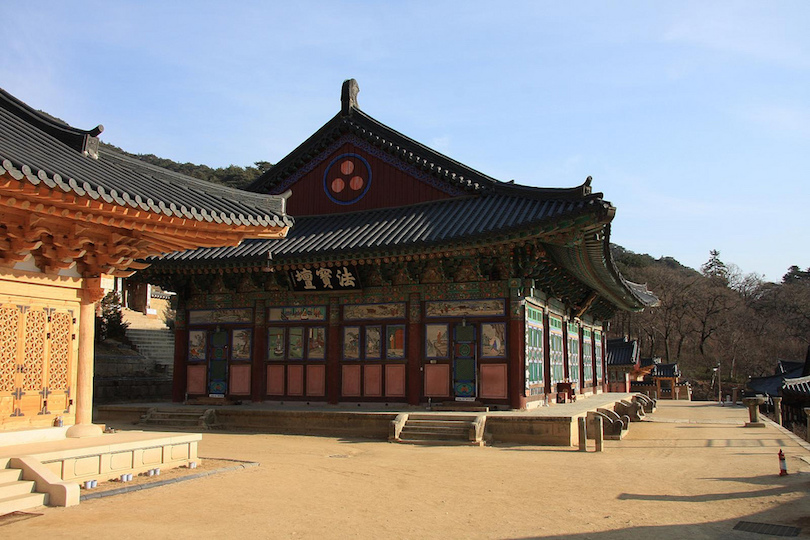
Haeinsa (Temple of Reflection on a Smooth Sea) is one of the most
important Buddhist temples in South Korea. The temple was first built in
802 and rebuilt in the 19th century after Haiensa was burned down in a
fire in 1817. The temple’s greatest treasure however, a complete copy of
the Buddhist scriptures (he Tripitaka Koreana) written on 81,258
woodblocks, survived the fire.
9. Wat Arun

Situated on the Thonburi side of the Chao Phraya River , Wat Arun (“Temple of Dawn”) is one of the oldest and best known landmarks in Bangkok,
Thailand. The temple is an architectural representation of Mount Meru,
the center of the universe in Buddhist cosmology. Despite it’s name, the
best views of Wat Arun are in the evening with the sun setting behind
it.
8. Pha That Luang
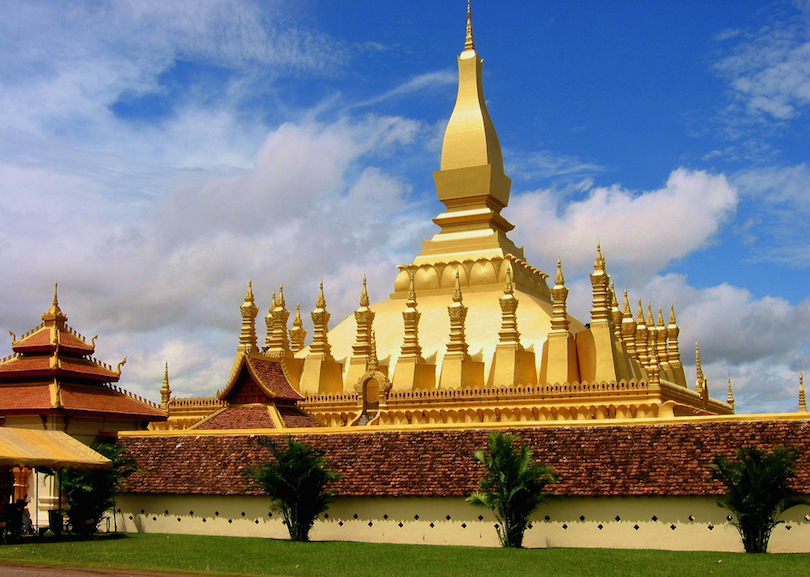 flickr/A_E_P
flickr/A_E_PLocated in Vientiane, Pha That Luang (“Great Stupa in Lao”) is one of the most important monument in Laos.
The stupa has several terraces with each level representing a different
stage of Buddhist enlightenment. The lowest level represents the
material world; the highest level represents the world of nothingness.
Pha That Luang was built in the 16th century on the ruins of an earlier
Khmer temple. The temple was destroyed by a Siamese invasion in 1828,
then later reconstructed by the French in 1931.
7. Jokhang
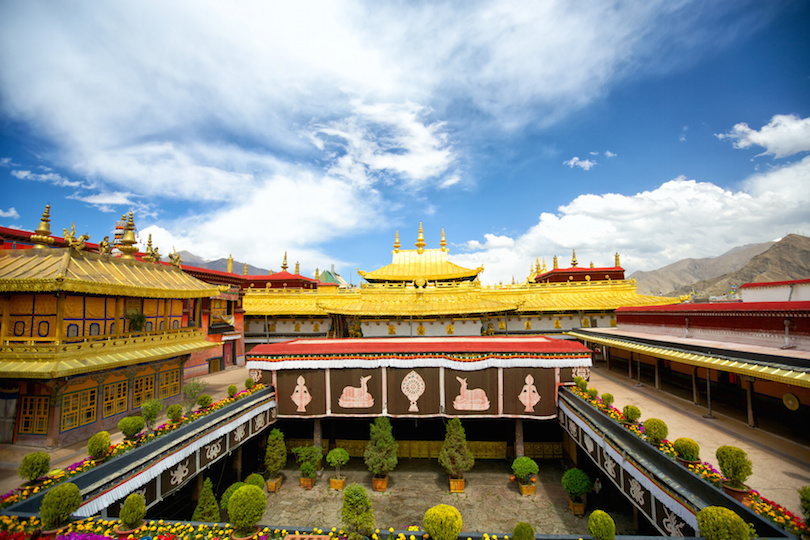
The Jokhang Temple in Lhasa
is the most important sacred site in Tibetan Buddhism attracting
thousands of pilgrims each year. The temple was constructed by King
Songtsän Gampo in the 7th century. The Mongols sacked the Jokhang temple
several times but the building survived. Today the temple complex
covers an area of about 25,000 square meters.
6. Todaiji Temple
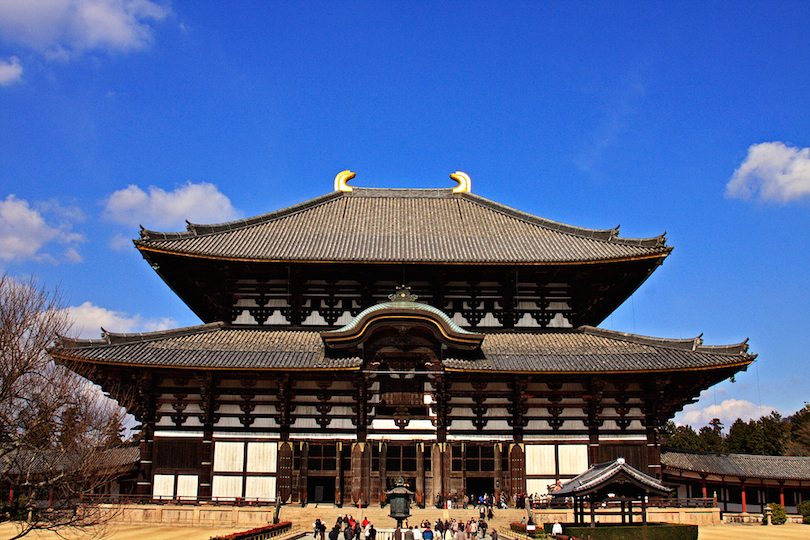 flickr/roybuloy
flickr/roybuloyTodaiji (“Great Eastern Temple”) in Nara is one of the most historically significant and famous Buddhist temples in Japan.
The temple was built in the 8th century by Emperor Shomu as the head
temple of all provincial Buddhist temples of Japan. Today little remains
of the original buildings of Todaiji. The Daibutsuden (“Great Buddha
Hall”), dates for the most part from 1709. It houses one of the largest
Budha statues in Japan and is the worlds largest wooden building, even
though it is only two-thirds the size of the original structure.
5. Boudhanath
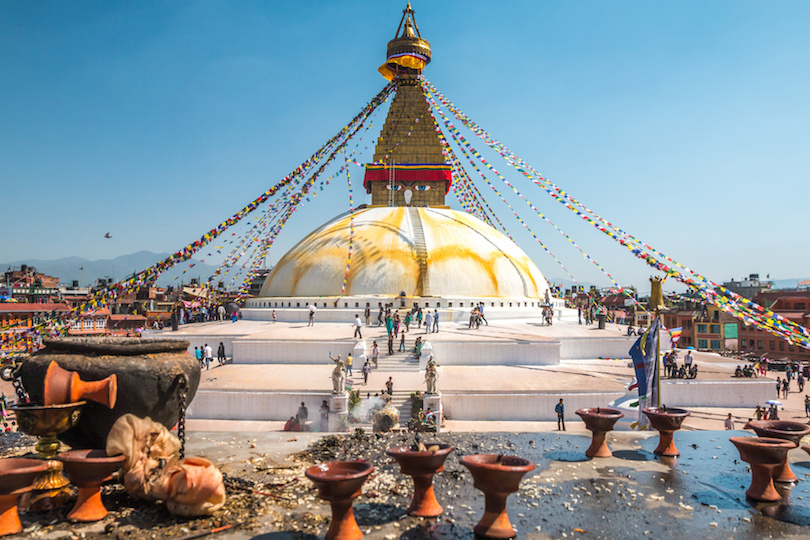
Located in a suburb of Kathmandu,
Boudhanath is one of the largest stupas in the world. It is the center
of Tibetan Buddhism in Nepal and many refugees from Tibet have settled
here in the last few decades. It is probably best known for the Buddha
eyes that are featured on all four sides of the tower. The present stupa
is said to date from the 14th century, after the previous one was
destroyed by Mughal invaders.
4. Mahabodhi Temple
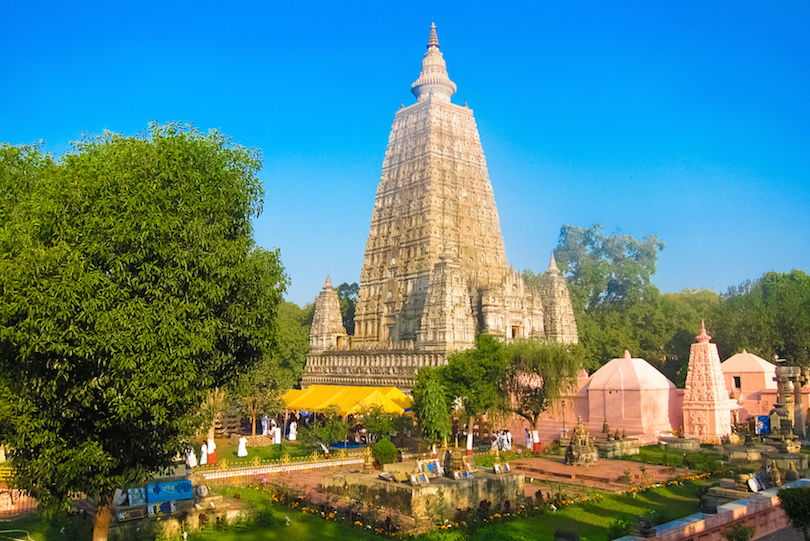
The Mahabodhi (Great Enlightenment) Temple is a Buddhist stupa
located in Bodh Gaya, India. The main complex contains a descendant of
the original Bodhi Tree under which Gautama Buddha gained enlightenment
and is the most sacred place in Buddhism. About 250 years after the
Buddha attained Enlightenment, Emperor Asoka built a temple at the spot.
The present temple dates from the 5th-6th century.
3. Shwedagon Pagoda

The Shwedagon Pagoda (or Golden Pagoda) in Yangon, is the holiest
Buddhist shrine in Burma. The origins of Shwedagon are lost in antiquity
but it is estimated that the Pagoda was first built by the Mon during
the Bagan period, sometime between the 6th and 10th century AD. The
temple complex is full of glittering, colorful stupas but the center of
attention is the 99 meter high (326 feet) high main stupa that is
completely covered in gold.
2. Bagan
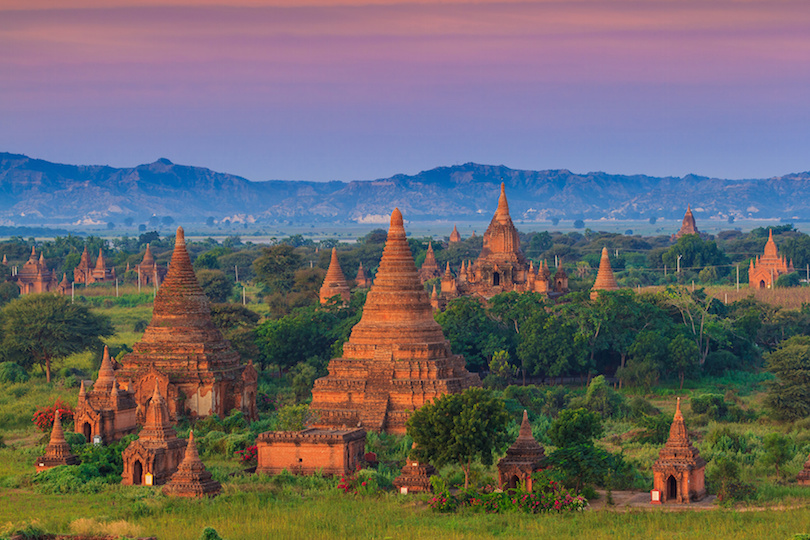
Bagan, also spelled Pagan, on the banks of the Ayerwaddy River, is
home to the largest area of Buddhist temples, pagodas, stupas and ruins
in the world. It was the capital of several ancient kings of Burma who
built perhaps as many as 4,400 temples during the height of the kingdom
(between 1000 and 1200 AD). In 1287, the kingdom fell to the Mongols,
after refusing to pay tribute to Kublai Khan and Bagan quickly declined
as a political center, but continued to flourish as a place of Buddhist
scholarship.
1. Borobudur
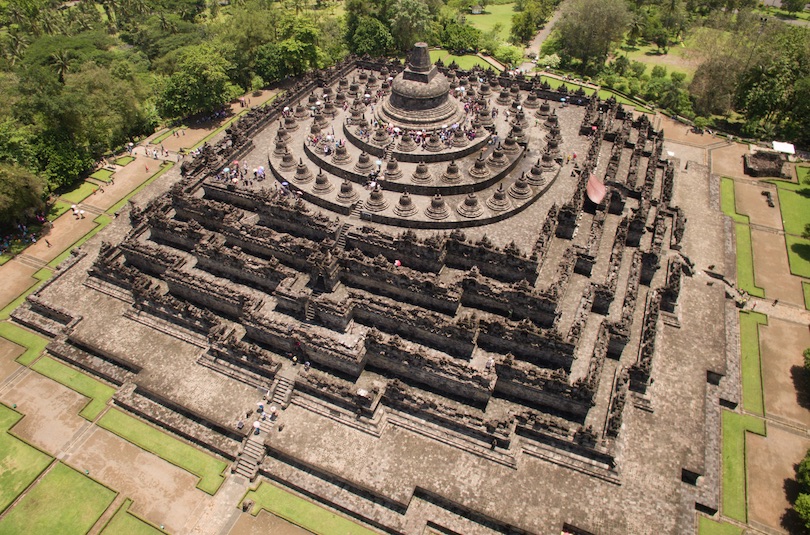
Located on the Indonesian island of Java, 40 km (25 miles) northwest
of Yogyakarta, the Borobudur is the largest and most famous Buddhist
temple in the world. The Borobudur was built over a period of some 75
years in the 8th and 9th centuries by the kingdom of Sailendra, out of
an estimated 2 million blocks of stone. It was abandoned in the 14th
century for reasons that still remain a mystery and for centuries lay
hidden in the jungle under layers of volcanic ash.
19) Classical Catalan-Català clàssic,
Descobriment d’un despert amb univers de consciència (DAOAU)
SN 22,59 (S iii 66)
Anattalakkhana Sutta
- La característica del no-jo -
[anattā · lakkhaṇa]
En aquest famós sutta, Buda exposa per primera vegada el seu ensenyament sobre anatta.
En una ocasió, el Bhagavā s’allotjava a Bārāṇasi, al Deer Grove, a Isipatana. Allà, es va dirigir al grup de cinc monjos:
- Monjos.
- Bhadante, van respondre els monjos. El Bhagavā va dir:
- Rūpa, monjos, és anatta. I si aquesta rūpa fos atta, bhikkhus, aquesta rūpa no es prestaria a la tranquil·litat i es podria [dir] de rūpa: “Que la meva rūpa sigui així, que la meva rūpa no sigui així”. Però és perquè rūpa és un anatta que rūpa es presta a la tranquil·litat i que no es pot [dir] de rūpa: “Que la meva rūpa sigui així, que la meva rūpa no sigui així”.
Vedanā, monjos, és un anatta. I si aquest vedanā fos atta, bhikkhus, aquest vedanā no es prestaria a la tranquil·litat i es podria [dir] de vedanā: “Que el meu vedanà sigui així, que el meu vedanà no sigui així”. Però és perquè vedanā és un anatta que vedanā es presta a la tranquil·litat i que no es pot [dir] de vedanā: “Que el meu vedanà sigui així, que el meu vedanà no sigui així”.
Saññā, monjos, és un anatta. I si aquest saññā fos atta, bhikkhus, aquest saññā no es prestaria a la tranquil·litat i es podria [dir] de saññā: “Que el meu saññā sigui així, que el meu saññā no sigui així”. Però és perquè saññā és una anatta que saññā es presta a la tranquil·litat i que no es pot [dir] de saññā: “Que el meu saññā sigui així, que el meu saññā no sigui així”.
Saṅkhāras, bhikkhus, són anatta. I si aquests saṅkhāras fossin atta, bhikkhus, aquests saṅkhāras no es prestarien a la tranquil·litat i es podria [dir] de saṅkhāras: “Que els meus saṅkhāras siguin així, que els meus saṅkhāras no siguin així”. Però és perquè els saṅkhāras són anatta que els saṅkhāras es presten a la tranquil·litat, i que no es pot [dir] de saṅkhāras: “Que els meus saṅkhāras siguin així, que els meus saṅkhras no siguin així”.
Viññāṇa, monjos, és un anatta. I si aquest viññāṇa fos atta, bhikkhus, aquest viññā nota no es prestaria a la tranquil·litat i es podria [dir] de viññāṇa: “Que el meu viññāṇa sigui així, que el meu viññāṇa no sigui així”. Però és perquè viññāṇa és una anatta que viññāṇa es presta a la tranquil·litat i que no es pot [dir] de viññāṇa: “Que el meu viññāṇa sigui així, que el meu viññāṇa no sigui així”.
Què en penseu, monjos: Rūpa és permanent o anicca?
temporal
- Anicca, Bhanthdhe
- I el que és anicca, és dukkha o sukha? {1}
- Dukkha, Bhante.
- I allò que és anicca, dukkha, per naturalesa subjecte a canvis, és adequat considerar-lo com: ‘Això és meu. Jo sóc això. Aquesta és la meva atta?
- No, Bhante.
- Vedanā és permanent o anicca?
- Anicca, Bhante.
- I això que és anicca, és dukkha o sukha?
- Dukkha, Bhante.
- I allò que és anicca, dukkha, per naturalesa subjecte a canvis, és adequat considerar-lo com: ‘Això és meu. Jo sóc això. Aquesta és la meva atta?
- No, Bhante.
- Saññā és permanent o anicca?
- Anicca, Bhante.
- I això que és anicca, és dukkha o sukha?
- Dukkha, Bhante.
- I allò que és anicca, dukkha, per naturalesa subjecte a canvis, és adequat considerar-lo com: ‘Això és meu. Jo sóc això. Aquesta és la meva atta?
- No, Bhante.
- Els saṅkhāras són permanents o anicca?
- Anicca, Bhante.
- I això que és anicca, és dukkha o sukha?
- I allò que és anicca, dukkha, per naturalesa subjecte a canvis, és adequat considerar-lo com: ‘Això és meu. Jo sóc això. Aquesta és la meva atta?
- No, Bhante.
- Viññāṇa és permanent o anicca?
- Anicca, Bhante.
- I això que és anicca, és dukkha o sukha?
- Dukkha, Bhante.
- I allò que és anicca, dukkha, per naturalesa subjecte a canvis, és adequat considerar-lo com: ‘Això és meu. Jo sóc això. Aquesta és la meva atta?
- No, Bhante.
- Per tant, els bhikkhus, sigui quina sigui la rūpa, ja sigui passada, futura o present, interna o externa, bruta o subtil, inferior o exaltada, llunyana o propera, qualsevol rūpa s’ha de veure yathā · bhūtaṃ amb el paññā adequat d’aquesta manera: ” Això no és meu, no sóc això, això no és el meu atac.
Sigui quin sigui el vedanā, ja sigui passat, futur o present, intern o extern, brut o subtil, inferior o exaltat, llunyà o proper, qualsevol vedanā s’ha de veure yathā · bhūtaṃ amb el paññā adequat d’aquesta manera: “Això no és meu, No sóc això, no és el meu atac.
Sigui quin sigui el saññā, ja sigui passat, futur o present, intern o extern, brut o subtil, inferior o exaltat, llunyà o proper, qualsevol saññā s’ha de veure yathā · bhūtaṃ amb el paññā adequat d’aquesta manera: “Això no és meu, No sóc això, aquest no és el meu atac.
Siguin quins siguin els saṅkhāras, ja siguin passats, futurs o presents, interns o externs, grossos o subtils, inferiors o exaltats, allunyats o propers, qualsevol saṅkhāra s’ha de veure yathā · bhūtaṃ amb el paññā adequat d’aquesta manera: “Això no és meu, No sóc això, no és el meu atac.
Sigui quin sigui el viññāṇa, ja sigui passat, futur o present, intern o extern, brut o subtil, inferior o exaltat, llunyà o proper, qualsevol viññāṇa s’ha de veure yathā · bhūtaṃ amb el paññā adequat d’aquesta manera: “Això no és meu, No sóc això, no és el meu atac.Vist d’aquesta manera, un noble deixeble il·lustrat queda decebut amb Raba, insatisfet amb el dolor, decebut amb la mort, decebut amb els xacres i decebut amb Via. Decebut, es torna emocional. A través de la depressió, se sent alleujat. Amb l’alliberament, isa: “alliberat”. Entén: “El naixement s’ha acabat, es viu la vida bramana, es fa el que s’ha de fer, no hi ha res més per a aquesta existència”.
Això és el que va dir Bhagwar. El grup de cinc monjos que estaven encantats van quedar encantats de les seves paraules.
Quan es va donar aquesta revelació, les ciutadelles del grup de cinc monjos, sense enganxar-se, van ser alliberades de la mort.
20) Classical Cebuano-Klase sa Sugbo,
Pagdiskobre sa Nahigmata nga Usa nga adunay Kamalayan Universe (DAOAU)
SN 22.59 (S iii 66)
Anattalakkhana Sutta
- Ang kinaiya sa wala’y Kaugalingon -
[anattā · lakkhaṇa]
Sa kini bantog kaayo nga sutta, ang Buddha nagpatin-aw sa kauna-unahan nga higayon sa iyang pagpanudlo sa anatta.
Sa us aka okasyon, ang Bhagavā nagpabilin sa Bārāṇasi sa Deer Grove sa Isipatana. Didto, gipunting niya ang grupo sa lima nga bhikkhus:
- Bhikkhus.
- Bhadante, ang mga bhikkhus mitubag. Ang Bhagavā miingon:
- Ang Rūpa, bhikkhus, mao ang anatta. Ug kung kini nga rūpa atta, bhikkhus, kini nga rūpa dili magpahulam sa kaugalingon, ug mahimo kini [masulti] sa rūpa: ‘Himua nga ang akong rūpa ingon, ayaw himoa ang akong rūpa nga ingon niini.’ Apan tungod kay ang rūpa mao ang anatta nga gipahulam ni rūpa ang iyang kaugalingon nga makawang, ug dili kini masulti bahin sa rūpa: ‘Himua ang akong rūpa nga ingon, ayaw himoa ang akong rūpa nga ingon niini.’
Ang Vedanā, bhikkhus, mao ang anatta. Ug kung kini nga vedanā mga atta, bhikkhus, kini nga vedanā dili magpahulam sa iyang kaugalingon, ug mahimo kini iingon sa vedanā: ‘Himua nga ang akong vedanā mao, himoa nga ang akong vedanā dili maingon niini.’ Apan tungod kay ang vedanā mao ang anatta nga gipahulam ni vedanā ang kaugalingon, ug dili kini masulti bahin sa vedanā: ‘Himua nga ingon niini ang akong vedanā, ug dili unta ingon niini ang akong vedanā.’
Ang Saññā, bhikkhus, mao ang anatta. Ug kung kini nga saññā mga atta, bhikkhus, kini nga saññā dili magpahulam, ug mahimo kini [masulti] sa saññā: ‘Himua nga ang akong saññā mao, himoa nga ang akong saññā dili mahimo.’ Apan kini tungod kay ang saññā mao ang anatta nga saññā nagpahulam sa iyang kaugalingon nga mawala, ug dili kini masulti sa saññā: ‘Himua nga ang akong saññā mao, himoa nga ang akong saññā dili ingon niini.’
Saṅkhāras, bhikkhus, mga anatta. Ug kung kini nga mga saṅkhāras mga atta, bhikkhus, kini nga mga saṅkhāras dili magpahulam sa ilang mga kaugalingon sa pagpahulay, ug mahimo kini [giingon] saṅkhāras: ‘Himua nga ang akong mga saṅkhāras mao unta, dili unta ingon niini ang akong mga saṅkhāras.’ Apan tungod kay ang saṅkhāras mga anatta nga saṅkhāras nagpahulam sa ilang mga kaugalingon nga makawang, ug dili kini masulti sa bekhāras: ‘Himua nga ang akong mga saṅkhāras, dili unta ingon niini ang akong mga saṅkhāras.’
Ang Viññāṇa, bhikkhus, mao ang anatta. Ug kung kini nga viññāṇa mga atta, bhikkhus, kini nga viññāṇa dili magpahulam, ug mahimo kini [masulti] sa viññāṇa: ‘Himua ang akong viññāṇa nga ingon, himoa nga ang akong viññāṇa dili ingon niini.’ Apan tungod kay ang viññāṇa usa ka anatta nga gihimugso ni viññāṇa ang iyang kaugalingon nga mobiya, ug dili kini [masulti] bahin sa viññāṇa:
Unsa ang imong hunahuna niini, bhikkhus: permanente o anicca ang Rūpa?
temporaryo
- Anicca, Bhanthdhe
- Ug kung unsa ang anicca, kini ang dukkha o sukha? {1}
- Dukkha, Bhante.
- Ug kana nga anicca, dukkha, sa kinaiya nga mabalhin, angay nga isipa kini ingon: ‘Kini akoa. Ako kini. Kini ang akong atta? ‘
- Dili, Bhante.
- Ang Vedanā permanente o anicca?
- Anicca, Bhante.
- Ug kana diin ang anicca, kini ang dukkha o sukha?
- Dukkha, Bhante.
- Ug kana nga anicca, dukkha, sa kinaiya nga mabalhin, angay nga isipa kini ingon: ‘Kini akoa. Ako kini. Kini ang akong atta? ‘
- Dili, Bhante.
- Ang Saññā permanente o anicca?
- Anicca, Bhante.
- Ug kana nga anicca, kini dukkha o sukha?
- Dukkha, Bhante.
- Ug kana nga anicca, dukkha, sa kinaiya nga mabalhin, angay nga isipa kini ingon: ‘Kini akoa. Ako kini. Kini ang akong atta? ‘
- Dili, Bhante.
- Ang Saṅkhāras permanente o anicca?
- Anicca, Bhante.
- Ug kana diin ang anicca, kini ang dukkha o sukha?
- Ug kana nga anicca, dukkha, sa kinaiya nga mabalhin, angay nga isipa kini ingon: ‘Kini akoa. Ako kini. Kini ang akong atta? ‘
- Dili, Bhante.
- Ang Viññāṇa usa ba permanente o anicca?
- Anicca, Bhante.
- Ug kana nga anicca, kini dukkha o sukha?
- Dukkha, Bhante.
- Ug kana nga anicca, dukkha, sa kinaiya nga mabalhin, angay nga isipa kini ingon: ‘Kini akoa. Ako kini. Kini ang akong atta? ‘
- Dili, Bhante.
- Busa, mga bhikkhus, bisan unsang rūpa, kini kaniadto, umaabot, o karon, sulud o gawas, grabe o maliputon, ubos o gibayaw, halayo o haduol, bisan unsang rūpa makita nga yathā · bhūtaṃ nga adunay tama nga paññā sa niining paagiha: ‘ Kini dili akoa, dili ako kini, dili kini akong atta. ‘
Bisan unsa ang vedanā, kini nangagi, umaabot, o karon, sulud o gawas, grabe o maliputon, ubos o gibayaw, halayo o duul, bisan unsang vedanā makita yathā · bhūtaṃ nga adunay husto nga paññā sa kini nga paagi: ‘Dili kini akoa, Dili ako kini, dili kini ang akong atta. ‘
Bisan unsa ang saññā, kini nangagi, umaabot, o karon, sulud o gawas, kasarangan o maliputon, ubos o gibayaw, halayo o haduol, ang bisan unsang saññā makit-an nga yathā · bhūta proper nga adunay husto nga paññā sa niining paagiha: Dili ako kini, dili kini ang akong atta. ‘
Bisan unsa man ang mga saṅkhāras, nakalabay na, umaabot, o karon, sulud o gawas, grabe o maliputon, ubos o gibayaw, halayo o haduol, bisan unsang mga saṅkhāras makit-an ang yathā · bhūtaṃ nga adunay husto nga paññā sa niining paagiha: ‘Dili kini akoa, Dili ako kini, dili kini ang akong atta. ‘
Bisan unsang viññāṇa, kini mahimo ra, sa umaabot, o karon, sa sulud o sa gawas, grabe o maliputon, ubos o gibayaw, halayo o haduol, bisan unsang viññāṇa makita yathā · bhūtaṃ nga adunay tama nga paññā sa kini nga paagi: ‘Dili kini akoa, Dili ako kini, dili kini ang akong atta. ‘Nakita sa kini nga paagi, ang usa ka nalamdagan nga halangdon nga disipulo nasagmuyo kay Raba, wala matagbaw sa kasakit, nasagmuyo sa kamatayon, nasagmuyo sa mga chakra, ug nasagmuyo sa Via. Nasagmuyo, nahimo siyang emosyonal. Pinaagi sa kamingaw, nahupay siya. Uban sa kalingkawasan, usa: ‘liberated.’ Nakasabut siya: ‘Tapos na ang pagkatawo, nabuhi ang kinabuhi sa Brahmin, kung unsa ang kinahanglan buhaton nahimo na, wala’y uban pa alang sa kini nga pagkabuhi.’
Kini ang giingon ni Bhagwar. Ang grupo sa lima ka monghe nga nalipay nalipay sa iyang gisulti.
Kung gihatag kini nga pagpadayag, ang mga citadel sa grupo sa lima nga monghe, nga wala magpabilin, gipagawas gikan sa kamatayon.
21) Classical Chichewa-Chikale cha Chichewa,
Kupeza Munthu Wodzuka ndi Chilengedwe (AOAOA)
SN 22.59 (S iii 66)
Anattalakkhana Sutta
- Khalidwe Lopanda Kudzikonda -
[anattā · lakkhaṇa]
Mu sutta yotchuka iyi, Buddha amafotokozera koyamba kuphunzitsa kwake pa anatta.
Nthawi ina, a Bhagavā anali kukhala ku Bārāṇasi ku Deer Grove ku Isipatana. Kumeneko, adayankhula ndi gulu la asanu bhikkhus:
- Bhikkhus.
- Bhadante, bhikkhus adayankha. Bhagavā adati:
- Rūpa, bhikkhus, ndi anatta. Ndipo ngati rūpa iyi ikanakhala atta, bhikkhus, rūpa iyi sichikanakhoza kubwereketsa kuti isapumule, ndipo itha [kunenedwa] za rūpa: ‘Lolani rūpa yanga ikhale motere, lolani rūpa yanga isakhale motere.’ Koma ndichifukwa chakuti rūpa ndi anatta pomwe rūpa imadzipereka kuti isamasuke, komanso kuti [sitinganene] za rūpa: ‘Lolani rūpa wanga akhale motere, lolanso rūpa wanga akhale wotere.’
Vedanā, bhikkhus, ndi anatta. Ndipo ngati vedanā uyu anali atta, bhikkhus, vedanā uyu sakanachita kubwereketsa mpumulo, ndipo zitha [kunenedwa] za vedanā: ‘Vedanā wanga akhale motere, asadandawile wanga asakhale choncho.’ Koma ndichifukwa chakuti vedanā ndi anatta kuti vedanā imadzipangitsa kuti ikhale yopumula, komanso kuti [sitinganene] za vedanā: ‘Ledanā wanga akhale motere, mulole kuti vedanā asakhale choncho.’
Saññā, bhikkhus, ndi anatta. Ndipo ngati saññā iyi inali atta, bhikkhus, saññah uyu sakanachita kubwereketsa ndalama, ndipo [a] akanakhoza kunena za saññā: ‘Lolani saññā wanga akhale motere, tiyeni sañuna wanga asakhale motere.’ Koma ndichifukwa chakuti saññā ndi anatta ndiye kuti saññā imadzipereka kuti isamasuke, komanso kuti sitingathe [kunenedwa] za saññā: ‘Lolani sañuna langa likhale motero, mulole sañuna yanga isakhale chonchi.’
Saṅkhāras, bhikkhus, ndi anatta. Ndipo ngati ma saṅkhāras awa anali a atta, bhikkhus, awa saṅkhāras sakanadzabwereketsa ndalama kuti athe kumasuka, ndipo zitha [kunenedwa] za saṅkhāras: ‘Lolani ma saṅkhāra anga akhale motere, asa sahaha anga asakhale otere.’ Koma ndichifukwa choti saṅkhāras ndi anatta pomwe ma saṅkhāras amabwereketsa ndalama kuti athe kumasuka, komanso kuti sangatchulidwe za saṅkhāras kuti: ‘Lolani ma sahāra anga akhale otere, salinso ma saṅkhāra anga akhale otere.’
Viññāṇa, bhikkhus, ndi anatta. Ndipo ngati viññāṇa iyi inali atta, bhikkhus, viññāṇa iyi sichikanatha kubwereketsa kuthekera, ndipo itha [kunenedwa] za viññāṇa: ‘Viññāṇa yanga ikhale motere, lolani viññāṇa yanga ikhale iyi.’ Koma ndichifukwa viññāṇa ndi anatta kuti viññāṇa imadzipereka kuti isamasuke, komanso kuti [sitinganene] za viññāṇa: ‘Let my viññāṇa be thus, let my viññāṇa not be thus.’
Mukuganiza bwanji za izi, bhikkhus: Kodi Rūpa ndiyokhazikika kapena anicca?
zosakhalitsa
- Anicca, Bhanthdhe
- Ndipo chomwe ndi anicca, ndi dukkha kapena sukha? {1}
- Dukkha, Bhante.
- Ndipo zomwe ndi anicca, dukkha, mwachilengedwe zimatha kusintha, ndikoyenera kuzitenga ngati: ‘Izi ndi zanga. Ndine uyu. Uwu ndiye mkhalidwe wanga? ‘
- Ayi, Bhante.
- Vedanā ndiwokhazikika kapena anicca?
- Anicca, Bhante.
- Ndipo zomwe ndi anicca, ndi dukkha kapena sukha?
- Dukkha, Bhante.
- Ndipo zomwe ndi anicca, dukkha, mwachilengedwe zimatha kusintha, ndikoyenera kuzitenga ngati: ‘Izi ndi zanga. Ndine uyu. Uwu ndiye mkhalidwe wanga? ‘
- Ayi, Bhante.
- Kodi Saññā ndiyokhazikika kapena anicca?
- Anicca, Bhante.
- Ndipo zomwe ndi anicca, ndi dukkha kapena sukha?
- Dukkha, Bhante.
- Ndipo zomwe ndi anicca, dukkha, mwachilengedwe zimatha kusintha, ndikoyenera kuzitenga ngati: ‘Izi ndi zanga. Ndine uyu. Uwu ndiye mkhalidwe wanga? ‘
- Ayi, Bhante.
- Kodi a Saṅkhāras ndi okhazikika kapena anicca?
- Anicca, Bhante.
- Ndipo zomwe ndi anicca, ndi dukkha kapena sukha?
- Ndipo zomwe ndi anicca, dukkha, mwachilengedwe zimatha kusintha, ndikoyenera kuzitenga ngati: ‘Izi ndi zanga. Ndine uyu. Uwu ndiye mkhalidwe wanga? ‘
- Ayi, Bhante.
- Kodi Viññāṇa ndiyokhazikika kapena anicca?
- Anicca, Bhante.
- Ndipo chomwe ndi anicca, ndi dukkha kapena sukha?
- Dukkha, Bhante.
- Ndipo zomwe ndi anicca, dukkha, mwachilengedwe zimatha kusintha, ndikoyenera kuzitenga ngati: ‘Izi ndi zanga. Ndine uyu. Uwu ndiye mkhalidwe wanga? ‘
- Ayi, Bhante.
- Chifukwa chake, bhikkhus, kaya rūpa, kaya yapita, yamtsogolo, kapena yapano, yamkati kapena yakunja, yayikulu kapena yochenjera, yotsika kapena yokwezeka, kutali kapena pafupi, rūpa iliyonse imawoneka yathā · bhūtaṃ ndi paññā yoyenera motere: ‘ Izi si zanga, sindine izi, si Atta wanga. ‘
Chilichonse cha vedanā, kaya chapita kale, chamtsogolo, kapena cham’kati, chakunja kapena chobisika, chotsika kapena chokweza, kutali kapena pafupi, vedanā iliyonse iyenera kuwonedwa yathā · bhūtaṃ ndi paññā yoyenera motere: ‘Izi sizanga, Ine sindine ichi, ichi si chikhalidwe changa. ‘
Kaya saññā, kaya yapita, yamtsogolo, kapena yapano, yamkati kapena yakunja, yayikulu kapena yonyenga, yotsika kapena yokwezeka, kutali kapena pafupi, saññā iliyonse imawoneka yathā · bhūtaṃ ndi paññā yoyenera motere: ‘Izi sizanga, Ine sindine ichi, ichi si chikhalidwe changa. ‘
Kaya saṅkhāras, akhale akale, amtsogolo, kapena apano, amkati kapena akunja, owopsa kapena obisika, otsika kapena okwezedwa, kutali kapena pafupi, saṅkhāras zilizonse ziyenera kuwonedwa yathā · bhūtaṃ ndi paññā yoyenera motere: ‘Izi sizanga, Ine sindine ichi, ichi si chikhalidwe changa. ‘
Chilichonse viññāṇa, kaya chapita kale, chamtsogolo, kapena cham’kati, chakunja kapena chobisika, chotsika kapena chokweza, kutali kapena pafupi, viññāṇa iliyonse imawoneka yathā · bhūtaṃ ndi paññā yoyenera motere: ‘Izi sizanga, Ine sindine ichi, ichi si chikhalidwe changa. ‘Kuwonedwa motere, wophunzira wodziwikiratu wakhumudwitsidwa ndi Raba, wosakhutira ndi zowawa, wokhumudwitsidwa ndi imfa, wokhumudwitsidwa ndi chakras, ndikukhumudwitsidwa ndi Via. Wokhumudwa, amakhala wokhumudwa. Kupyolera mu kukhumudwa, amamasulidwa. Ndi kumasulidwa, isa: ‘kumasulidwa.’ Amamvetsetsa: ‘Kubadwa kwatha, moyo wa Brahmin umakhala, zomwe zikuyenera kuchitika zachitika, palibe china chilichonse chakukhalaku.’
Izi ndi zomwe Bhagwar adanena. Gulu la amonke asanu omwe anasangalala nalo mawu ake.
Pamene vumbulutso ili lidaperekedwa, nyumba zachifumu za gulu la amonke asanu, osakakamira, adamasulidwa kuimfa.
22) Classical Chinese (Simplified)-古典中文(简体),
认识宇宙觉醒者(DAOAU)
SN 22.59(S iii 66)
Anattalakkhana Sutta
—没有自我的特征—
[anattā·lakkhaṇa]
在这个非常著名的佛经中,佛陀首次阐述了他对佛陀的教导。
有一次,巴哈瓦(Bhagavā)住在伊西帕塔纳(Isipatana)迪尔格罗夫(Deer Grove)的巴拉拉西(Bārāṇasi)。在那儿,他向五个比丘克人致词:
–比克胡斯。
–比哈德(Bhikkhus)回答说。巴哈瓦说:
–比丘(Rhikkhus)鲁帕(Rūpa)是阿纳塔(anata)。如果这个茹阿帕(bhikkhus)是依附的,那么这个茹阿帕就不会让自己感到不适,它可以说成茹阿帕:“让我的茹阿像这样,让我茹阿不像这样。”但这是因为rūpa是anatta使rūpa感到自在,而不能说rūpa:“让我的rūpa这样,让我的rūpa不这样。”
比丘(Bhikkhus)吠陀那(Vedana)是anatta。如果比达古斯(Bhikkhus)附加了这个吠陀,那么这个吠陀就不会自我放松,它可以说是吠陀:“让我的吠陀这样,不要让我的吠陀那样。”但这是因为vedanā是一种anatta,使vedanā能够缓解不适,并且不能说vedanā:“让我的vedanā成为这样,让我的vedanā成为这样。”
比丘(Sahiñā),比丘(Bhikkhus),是anatta。如果这个saññā是attahi,比丘斯,这个saññā不会让自己放松,它可以说saññā:“让我的saññā成为,让我的saññā成为这样。”但这是因为saññā是anatta使得saññā能够使自己放松,并且不能说saññā:“让我的saññā成为这样,让我的saññā成为这样。”
Sahikhāras,bhikkhus是anatta。如果这些saṅkhāras是比丘的附加物,这些saṅkhāras就不会让自己放松,这可以说saṅkhāras:“让我的saṅkhāras这样,让我的saṅkhāras不再这样。”但这是因为saṅkhāras是anatta,所以saṅkhāras会自娱自乐,而不能说saṅkhāras:“让我的saṅkhāras这样,不要让我的saṅkhāras这样。”
比丘的比尼亚(Viññāṇa)是anatta。如果比尼亚古斯(Bhikkhus)拥有这种viññāṇa,那么这种viññāṇa就不会自生自灭,它可以说是viññāṇa:“让我的viññāṇa如此,让我的viññāṇa不再如此。”但这是因为viññāṇa是一种anatta,使viññāṇa能够缓解疾病,并且不能说viññāṇa:“让我的viññāṇa成为这样,让我的viññāṇa成为这样。”
比克胡斯,您对此有何看法:鲁帕是永久人还是阿尼卡人?
临时
–阿尼卡(Bhanthdhe)
–而这就是anicca,是dukkha还是sukha?{1}
– Dhankha,Bhante。
–而本质上随时可能发生变化的anicca,dukkha,是否应将其视为:“这是我的。我就是这个这是我的atta吗?
–不,Bhante。
–Vedanā是永久人还是阿尼卡人?
– Anicca,Bhante。
–那就是阿尼卡,是dukkha还是sukha?
– Dhankha,Bhante。
–而本质上可能会发生变化的anicca,dukkha,是否应将其视为:“这是我的。我就是这个这是我的atta吗?
–不,Bhante。
–Saññā是永久人还是阿尼卡人?
– Anicca,Bhante。
–那就是阿尼卡,是dukkha还是sukha?
– Dhankha,Bhante。
–而本质上可能会发生变化的anicca,dukkha,是否应将其视为:“这是我的。我就是这个这是我的atta吗?
–不,Bhante。
–Saṅkhāras是永久人还是阿尼卡人?
– Anicca,Bhante。
–那就是阿尼卡,是dukkha还是sukha?
–而本质上可能会发生变化的anicca,dukkha,是否应将其视为:“这是我的。我就是这个这是我的atta吗?
–不,Bhante。
–维尼亚(Viññāṇa)是永久人还是古怪人?
– Anicca,Bhante。
–那就是阿尼卡,是dukkha还是sukha?
– Dhankha,Bhante。
–而本质上可能会发生变化的anicca,dukkha,是否应将其视为:“这是我的。我就是这个这是我的atta吗?
–不,Bhante。
–因此,无论过去,将来或现在,内部或外部,内部或外部,总体或微妙,劣等或崇高,远近,无论比丘是什么比丘,都应以适当的帕尼亚语以任何方式将其视为雅塔·帕丘塔:这不是我的,我不是这个,这不是我的atta。
不论过去,将来或现在,内部或外部,总体或微妙,劣等或崇高,远近的任何吠陀,都应以适当的方式将“吠陀”视为“吠陀”:“这不是我的,我不是这个,这不是我的专长。
无论过去,将来或现在,内部或外部,总体或微妙,劣等或尊贵,远近,无论什么saññā,都应以适当的方式将“yathā·bhūtaṃ”视为“yathā·bhūtaṃ”:“这不是我的,我不是这个,这不是我的专长。
不论任何saṅkhāras,无论是过去,将来还是现在,无论是内部的还是外部的,总的或微妙的,劣等的或崇高的,无论远近,都应以适当的方式将任何saṅkhāras视为yathā·bhūtaṃ:我不是这个,这不是我的专长。
不论过去,将来或现在,内部或外部,总体或微妙,劣等或尊贵的远古或远古的Viññāvia,都应以适当的方式将任何Viññāṇa看成是“yathā·bhūtaṃ”:“这不是我的,我不是这个,这不是我的专长。这样看来,一个开明的贵族门徒对拉巴(Raba)感到失望,对痛苦不满意,对死亡感到失望,对脉轮感到失望,对维亚(Via)感到失望。 失望了,他变得情绪化了。 通过抑郁,他松了一口气。 有了解放,isa就是:“解放了”。 他明白:“出生结束了,婆罗门生活了,需要做的事情已经完成,这种存在没有别的。”
这就是巴格瓦尔所说的。 五个高兴的僧侣对他的话感到高兴。
得到这个启示后,五名僧侣的城堡,不粘手,从死亡中解脱出来。
23) Classical Chinese (Traditional)-古典中文(繁體),
認識宇宙覺醒者(DAOAU)
SN 22.59(S iii 66)
Anattalakkhana Sutta
—沒有自我的特徵—
[anattā·lakkhaṇa]
在這個非常著名的佛經中,佛陀首次闡述了他對佛陀的教導。
有一次,巴哈瓦(Bhagavā)住在伊西帕塔納(Isipatana)迪爾格羅夫(Deer Grove)的巴拉拉西(Bārāṇasi)。在那兒,他向五個比丘克人致詞:
–比克胡斯。
–比哈德(Bhikkhus)回答說。巴哈瓦說:
–比丘(Rhikkhus)魯帕(Rūpa)是阿納塔(anata)。如果這個茹阿帕(bhikkhus)是依附的,那麼這個茹阿帕就不會讓自己放鬆,它可以說成茹阿帕:“讓我的茹阿像這樣,讓我茹阿不像這樣。”但這是因為rūpa是anatta使rūpa感到自在,而不能說rūpa:“讓我的rūpa這樣,讓我的rūpa不這樣。”
比丘(Bhikkhus)吠陀那(Vedana)是anatta。如果比達古斯(Bhikkhus)貼上了這種吠陀,那吠陀就不會放任自流,它可以說是吠陀:“讓我的吠陀這樣,不要讓我的吠陀那樣。”但這是因為vedanā是一種anatta,使vedanā能夠緩解不適,並且不能說vedanā:“讓我的vedanā成為這樣,讓我的vedanā成為這樣。”
比丘(Sahiñā),比丘(Bhikkhus),是anatta。如果這個saññā是attahi,比丘斯,這個saññā不會使自己放鬆,它可以說saññā:“讓我的saññā成為,讓我的saññā成為這樣。”但這是因為saññā是anatta使得saññā能夠緩解疾病,並且不能說saññā:“讓我的saññā成為這樣,讓我的saññā成為這樣。”
Sahikhāras,bhikkhus是anatta。如果這些saṅkhāras是比丘的附加物,這些saṅkhāras就不會讓自己放鬆,這可以說saṅkhāras:“讓我的saṅkhāras這樣,讓我的saṅkhāras不再這樣。”但這是因為saṅkhāras是anatta,所以saṅkhāras會自娛自樂,而不能說saṅkhāras:“讓我的saṅkhāras這樣,不要讓我的saṅkhāras這樣。”
比丘的比尼亞(Viññāṇa)是anatta。如果比尼亞古斯(Bhikkhus)擁有這種viññāṇa,那麼這種viññāṇa就不會自生自滅,它可以說是viññāṇa:“讓我的viññāṇa如此,讓我的viññāṇa不再這樣。”但這是因為viññāṇa是一種anatta,使viññāṇa能夠緩解疾病,並且不能說viññāṇa:“讓我的viññāṇa成為這樣,讓我的viññāṇa成為這樣。”
比克胡斯,您對此有何看法:魯帕是永久人還是阿尼卡人?
臨時
–阿尼卡(Bhanthdhe)
–而這就是anicca,是dukkha還是sukha?{1}
– Dhankha,Bhante。
–而本質上隨時可能發生變化的anicca,dukkha,是否應將其視為:“這是我的。我就是這個這是我的atta嗎?
–不,Bhante。
–Vedanā是永久人還是阿尼卡人?
– Anicca,Bhante。
–那就是阿尼卡,是dukkha還是sukha?
– Dhankha,Bhante。
–而本質上可能會發生變化的anicca,dukkha,是否應將其視為:“這是我的。我就是這個這是我的atta嗎?
–不,Bhante。
–Saññā是永久人還是阿尼卡人?
– Anicca,Bhante。
–那就是阿尼卡,是dukkha還是sukha?
– Dhankha,Bhante。
–而本質上可能會發生變化的anicca,dukkha,是否應將其視為:“這是我的。我就是這個這是我的atta嗎?
–不,Bhante。
–Saṅkhāras是永久人還是阿尼卡人?
– Anicca,Bhante。
–那就是阿尼卡,是dukkha還是sukha?
–而本質上隨時可能發生變化的anicca,dukkha,是否應將其視為:“這是我的。我就是這個這是我的atta嗎?
–不,Bhante。
–維尼亞(Viññāṇa)是永久人還是古怪人?
– Anicca,Bhante。
–那就是阿尼卡,是dukkha還是sukha?
– Dhankha,Bhante。
–而本質上可能會發生變化的anicca,dukkha,是否應將其視為:“這是我的。我就是這個這是我的atta嗎?
–不,Bhante。
–因此,無論過去,將來或現在,內部或外部,內部或外部,總體或微妙,劣等或崇高,遠近,無論比丘是什麼比丘,都應以適當的帕尼亞語以任何方式將其視為雅塔·帕丘塔:這不是我的,我不是這個,這不是我的atta。
不論過去,將來或現在,內部或外部,內部或外部,總體或微妙,劣等或崇高,遠近的任何吠陀,都應以這種方式以適當的方式來看待任何吠陀:“這不是我的,我不是這個,這不是我的專長。
不論過去,將來或現在,內部或外部,整體或微妙,劣等或尊貴,遠近,無論什麼saññā,都應以適當的方式將“yathā·bhūtaṃ”看成是“’這不是我的,我不是這個,這不是我的專長。
不論任何saṅkhāras,無論是過去,將來還是現在,無論是內部的還是外部的,總的或微妙的,劣等的或崇高的,無論遠近,都應以適當的方式將任何saṅkhāras視為yathā·bhūtaṃ:“這不是我的,我不是這個,這不是我的專長。
無論過去,將來或現在,內部或外部,內部或外部,整體或微妙,劣等或尊貴的遠古或遠古的Viññāṇa,都應以這種方式以適當的Paññā來看待任何Viññāṇa:“這不是我的,我不是這個,這不是我的專長。這樣看來,一個開明的貴族門徒對拉巴(Raba)感到失望,對痛苦不滿意,對死亡感到失望,對脈輪感到失望,對維亞(Via)感到失望。 失望了,他變得情緒化了。 通過抑鬱,他鬆了一口氣。 有了解放,isa就是:“解放了”。 他明白:“出生結束了,婆羅門生活了,需要做的事情已經完成,這種存在沒有別的。”
這就是巴格瓦爾所說的。 五個高興的僧侶對他的話感到高興。
得到這個啟示後,五名僧侶的城堡,不粘手,從死亡中解脫出來。
24) Classical Corsican-Corsa Corsicana,
Scuperta di Un Svegliu cù l’Universu di Sensibilizazione (DAOAU)
SN 22.59 (S iii 66)
Anattalakkhana Sutta
- A caratteristica di no-Self -
[anattā · lakkhaṇa]
In questu sutta assai famosu, u Buddha espone per a prima volta u so insegnamentu nantu à anatta.
In una occasione, u Bhagavā stava in Bārāṇasi in u Deer Grove in Isipatana. Quì, s’hè indirizzatu à u gruppu di cinque bhikkhus:
- Bhikkhus.
- Bhadante, risposenu i Bhikkhus. U Bhagavā hà dettu:
- Rūpa, bhikkhus, hè anatta. È sì stu rūpa fussi atta, bhikkhus, questu rūpa ùn si prestaria micca à a malatia, è si puderia [dì] di rūpa: “Chì a mo rūpa sia cusì, chì a mo rūpa ùn sia micca cusì.” Ma hè perchè rūpa hè un anatta chì rūpa si presta à disassine, è chì ùn si pò micca [dì] di rūpa: “Chì a mo rūpa sia cusì, chì a mo rūpa ùn sia micca cusì.”
Vedanā, bhikkhus, hè anatta. E se stu vedanā fussi atta, bhikkhus, questu vedanā ùn si presterebbe micca à a malattia, è si puderia [dì] di vedanā: “Chì u mo vedanà sia cusì, chì u mo vedanà ùn sia micca cusì.” Ma hè perchè vedanā hè un anatta chì vedanā si presta à disassicurassi, è chì ùn si pò [dì] di vedanā: “Chì u mo vedanà sia cusì, chì u mo vedanà ùn sia micca cusì.”
Saññā, bhikkhus, hè anatta. È sì stu saññā era atta, bhikkhus, questu saññā ùn si presterebbe micca à a malattia, è si puderia [dì] di saññā: “Chì u mo saññā sia cusì, chì u mo saññā ùn sia micca cusì.” Ma hè perchè saññā hè un anatta chì saññā si presta à a malattia, è chì ùn si pò micca [dì] di saññā: “Chì u mo saññā sia cusì, chì u mo saññā ùn sia micca cusì.”
Saṅkhāras, bhikkhus, sò anatta. È sì sti saṅkhāra fussinu atta, bhikkhus, sti saṅkhāras ùn si prestarianu micca à a malattia, è si puderia [dì] di saṅkhāras: “Chì i mo saṅkhāras sianu cusì, chì i mo saṅkhāras ùn sianu micca cusì. Ma hè perchè i saṅkhāras sò anatta chì i saṅkhāras si prestanu à a malattia, è chì ùn si pò micca [dì] di saṅkhāras: “Chì i mo saṅkhāras sianu cusì, chì i mo saṅkhāras ùn sianu micca cusì.”
Viññāṇa, bhikkhus, hè anatta. È sì stu viññāṇa fussi atta, bhikkhus, questu viññāṇa ùn si presterebbe micca à a malatia, è si puderia [dì] di viññāṇa: “Chì a mo viññāṇa sia cusì, chì a mo viññāṇa ùn sia micca cusì.” Ma hè perchè viññāṇa hè una anatta chì viññāṇa si presta à a malattia, è chì ùn si pò micca [dì] di viññāṇa: “Chì a mo viññāṇa sia cusì, chì a mo viññāṇa ùn sia micca cusì.”
Chì ne pensi, bhikkhus: hè Rūpa permanente o anicca?
pruvisoriu
- Anicca, Bhanthdhe
- È quellu chì hè anicca, hè dukkha o sukha? {1}
- Dukkha, Bhante.
- È ciò chì hè anicca, dukkha, per natura soggettu à cambiamenti, hè propiu di cunsiderallu cum’è: “Questu hè u mo. Sò questu. Questu hè u mo atta?
- Innò, Bhante.
- Vedanā hè permanente o anicca?
- Anicca, Bhante.
- È quellu chì hè anicca, hè dukkha o sukha?
- Dukkha, Bhante.
- È ciò chì hè anicca, dukkha, per natura soggettu à cambiamenti, hè propiu di cunsiderallu cum’è: “Questu hè u mo. Sò questu. Questu hè u mo atta?
- Innò, Bhante.
- Saññā hè permanente o anicca?
- Anicca, Bhante.
- È quellu chì hè anicca, hè dukkha o sukha?
- Dukkha, Bhante.
- È ciò chì hè anicca, dukkha, per natura soggettu à cambiamenti, hè propiu di cunsiderallu cum’è: “Questu hè u mo. Sò questu. Questu hè u mo atta?
- Innò, Bhante.
- I Saṅkhāras sò permanenti o anicca?
- Anicca, Bhante.
- È quellu chì hè anicca, hè dukkha o sukha?
- È ciò chì hè anicca, dukkha, per natura soggettu à cambiamenti, hè propiu di cunsiderallu cum’è: “Questu hè u mo. Sò questu. Questu hè u mo atta?
- Innò, Bhante.
- Viññāṇa hè permanente o anicca?
- Anicca, Bhante.
- È quellu chì hè anicca, hè dukkha o sukha?
- Dukkha, Bhante.
- È ciò chì hè anicca, dukkha, per natura soggettu à cambiamenti, hè propiu di cunsiderallu cum’è: “Questu hè u mo. Sò questu. Questu hè u mo atta?
- Innò, Bhante.
- Dunque, bhikkhus, qualunque sia rūpa, sia passatu, futuru o presente, internu o esternu, grossu o sutile, inferiore o esaltatu, luntanu o vicinu, qualsiasi rūpa deve esse vistu yathā · bhūtaṃ cun paññā adatta in questu modu: ” Questu ùn hè micca u mo, ùn sò micca questu, questu ùn hè micca u mo atta. ‘
Qualunque sia vedanā, sia passatu, futuru o presente, internu o esternu, grossu o sutile, inferiore o esaltato, lontano o vicino, qualsiasi vedanā deve essere visto yathā · bhūtaṃ con paññā adeguato in questo modo: “Questu ùn hè micca u mo, Ùn sò micca questu, questu ùn hè micca u mo atta. ‘
Qualunque sia saññā, sia passatu, futuru o presente, internu o esternu, grossu o sutile, inferiore o esaltato, lontano o vicino, qualsiasi saññā deve esse visto yathā · bhūtaṃ cun paññā adeguatu in questu modu: “Questu ùn hè micca u mo, Ùn sò micca questu, questu ùn hè micca u mo atta. ‘
Qualunque sia saṅkhāras, sia elli passati, futuri o presenti, interni o esterni, grossi o sutili, inferiori o esaltati, lontani o vicini, qualsiasi saṅkhāras sò da vede yathā · bhūtaṃ cun paññā adeguatu in questu modu: “Questu ùn hè micca u mo, Ùn sò micca questu, questu ùn hè micca u mo atta. ‘
Qualunque sia viññāṇa, ch’ellu sia passatu, futuru o presente, internu o esternu, grossu o sutile, inferiore o esaltatu, luntanu o vicinu, ogni viññāṇa deve esse vistu yathā · bhūtaṃ cun paññā propiu in questu modu: “Questu ùn hè micca mine, Ùn sò micca questu, questu ùn hè micca u mo atta. ‘Vistu cusì, un nobile discepulu illuminatu hè scuntentu di Raba, scuntentu di u dulore, scuntentu di a morte, scuntentu di i chakra, è scuntu di Via. Dilusu, diventa emotivu. Attraversu a depressione, hè allevatu. Cù a liberazione, isa: “liberatu”. Capisce: “A nascita hè finita, a vita Brahmin hè vissuta, ciò chì deve esse fattu hè fattu, ùn ci hè nunda altru per questa esistenza.”
Hè ciò chì Bhagwar hà dettu. U gruppu di cinque monachi chì eranu cuntenti eranu cuntenti di e so parolle.
Quandu sta rivelazione hè stata data, e citatelle di u gruppu di cinque monaci, senza attaccà, sò stati liberati da a morte.
25) Classical Croatian-Klasična hrvatska,
Otkriće Probuđenog sa svemirom svjesnosti (DAOAU)
SN 22,59 (S iii 66)
Anattalakkhana Sutta
- obilježje ne-ja -
[anattā · lakkhaṇa]
U ovoj vrlo poznatoj sutti, Buda prvi put iznosi svoje učenje o anatti.
Jednom je prigodom Bhagavā boravio u Bārāṇasiju u Jelenovom gaju u Isipatani. Tamo se obratio grupi od pet monahinja:
- Bhikkhus.
- Bhadante, odgovorili su monah. Bhagavā je rekao:
- Rūpa, monah, je anatta. A da je ova rūpa Atta, monahinje, ova rūpa se ne bi mogla smiriti, a moglo bi se [reći] i za rūpu: ‘Neka moja rūpa bude takva, neka moja rūpa ne bude takva.’ Ali zato što je rūpa anatta, rūpa se može ometati i što se to ne može [reći] za rūpu: ‘Neka moja rūpa bude takva, neka moja rūpa ne bude takva.’
Vedanā, monahinja, je anatta. I kad bi ova vedana bila Atta, monahinje, ova bi se vedana mogla pozabaviti i moglo bi se [reći] za vedanu: ‘Neka moja vedana bude takva, neka moja vedana ne bude takva.’ Ali zato što je vedanā anatta, ona se može smiriti i što se za nju ne može reći: ‘Neka moja vedana bude takva, neka moja vedana ne bude takva.’
Saññā, monah, je anatta. I kad bi ova sañña bila Atta, monahinje, ta se sñña ne bi mogla smiriti, a za saññu bi se moglo [reći]: ‘Neka moja sññā bude takva, neka moja sññā ne bude takva. Ali to je zato što je saññā anatta, što se sññā može smiriti i što se za saññu ne može [reći]: ‘Neka moja saññā bude takva, neka moja sññā ne bude takva.’
Saṅkhāras, monahinje, su anatta. A da su ti sakhrerashi Atta, monahinje, ti se sindžeri ne bi mogli smiriti, a za sakhrase bi se [moglo reći]: ‘Neka moji sṅkhāras budu takvi, neka moji sṅkhāras ne budu takvi.’ Ali zato što su saṅkhāre anatta, saṅkhāre se mogu odahnuti i što se to [reći] ne može za saṅkhāras: ‘Neka moji saṅkhāras budu takvi, neka moji saṅkhāras ne budu takvi.’
Viññāṇa, monah, je anatta. A da je ova viññāṇa Atta, monahinje, ova viññāṇa se ne bi mogla smiriti, a moglo bi se [reći] i o viññāṇa: ‘Neka moja viññāṇa bude takva, neka moja viññāṇa ne bude takva.’ Ali zato što je viññāṇa anatta, viññāṇa se odaje nelagodnosti i što se ne može [reći] za viññāṇa: ‘Neka moja viññāṇa bude takva, neka moja viññāṇa ne bude takva.’
Što mislite o ovome, monahinje: je li Rupa trajna ili anicca?
privremeni
- Anicca, Bhanthdhe
- A ono što je anicca, je li dukkha ili sukha? {1}
- Dukkha, Bhante.
- A ono što je anicca, dukkha, po prirodi podložno promjenama, je li ispravno smatrati to: ‘Ovo je moje. Ja sam ovo. Ovo je moj Atta? ‘
- Ne, Bhante.
- Je li Vedanā trajna ili anicca?
- Anicca, Bhante.
- A ono što je anicca, je li dukkha ili sukha?
- Dukkha, Bhante.
- A ono što je anicca, dukkha, po prirodi podložno promjenama, je li ispravno smatrati to: ‘Ovo je moje. Ja sam ovo. Ovo je moj Atta? ‘
- Ne, Bhante.
- Je li Saññā trajna ili anicca?
- Anicca, Bhante.
- A ono što je anicca, je li dukkha ili sukha?
- Dukkha, Bhante.
- A ono što je anicca, dukkha, po prirodi podložno promjenama, je li ispravno smatrati to: ‘Ovo je moje. Ja sam ovo. Ovo je moj Atta? ‘
- Ne, Bhante.
- Jesu li Saṅkhāras trajni ili anicca?
- Anicca, Bhante.
- A ono što je anicca, je li dukkha ili sukha?
- A ono što je anicca, dukkha, po prirodi podložno promjenama, je li ispravno smatrati to: ‘Ovo je moje. Ja sam ovo. Ovo je moj Atta? ‘
- Ne, Bhante.
- Je li Viññāṇa trajna ili anicca?
- Anicca, Bhante.
- A ono što je anicca, je li dukkha ili sukha?
- Dukkha, Bhante.
- A ono što je anicca, dukkha, po prirodi podložno promjenama, je li ispravno smatrati to: ‘Ovo je moje. Ja sam ovo. Ovo je moj Atta? ‘
- Ne, Bhante.
- Stoga, monahinje, bez obzira na rupu, bilo prošlost, budućnost ili sadašnjost, unutarnju ili vanjsku, grubu ili suptilnu, inferiornu ili uzvišenu, daleku ili blizu, bilo koju rupu treba vidjeti yathā · bhūtaṃ s odgovarajućim paññā na ovaj način: ‘ Ovo nije moje, nisam ovo, ovo nije moj napadač. ‘
Bez obzira na vedanu, bila ona prošla, buduća ili sadašnja, unutarnja ili vanjska, gruba ili suptilna, inferiorna ili uzvišena, daleka ili blizu, bilo koju vedanu treba vidjeti yathā · bhūtaṃ s odgovarajućim paññā na ovaj način: ‘Ovo nije moje, Ja nisam ovo, ovo nije moj napadač. ‘
Bez obzira na saññu, bilo prošlost, budućnost ili sadašnjost, unutarnju ili vanjsku, grubu ili suptilnu, inferiornu ili uzvišenu, daleku ili blisku, bilo koju sññu treba vidjeti yathā · bhūtaṃ s odgovarajućom paññom na ovaj način: ‘Ovo nije moje, Ja nisam ovo, ovo nije moj napadač. ‘
Bez obzira na saṅkhāre, bile one prošle, buduće ili sadašnje, unutarnje ili vanjske, grube ili suptilne, inferiorne ili uzvišene, daleke ili bliske, bilo koje sṅkhāre treba vidjeti yathā · bhūtaṃ s odgovarajućim paññama na ovaj način: ‘Ovo nije moje, Ja nisam ovo, ovo nije moj napadač. ‘
Kakva god viññāṇa, bila ona prošlost, budućnost ili sadašnjost, unutarnja ili vanjska, gruba ili suptilna, inferiorna ili uzvišena, daleka ili blizu, bilo koju viññāṇu treba vidjeti yathā · bhūtaṃ s odgovarajućim paññā na ovaj način: „Ovo nije moje, Ja nisam ovo, ovo nije moj napadač. ‘Gledajući na ovaj način, prosvijetljeni plemeniti učenik razočaran je Rabom, nezadovoljan bolom, razočaran smrću, razočaran čakrama i razočaran Via. Razočaran, postaje emotivan. Kroz depresiju mu je laknulo. S oslobođenjem, isa: ‘oslobođeno.’ Razumije: ‘Rođenje je gotovo, život brahmana, ono što treba učiniti je učinjeno, za ovo postojanje nema ništa drugo.’
To je rekao Bhagwar. Skupinu od pet redovnika koji su bili oduševljeni oduševile su njegove riječi.
Kad je dato ovo otkrivenje, kašteli skupine od pet redovnika, bez lijepljenja, oslobođeni su smrti.
26) Classical Czech-Klasická čeština,
Objev probuzeného s vesmírem povědomí (DAOAU)
SN 22,59 (S iii 66)
Anattalakkhana Sutta
- Charakteristika ne-já -
[anattā · lakkhaṇa]
V této velmi slavné suttě vysvětluje Buddha poprvé své učení o anattě.
Bhagavā při jedné příležitosti pobýval v Bārāṇasi v Jelení háji na Isipataně. Tam oslovil skupinu pěti bhikkhus:
- Bhikkhus.
- Bhadante, odpověděli bhikkhové. Bhagavā řekla:
- Rūpa, bhikkhus, je anatta. A pokud by byla tato rūpa připevněna, bhikkhuse, tato rūpa by se nemohla zbavit úlevy a o rūpě by se dalo říci: ‚Ať je moje rūpa tak, ať moje rūpa tak není. ‘ Ale je to proto, že rūpa je anatta, která rūpu propůjčuje k úlevě, a že o rūpě nelze [říci]: ‚Ať je moje rūpa tak, ať moje rūpa tak není. ‘
Vedanā, bhikkhus, je anatta. A pokud by byla tato vedanā připojena, bhikkhus, tato vedanā by se nemohla zbavit úlevy a dalo by se říci [o] vedanā: „Nechť je moje vedanā taková, ať moje vedanā taková není.“ Ale proto, že vedanā je anatta, se vedanā hodí k úlevě a že o ní nelze [říci]: „Nechť je moje vedanā taková, ať moje vedanā taková není.“
Saññā, bhikkhus, je anatta. A kdyby tato sañña byla připojena, bhikkhus, tato sañña by se nemohla zbavit a dalo by se o ní říci: „Ať je moje sañña taková, nechť moje saññā taková není.“ Ale je to proto, že saññā je anatta, kterou saññā propůjčuje k úlevě, a že o saññě nelze [říci]: „Nechť je moje saññā taková, ať moje saññā taková není.“
Saṅkhāras, bhikkhus, jsou anatta. A pokud by tito saṅkhārové byli připojeni, bhikkhusi, tito saṅkhārové by se nemohli zbavit úlevy, a o saṅkhārech by se dalo říci: „Nechť jsou moji saṅkhārové takoví, nechť moji saraskhārové nejsou takovými.“ Ale je to proto, že saṅkhārové jsou anatta, které saṅkhāry propůjčují k úlevě, a že o saṅkhārech nelze [říci]: „Nechť jsou moji saṅkhārové tak, ať moji saṅkhārové takí nejsou.“
Viññāṇa, bhikkhus, je anatta. A pokud by byla tato viññāṇa připoutána, bhikkhuši, tato viññāṇa by se nemohla zbavit úlevy a o viññāṇě by se dalo říci: „Ať je moje viññāṇa taková, ať moje viññāṇa taková není.“ Ale je to proto, že viññāṇa je anatta, že se viññāṇa může zbavit úlevy a že o ní nelze [říci]: „Ať je můj viññāṇa takový, ať můj viññāṇa takto není.“
Co si o tom myslíš, bhikkhus: je Rūpa stálý nebo anicca?
dočasný
- Anicca, Bhanthdhe
- A to, co je anicca, je to dukkha nebo sukha? {1}
- Dukkha, Bhante.
- A to, co je anicca, dukkha, se přirozeně může změnit, je správné považovat to za: „Toto je moje. Já jsem tohle. To je můj atašé? ‘
- Ne, Bhante.
- Je Vedanā trvalá nebo anicca?
- Anicca, Bhante.
- A to, co je anicca, je to dukkha nebo sukha?
- Dukkha, Bhante.
- A to, co je anicca, dukkha, se přirozeně může změnit, je správné považovat to za: „Toto je moje. Já jsem tohle. To je můj atašé? ‘
- Ne, Bhante.
- Je Saññā trvalá nebo anicca?
- Anicca, Bhante.
- A to, co je anicca, je to dukkha nebo sukha?
- Dukkha, Bhante.
- A to, co je anicca, dukkha, se přirozeně může změnit, je správné považovat to za: „Toto je moje. Já jsem tohle. To je můj atašé? ‘
- Ne, Bhante.
- Jsou Saṅkhāras trvalé nebo anicca?
- Anicca, Bhante.
- A to, co je anicca, je to dukkha nebo sukha?
- A to, co je anicca, dukkha, se přirozeně může změnit, je správné považovat to za: „Toto je moje. Já jsem tohle. To je můj atašé? ‘
- Ne, Bhante.
- Je Viññāṇa trvalý nebo anicca?
- Anicca, Bhante.
- A to, co je anicca, je to dukkha nebo sukha?
- Dukkha, Bhante.
- A to, co je anicca, dukkha, se přirozeně může změnit, je správné považovat to za: „Toto je moje. Já jsem tohle. To je můj atašé? ‘
- Ne, Bhante.
- Proto bhikkhus, ať už je rūpa jakákoli, minulá, budoucí nebo přítomná, vnitřní nebo vnější, hrubá nebo jemná, podřadná nebo vznešená, daleko nebo blízko, jakoukoli rūpu je třeba vidět yathā · bhūtaṃ se správnou paññou tímto způsobem: ‘ To není moje, já nejsem to, to není můj atašé. ‘
Ať už je vedana jakákoli, minulá, budoucí nebo přítomná, vnitřní nebo vnější, hrubá nebo subtilní, podřadná nebo vznešená, daleko nebo blízko, jakoukoli vedanu je třeba vidět yathā · bhūtaṃ se správnou paññou tímto způsobem: ‚To není moje, Nejsem to, to není můj atašé. “
Ať už je sañña jakákoli, minulá, budoucí nebo přítomná, vnitřní nebo vnější, hrubá nebo subtilní, podřadná nebo vznešená, daleko nebo blízko, jakákoli saññā má být viděna yathā · bhūtaṃ se správnou paññou tímto způsobem: ‚To není moje, Nejsem to, to není můj atašé. “
Ať už jsou saṅkhārové jakékoli, ať už minulé, budoucí nebo přítomné, vnitřní nebo vnější, hrubé nebo jemné, podřadné nebo vznešené, vzdálené či blízké, všechny saṅkhāry je třeba vidět yathā · bhūtaṃ se správnou paññou tímto způsobem: ‚To není moje, Nejsem to, to není můj atašé. “
Ať je jakákoli viññāṇa, ať už minulá, budoucí nebo přítomná, vnitřní nebo vnější, hrubá nebo jemná, podřadná nebo vznešená, daleko nebo blízko, jakákoli viññāṇa má být viděna yathā · bhūtaṃ se správnou paññou tímto způsobem: ‚To není moje, Nejsem to, to není můj atašé. “Z tohoto pohledu je osvícený ušlechtilý žák zklamaný Rabou, nespokojen s bolestí, zklamaný smrtí, zklamaný čakrami a zklamaný Via. Zklamaný se stává emotivním. Díky depresi se mu ulevilo. S osvobozením, isa: „osvobozen“. Chápe: „Narození skončilo, žije se Brahminův život, co je třeba udělat, je hotovo, pro tuto existenci není nic jiného.“
To řekl Bhagwar. Skupinu pěti mnichů, kteří byli potěšeni, jeho slova potěšila.
Když bylo toto zjevení dáno, byly citadely skupiny pěti mnichů bez přilepení osvobozeny od smrti.
10 Amazing Buddhist Monasteries
Monasticism
is one of the most fundamental institutions of Buddhism. Monks and nuns
are responsible for preserving and spreading Buddhist teachings, as
well as educating and guiding Buddhist followers. Buddhist monasteries
emerged from the practice of vassa, the retreat undertaken by Buddhist
monks and nuns during the South Asian rainy season. These monasteries
gradually developed into centers of learning where philosophical
principles were developed and debated.
10. Yumbulagang
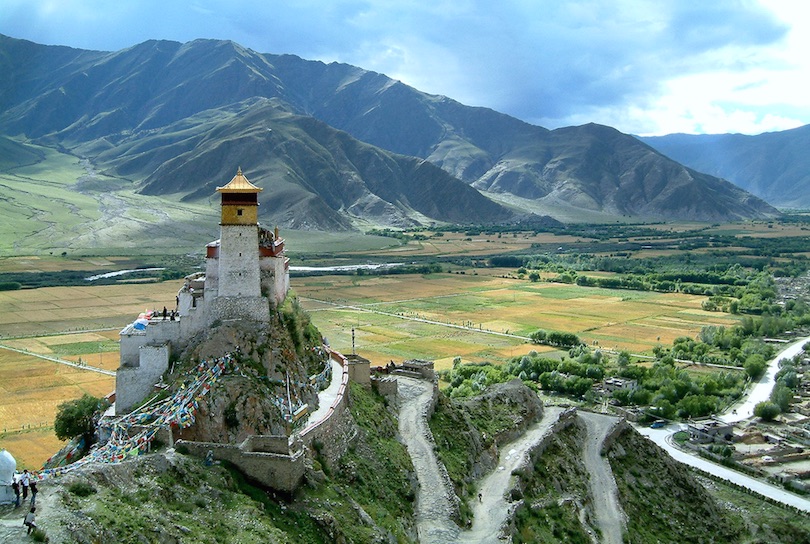 flickr/RobertF
flickr/RobertFAccording to a legend Yumbulagang was the first building in Tibet and
the palace of the first Tibetan king, Nyatri Tsenpo. Its name means
“Palace of Mother and Son” in Tibetan. Under the reign of the 5th Dalai
Lama the palace became a monastery of the Gelugpa school. Sadly, it was
heavily damaged and reduced to a single storey during the Cultural
revolution but was reconstructed in 1983.
9. Erdene Zuu Monastery
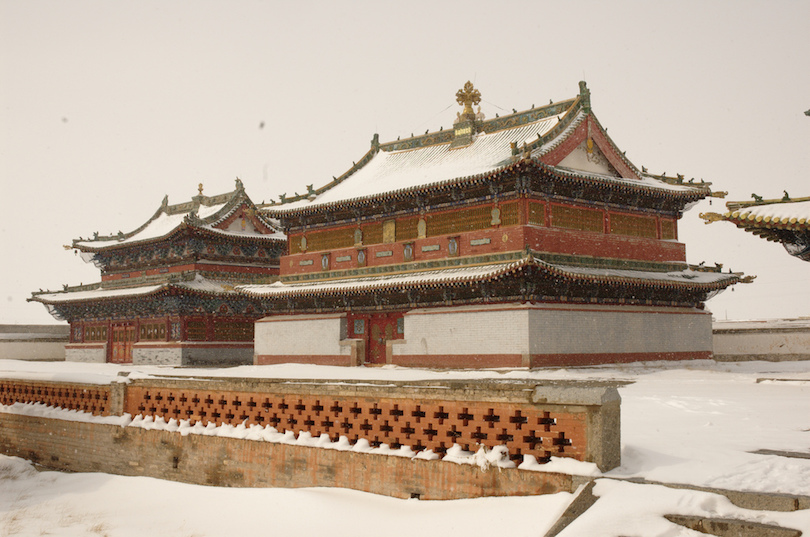 flickr/Honza Soukup
flickr/Honza SoukupThe Erdene Zuu Monastery is probably the most ancient surviving Buddhist monastery in Mongolia.
It was built in 1585 by Abtai Sain Khan, at the introduction of Tibetan
Buddhism into Mongolia. Stones from the ruins of Karakorum were used in
the construction. It is surrounded by a wall featuring 100 stupas. The
number 108, being a sacred number in Buddhism, was probably envisioned,
but never achieved. Under communist rule Erdene Zuu was allowed to exist
as a museum only. However, after the fall of communism in Mongolia in
1990, the monastery was turned over to the lamas and Erdene Zuu again
became a place of worship.
8. Ganden Monastery
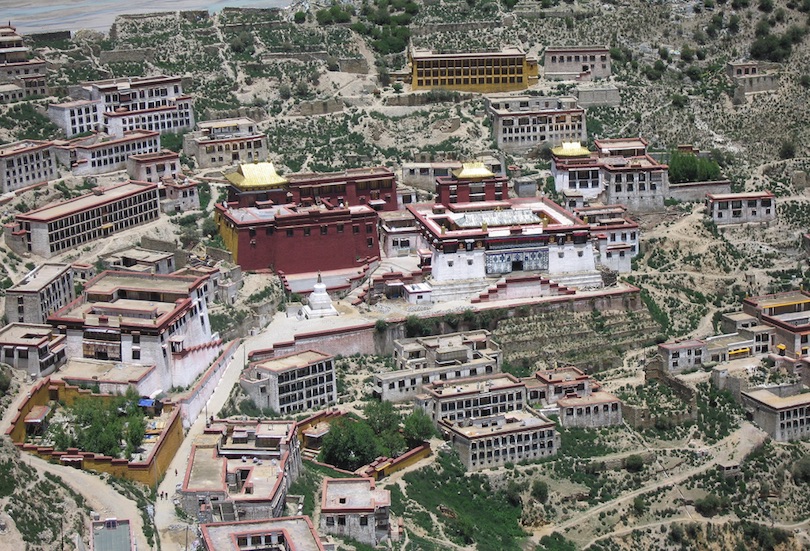 flickr/Pet_r
flickr/Pet_rGanden Monastery is one of the ‘great three’ university monasteries
of Tibet, located at the top of Wangbur Mountain at an altitude of 4,300
meters (14,107 feet). The other two are Sera Monastery and Drepung
Monastery. Being the farthest from Lhasa
of the three university monasteries, Ganden traditionally had a smaller
population with some 6,000 monks in the early 20th century. In 1959 the
monastery was completely destroyed by the Red Guards and the mummified
body of Tsongkhapa, the founder of the Monastery, was burned.
Reconstruction of the Monastery has been continuing since the 1980s.
7. Key Gompa
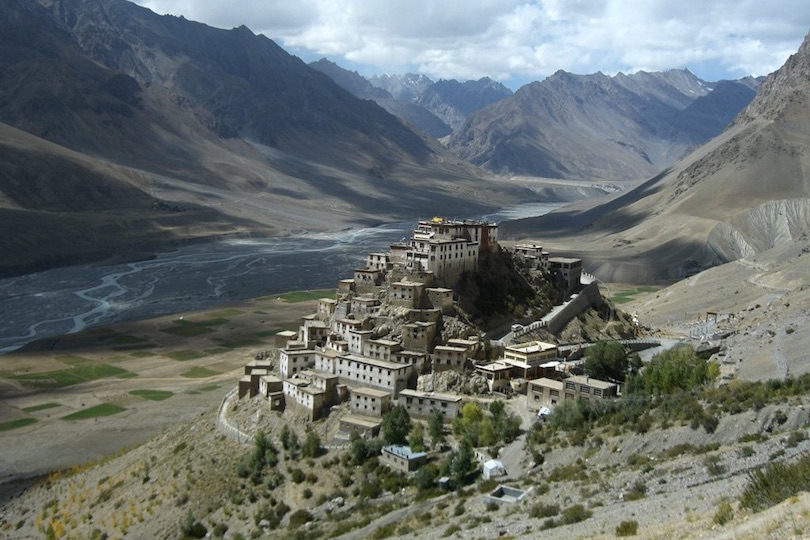 flickr/4ocima
flickr/4ocimaKey Gompa or Ki Monastery is a thousand year old Tibetan Buddhist
monastery located prominently on top of a hill at an altitude of 4,166
meters (13,668 feet) in the Spiti Valley. The village of Kibar below the
monastery is said to be the highest village in India. The monastery has
been attacked many times during its long history by Mongol and other
armies and was also ravaged by fire and earthquakes. The successive
trails of destruction and restorations have resulted in a box-like
construction, and the monastery looks like a fort, where temples are
built on top of one another.
6. Lama Temple
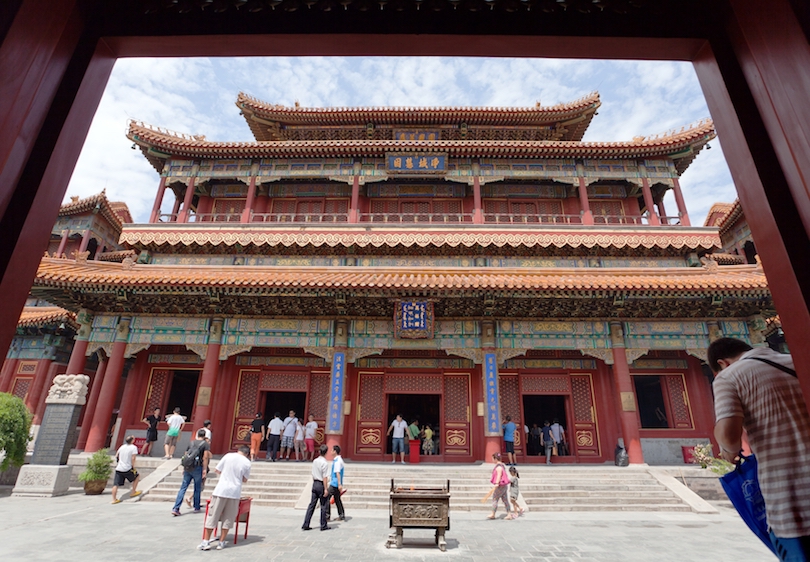 dreamstime/© Daniel Prudek
dreamstime/© Daniel PrudekThe Lama Temple (Yonghe Temple/Palace of Peace and Harmony), located in the northeastern part of Beijing,
is one of the largest Tibetan Buddhist monasteries in the world. The
temple was built by Chinese emperors who harbored a deep fascination for
the Tibetan version of Buddhism. Over the years, many Tibetan and
Mongolian monks lived and taught here, and there are still monks in
residence today. The temple contains a 26 meter (85 foot) tall statue of
Maitreya Buddha carved from a single piece of white sandalwood.
5. Thikse Monastery
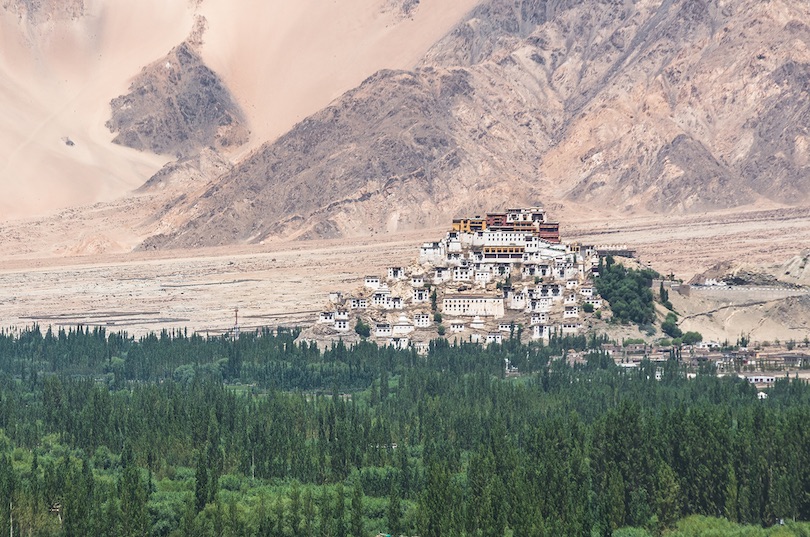
Thikse Monastery is a Tibetan Buddhist monastery of the Yellow Hat
sect noted for its resemblance to the Potala Palace in Lhasa. The
monastery is located at an altitude of 3,600 meters (11,800 feet) in the
Indus valley in India. It is a 12-storey complex and houses many items
of Buddhist art such as stupas, statues and wall paintings. One of the
main points of interest is the Maitreya Temple which is installed to
commemorate the visit of the 14th Dalai Lama to the Thikse monastery in
1970.
4. Punakha Dzong
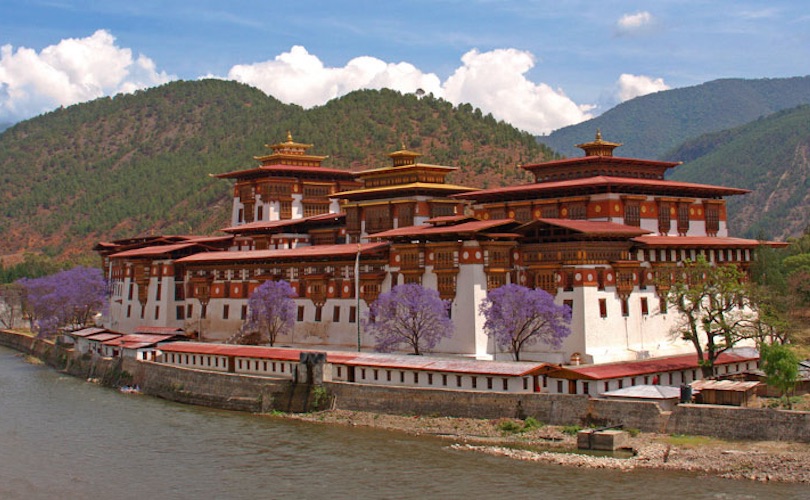 flickr/jmhullot
flickr/jmhullotMajestically standing on an island between the confluence of the Pho
Chhu and Mo Chhu rivers, Punakha Dzong is one of the most photogenic of
all Bhutan’s ancient dzongs. A dzong is a combination of both a fortress
and monastery and one is located in every district in Bhutan. Punakha
Dzong, like any other dong, serves several purposes including protection
for the region, an administrative seat for the government and as the
winter home of the monastic body. It is joined to the mainland by an
arched wooden bridge, and contains many precious relics from the days
when successive kings reigned the kingdom from this valley.
3. Taung Kalat
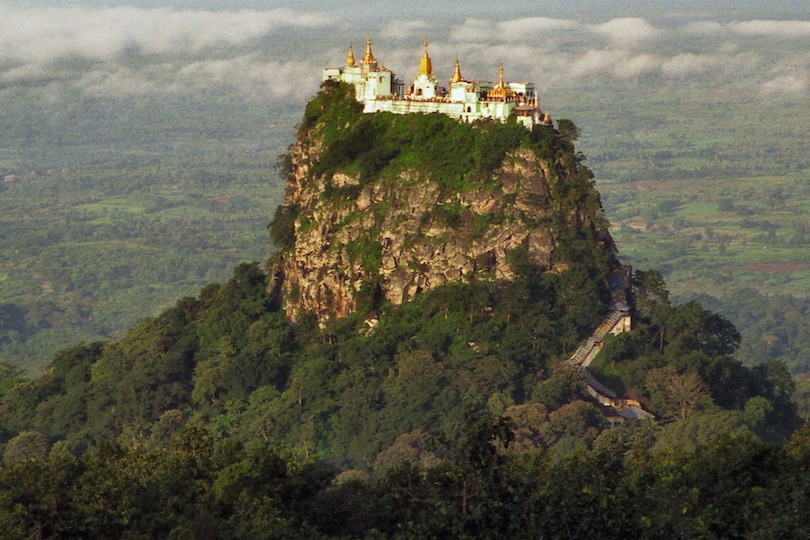 flickr/exfordy
flickr/exfordyBuilt atop an extinct volcano plug, the Buddhist monastery of Taung Kalat is one of the most breathtaking sites in Burma.
To reach the monastery, visitors must climb the 777 steps to the
summit. Along the way are a multitude of Macaque monkeys expecting
treats. From the top of Taung Kalat, one can enjoy a panoramic view. One
can see the ancient city of Bagan and the massive solitary conical peak
of Mount Popa, the volcano that actually caused the creation of the
volcanic plug.
2. Taktsang Dzong
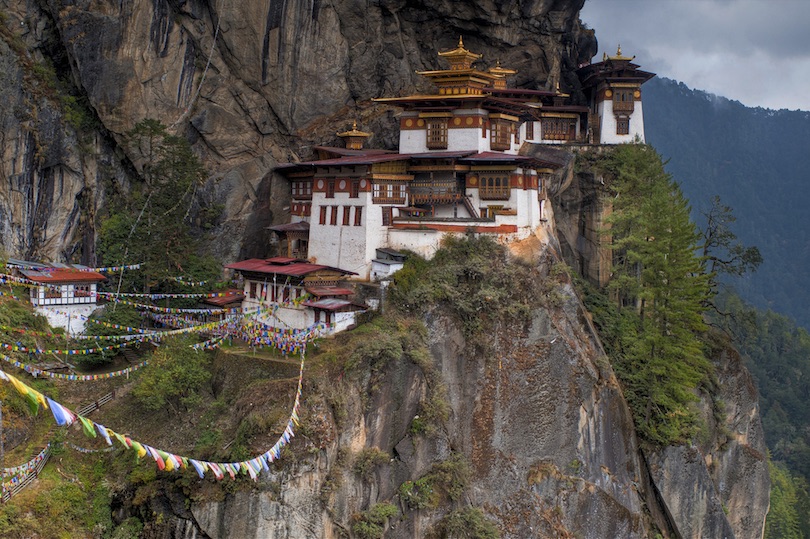 flickr/Goran Hoglund
flickr/Goran HoglundSituated on the edge of a 900 meter (3,000 feet) cliff, the Taktsang
Monastery or Tiger’s Nest creates an impressive sight, and is the
unofficial symbol of Bhutan. It is about 2-3 hour, totally up-hill hike
from the parking lot to the monastery. According to a legend Guru
Rinpoche flew to this location from Tibet on the back of a tigress and
Taktsang was consecrated to tame the Tiger demon. The first monastery
was not constructed until 1692. In 1998 a tragic fire destroyed most of
the original buildings, but these have since been painstakingly restored
to their former glory.
1. Hanging Monastery
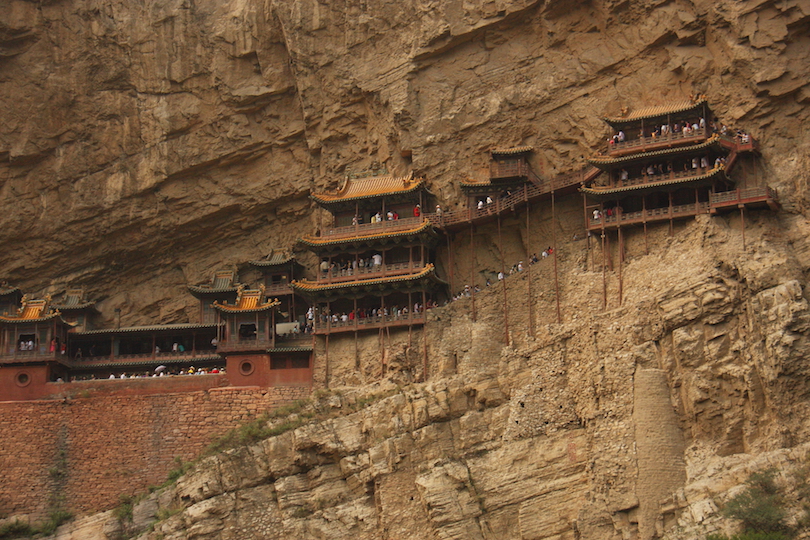
Perched precariously halfway up a cliff some 75 meters (246 feet)
above the ground, the Hanging Monastery is one of the most remarkable sights in China.
Consisting of a complex of 40 rooms linked together by mid-air
corridors and walkways, this remarkable monastery appears to be glued to
the side of a sheer precipice. The name ‘hanging’ may be misleading
though as it’s actually supported by stilts rather than built into a
cliff. The monastery was built in the 5th century and has been hanging
here for 1500 years. Over its long history many repairs and extension
led to its present day scale.
27) Classical Danish-Klassisk dansk,Klassisk dansk,
Opdagelse af Awakened One with Awareness Universe (DAOAU)
SN 22.59 (S iii 66)
Anattalakkhana Sutta
- Karakteristikken ved ikke-selv -
[anattā · lakkhaṇa]
I denne meget berømte sutta forklarer Buddha for første gang sin undervisning om anatta.
Ved en lejlighed boede Bhagava på Bārāṇasi i Deer Grove i Isipatana. Der henvendte han sig til gruppen af fem bhikkhus:
- Bhikkhus.
- Bhadante, svarede bhikkhus. Bhagavā sagde:
- Rūpa, bhikkhus, er anatta. Og hvis denne rūpa var atta, bhikkhus, ville denne rūpa ikke egne sig til svækkelse, og det kunne [siges] om rūpa: ‘Lad min rûpa være således, lad min rûpa ikke være sådan.’ Men det er fordi rūpa er en anatta, som rūpa egner sig til at gøre sygdom, og at det ikke kan [siges] om rūpa: ‘Lad min rūpa være således, lad min rūpa ikke være sådan.’
Vedana, Bhikkhus, er anatta. Og hvis denne vedanā var atta, bhikkhus, ville denne vedanā ikke egne sig til svækkelse, og det kunne [siges] om vedanā: ‘Lad min vedanā være sådan, lad min vedanā ikke være sådan.’ Men det er fordi vedanā er anatta, at vedanā egner sig til sygdom, og at det ikke kan [siges] om vedanā: ‘Lad min vedanā være sådan, lad min vedanā ikke være sådan.’
Saññā, bhikkhus, er anatta. Og hvis denne saññā var atta, bhikkhus, ville denne saññā ikke egne sig til svækkelse, og det kunne [siges] om saññā: ‘Lad min saññā være sådan, lad min saññā ikke være sådan.’ Men det er, fordi saññā er anatta, som saññā egner sig til at gøre sig dårligt, og at det ikke kan [siges] om saññā: ‘Lad min saññā være sådan, lad min saññā ikke være sådan.’
Saṅkhāras, bhikkhus, er anatta. Og hvis disse saṅkhāras var atta, bhikkhus, ville disse saṅkhāras ikke egne sig til at blive svækket, og det kunne [siges] om saṅkhāras: ‘Lad mine saṅkhāras være således, lad mine saṅkhāras ikke være sådan.’ Men det er fordi saṅkhāras er anatta, som saṅkhāras egner sig til at lindre, og at det ikke kan [siges] om saṅkhāras: ‘Lad mine saṅkhāras være sådan, lad mine saṅkhāras ikke være sådan.’
Viññāṇa, bhikkhus, er anatta. Og hvis denne viññāṇa var atta, bhikkhus, ville denne viññāṇa ikke egne sig til svækkelse, og det kunne [siges] om viññāṇa: ‘Lad min viññāṇa være sådan, lad min viññāṇa ikke være sådan.’ Men det er fordi viññāṇa er anatta, at viññāṇa egner sig til at blive lindret, og at det ikke kan [siges] om viññāṇa: ‘Lad min viññāṇa være sådan, lad min viññāṇa ikke være sådan.’
Hvad synes du om dette, bhikkhus: er Rūpa permanent eller anicca?
midlertidig
- Anicca, Bhanthdhe
- Og hvad der er anicca, er det dukkha eller sukha? {1}
- Dukkha, Bhante.
- Og det, der er anicca, dukkha, af natur underlagt ændringer, er det korrekt at betragte det som: ‘Dette er mit. Jeg er denne. Dette er min atta? ‘
- Nej, Bhante.
- Er Vedanā permanent eller anicca?
- Anicca, Bhante.
- Og hvad der er anicca, er det dukkha eller sukha?
- Dukkha, Bhante.
- Og det, der er anicca, dukkha, af natur underlagt ændringer, er det korrekt at betragte det som: ‘Dette er mit. Jeg er denne. Dette er min atta? ‘
- Nej, Bhante.
- Er Saññā permanent eller anicca?
- Anicca, Bhante.
- Og hvad der er anicca, er det dukkha eller sukha?
- Dukkha, Bhante.
- Og det, der er anicca, dukkha, af natur underlagt ændringer, er det korrekt at betragte det som: ‘Dette er mit. Jeg er denne. Dette er min atta? ‘
- Nej, Bhante.
- Er Saṅkhāras permanent eller anicca?
- Anicca, Bhante.
- Og hvad der er anicca, er det dukkha eller sukha?
- Og det, der er anicca, dukkha, af natur underlagt ændringer, er det korrekt at betragte det som: ‘Dette er mit. Jeg er denne. Dette er min atta? ‘
- Nej, Bhante.
- Er Viññāṇa permanent eller anicca?
- Anicca, Bhante.
- Og hvad der er anicca, er det dukkha eller sukha?
- Dukkha, Bhante.
- Og det, der er anicca, dukkha, af natur underlagt ændringer, er det korrekt at betragte det som: ‘Dette er mit. Jeg er denne. Dette er min atta? ‘
- Nej, Bhante.
- Derfor skal bhikkhus, uanset hvad det er, fortid, fremtid eller nutid, internt eller eksternt, groft eller subtilt, ringere eller ophøjet, langt eller nært, enhver rûpa ses yathā · bhūtaṃ med ordentlig paññā på denne måde: ‘ Dette er ikke min, jeg er ikke dette, dette er ikke min atta. ‘
Uanset vedanā, det være sig fortid, fremtid eller nuværende, internt eller eksternt, groft eller subtilt, ringere eller ophøjet, langt eller nært, skal enhver vedanā ses yathā · bhūtaṃ med ordentlig paññā på denne måde: ‘Dette er ikke min, Jeg er ikke dette, dette er ikke min atta. ‘
Uanset saññā, det være sig fortid, fremtid eller nuværende, internt eller eksternt, groft eller subtilt, ringere eller ophøjet, langt eller nært, enhver saññā skal ses yathā · bhūtaṃ med ordentlig paññā på denne måde: ‘Dette er ikke min, Jeg er ikke dette, dette er ikke min atta. ‘
Uanset saṅkhāras, hvad enten det er fortid, fremtid eller nuværende, internt eller eksternt, groft eller subtilt, ringere eller ophøjet, langt eller nært, skal enhver saṅkhāras ses yathā · bhūtaṃ med ordentlig paññā på denne måde: ‘Dette er ikke min, Jeg er ikke dette, dette er ikke min atta. ‘
Uanset viññāṇa, det være sig fortid, fremtid eller nutid, internt eller eksternt, groft eller subtilt, ringere eller ophøjet, langt eller nært, enhver viññāṇa skal ses yathā · bhūtaṃ med ordentlig paññā på denne måde: ‘Dette er ikke min, Jeg er ikke dette, dette er ikke min atta. ‘Set på denne måde er en oplyst nobel discipel skuffet over Raba, utilfreds med smerte, skuffet over døden, skuffet over chakraer og skuffet over Via. Skuffet bliver han følelsesladet. Gennem depression er han lettet. Med befrielse, isa: ‘befriet.’ Han forstår: ‘Fødslen er forbi, Brahmin-livet leves, hvad der skal gøres er gjort, der er intet andet for denne eksistens.’
Dette er hvad Bhagwar sagde. Gruppen af fem munke, der var meget glade, glædede sig over hans ord.
Da denne åbenbaring blev givet, blev citadellerne fra gruppen af fem munke, uden at holde fast, befriet fra døden.
28) Classical Dutch- Klassiek Nederlands,
Ontdekking van Awakened One met Awareness Universe (DAOAU)
SN 22.59 (S iii 66)
Anattalakkhana Sutta
- Het kenmerk van niet-zelf -
[anattā · lakkhaṇa]
In deze zeer beroemde sutta zet de Boeddha voor het eerst zijn leer over anatta uiteen.
Op een keer verbleef de Bhagavā in Bārāṇasi in het Deer Grove in Isipatana. Daar sprak hij de groep van vijf monniken toe:
- Bhikkhus.
- Bhadante, antwoordden de monniken. De Bhagavā zei:
- Rupa, monniken, is anatta. En als deze rūpa atta, monniken waren, zou deze rūpa zichzelf niet lenen voor ziekte, en het zou [gezegd] kunnen worden van rūpa: ‘Laat mijn rūpa zo zijn, laat mijn rūpa niet zo zijn.’ Maar omdat rūpa anatta is, leent rūpa zich voor ziekte, en kan het niet [gezegd worden] van rūpa: ‘Laat mijn rūpa zo zijn, laat mijn rūpa niet zo zijn.’
Vedanā, monniken, is anatta. En als deze vedanā atta, monniken waren, zou deze vedanā zich niet lenen voor ziekte, en het zou [gezegd] kunnen worden van vedanā: ‘Laat mijn vedanā zo zijn, laat mijn vedanā niet zo zijn.’ Maar het is omdat vedanā anatta is dat vedanā zich leent voor ziekte, en dat het niet [gezegd kan worden] van vedanā: ‘Laat mijn vedanā zo zijn, laat mijn vedanā niet zo zijn.’
Saññā, monniken, is anatta. En als deze saññā atta, monniken waren, zou deze saññā zich niet lenen voor ziekte, en het zou [gezegd] kunnen worden van saññā: ‘Laat mijn saññā zo zijn, laat mijn saññā niet zo zijn.’ Maar het is omdat saññā anatta is dat saññā zich leent voor ziekte, en dat kan niet [gezegd worden] van saññā: ‘Laat mijn saññā zo zijn, laat mijn saññā niet zo zijn.’
Saṅkhāras, monniken, zijn anatta. En als deze saṅkhāra’s atta, monniken waren, zouden deze saṅkhāra’s zich niet lenen voor ongemak, en van saṅkhāra’s zou kunnen worden gezegd: ‘Laat mijn saṅkhāra’s zo zijn, laat mijn saṅkhāra’s niet zo zijn.’ Maar het is omdat saṅkhāra’s anatta zijn, dat saṅkhāra’s zich lenen voor ziekte, en dat kan niet [gezegd worden] van saṅkhāras: ‘Laat mijn saṅkhāra’s zo zijn, laat mijn saṅkhāra’s niet zo zijn.’
Viññāṇa, monniken, is anatta. En als deze viññāṇa atta, monniken waren, zou deze viññāṇa zich niet lenen voor ongemak, en van viññāṇa zou kunnen worden gezegd: ‘Laat mijn viññāṇa zo zijn, laat mijn viññāṇa niet zo zijn.’ Maar het is omdat viññāṇa anatta is, dat viññāṇa zich leent voor ziekte, en dat kan niet [gezegd worden] van viññāṇa: ‘Laat mijn viññāṇa zo zijn, laat mijn viññāṇa niet zo zijn.’
Wat vind je hiervan, monniken: is Rūpa permanent of anicca?
tijdelijk
- Anicca, Bhanthdhe
- En dat wat anicca is, is het dukkha of sukha? {1}
- Dukkha, Bhante.
- En dat wat anicca, dukkha is, van nature onderhevig aan verandering, is het juist om het te beschouwen als: ‘Dit is van mij. Ik ben dit. Dit is mijn atta? ‘
- Nee, Bhante.
- Is Vedanā permanent of anicca?
- Anicca, Bhante.
- En dat wat anicca is, is het dukkha of sukha?
- Dukkha, Bhante.
- En dat wat anicca, dukkha is, van nature onderhevig aan verandering, is het juist om het te beschouwen als: ‘Dit is van mij. Ik ben dit. Dit is mijn atta? ‘
- Nee, Bhante.
- Is Saññā permanent of anicca?
- Anicca, Bhante.
- En dat wat anicca is, is het dukkha of sukha?
- Dukkha, Bhante.
- En dat wat anicca, dukkha is, van nature onderhevig aan verandering, is het juist om het te beschouwen als: ‘Dit is van mij. Ik ben dit. Dit is mijn atta? ‘
- Nee, Bhante.
- Zijn Saṅkhāras permanent of anicca?
- Anicca, Bhante.
- En dat wat anicca is, is het dukkha of sukha?
- En dat wat anicca, dukkha is, van nature onderhevig aan verandering, is het juist om het te beschouwen als: ‘Dit is van mij. Ik ben dit. Dit is mijn atta? ‘
- Nee, Bhante.
- Is Viññāṇa permanent of anicca?
- Anicca, Bhante.
- En dat wat anicca is, is het dukkha of sukha?
- Dukkha, Bhante.
- En dat wat anicca, dukkha is, van nature onderhevig aan verandering, is het juist om het te beschouwen als: ‘Dit is van mij. Ik ben dit. Dit is mijn atta? ‘
- Nee, Bhante.
- Daarom, monniken, welke rūpa dan ook, of het nu verleden, toekomst of heden is, intern of extern, grof of subtiel, inferieur of verheven, ver of nabij, elke rūpa moet als yathā · bhūtaṃ met de juiste paññā op deze manier worden gezien: ‘ Dit is niet van mij, ik ben dit niet, dit is niet mijn atta. ‘
Wat voor vedanā ook is, of het nu verleden, toekomst of heden is, intern of extern, grof of subtiel, inferieur of verheven, ver of nabij, elke vedanā kan als yathā · bhūtaṃ met de juiste paññā op deze manier worden gezien: ‘Dit is niet van mij, Ik ben dit niet, dit is niet mijn atta. ‘
Welke saññā ook, verleden, toekomst of heden, intern of extern, grof of subtiel, inferieur of verheven, ver of nabij, elke saññā is yathā · bhūtaṃ met de juiste paññā op deze manier te zien: ‘Dit is niet van mij, Ik ben dit niet, dit is niet mijn atta. ‘
Welke saṅkhāra’s ook, of ze nu verleden, toekomst of heden zijn, intern of extern, grof of subtiel, inferieur of verheven, ver of nabij, alle saṅkhāra’s zijn als yathā · bhūtaṃ met de juiste paññā te zien op deze manier: ‘Dit is niet van mij, Ik ben dit niet, dit is niet mijn atta. ‘
Wat viññāṇa ook is, of het nu verleden, toekomst of heden is, intern of extern, grof of subtiel, inferieur of verheven, ver of nabij, elke viññāṇa is yathā · bhūtaṃ met de juiste paññā op deze manier te zien: ‘Dit is niet van mij, Ik ben dit niet, dit is niet mijn atta. ‘Zo bezien is een verlichte nobele discipel teleurgesteld in Raba, ontevreden over pijn, teleurgesteld in de dood, teleurgesteld in chakra’s en teleurgesteld in Via. Teleurgesteld wordt hij emotioneel. Door een depressie is hij opgelucht. Met bevrijding, isa: ‘bevrijd’. Hij begrijpt: ‘De geboorte is voorbij, het leven van een brahmaan wordt geleefd, wat er moet gebeuren, wordt gedaan, er is niets anders voor dit bestaan.’
Dit is wat Bhagwar zei. De groep van vijf monniken die opgetogen waren, waren verrukt over zijn woorden.
Toen deze openbaring werd gegeven, werden de citadellen van de groep van vijf monniken, zonder vast te houden, van de dood bevrijd.
10 Largest Temples in the World
So,
what is the biggest temple in the world? To answer this question we
first have to establish what a temple is. Although roughly defined as a
structure reserved for religious or spiritual activities not all
religions use the word temple. In the Western Christian tradition temple
is rarely used for example so these churches and cathedrals will be
excluded. In contrast, in the Eastern Christian tradition the word
temple is used very frequently.
Second what measure of size to use? According to the Guinness World Record the Akshardham Temple is the largest Hindu temple
in the world but this is disputed by at least 3 other temples in India
which are all claimed to be the largest temple. These temples are often
part of a larger complex which makes it even less clear. In this list
I’ll focus on the main temple (if any) to determine which is the largest temple in the word.
10. Baalbek
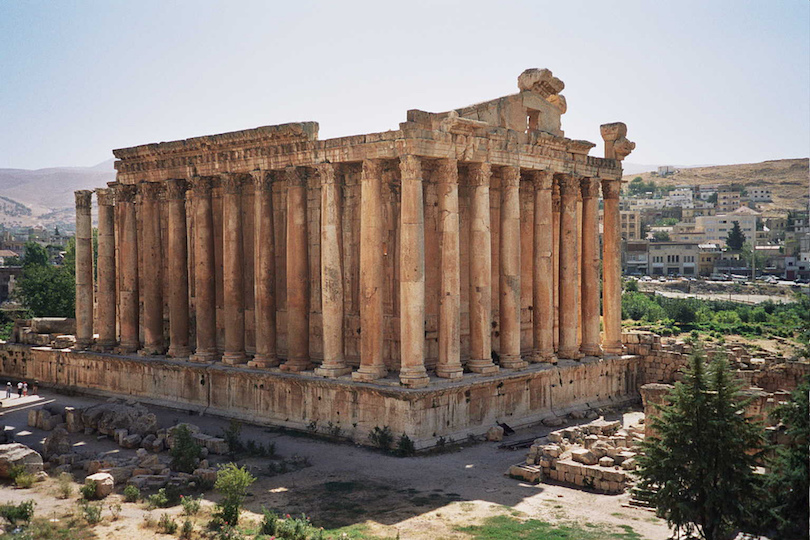 flickr/upyernoz
flickr/upyernozBaalbek, also called Heliopolis, is a spectacular archaeological site
in northeastern Lebanon. From the 1st century BC and over a period of
two centuries, the Romans built three temples here: Jupiter, Bacchus and
Venus. Created to be the largest temple in the Roman empire, the temple
of Jupiter was lined by 54 massive granite columns. Only 6 of these
titanic columns remain standing but even they are incredibly impressive.
The best preserved temple at the site is the Temple of Bacchus built in
150 AD. The temple is 69 meters long and 36 meters wide. Its walls are
adorned by 42 Corinthian columns, 19 of which remain upright in position
standing 19 meters (62 feet) high.
9. Temple of Christ the Saviour
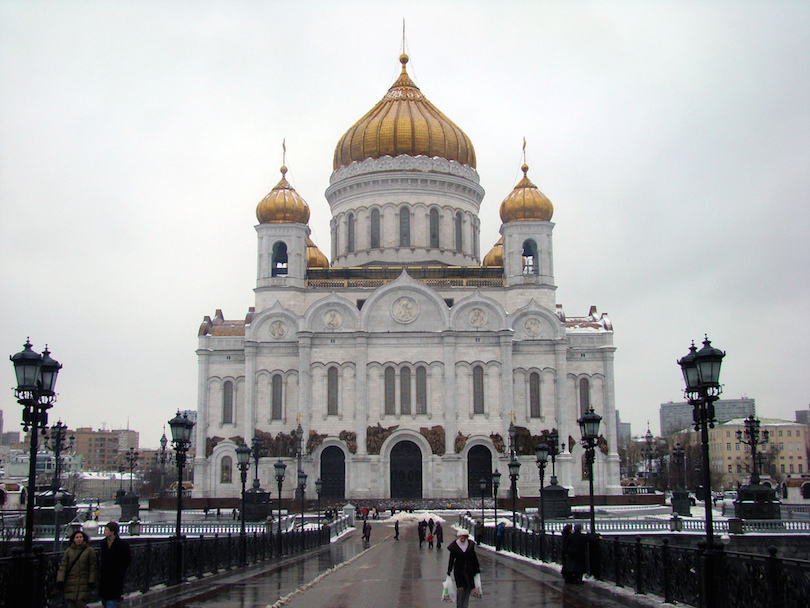 flickr/akk_rus
flickr/akk_rusOne of the most imposing and controversial buildings in Moscow,
the resurrected Temple of Christ the Saviour has had a short but
turbulent history. It was originally commissioned after the defeat of
Napoleon, but construction did not begin until 1839. In 1931 it was
blown to pieces by orders of Stalin to make way for a proposed Palace of
the Soviets, which was never built. In 1990, the Russian Orthodox
Church received permission to rebuilt the cathedral. Completed in 2000,
the new cathedral is loosely based on the original design, but
constructed with modern building materials. At a height of 105 meters
(344 feet) it is the tallest Orthodox church in the world.
8. Temple of Saint Sava
 flickr/Jorge-11
flickr/Jorge-11The Temple of Saint Sava in Belgrade
is the largest Orthodox church building in the world. It is dedicated
to the founder of the Serbian Orthodox Church. The construction of the
church began in 1985 and was mostly completed by 2004. The internal
decorations are still not finished. In English, it is usually called a
cathedral because of its size and importance but it is not the seat of a
bishop and therefore technically not a cathedral. In Serbian it is
called a hram (temple). The church is 91 meters (299 feet) long from and
81 meters (266 feet) wide. It is 70 meters (230 feet) tall, with the
main gold-plated cross on top of the dome extends the church for 12 more
meters (39 feet). It has a surface area of 3,500 m2 on the ground
floor.
7. Tikal (Temple IV)
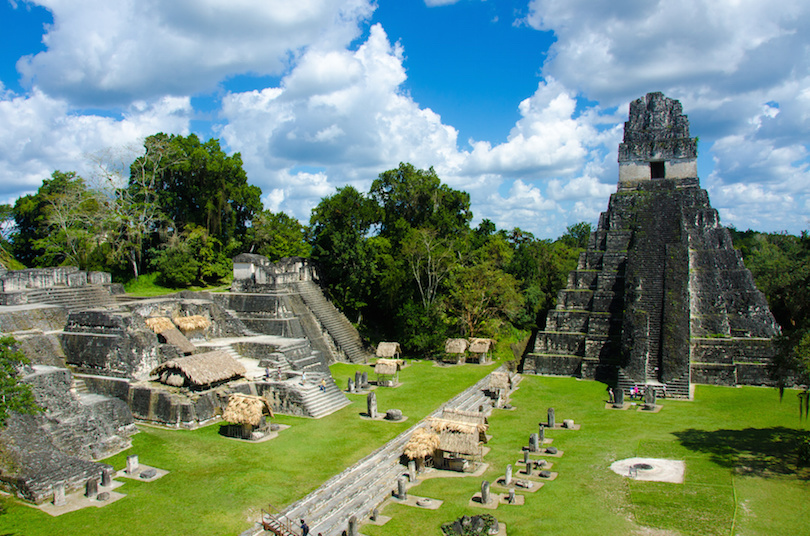
Tikal was the largest Mayan city between ca. 200 to 900 AD with an
estimated population between 100,000 and 200,000 inhabitants. Tikal
contains 6 very large step pyramids. The largest, Temple-pyramid IV, is
some 72 meters (230 feet) high and was finished around 720 AD. Temple IV
is the largest temple built anywhere in the Maya region, and as it
currently stands is the tallest pre-Columbian structure in the Americas
although the Pyramid of the Sun at Teotihuacan may originally have been taller, as may have been one of the jungle covered pyramids at El Mirador.
6. Jetavanaramaya
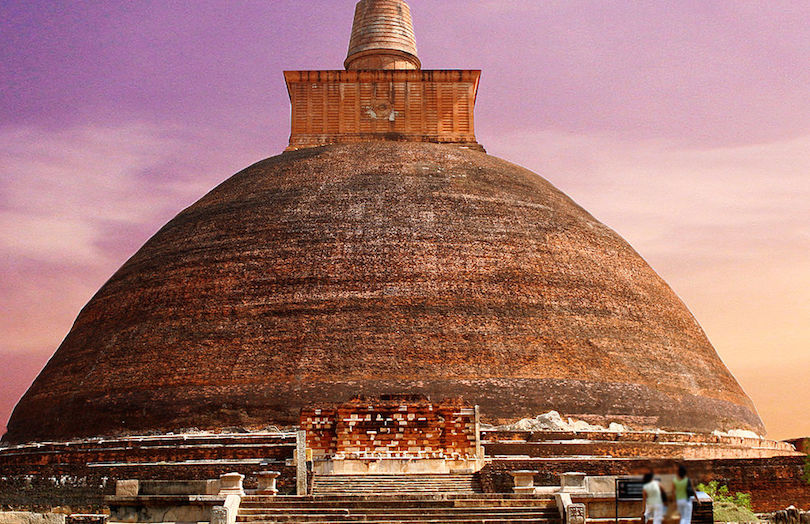 wikipedia/MOHS Kosgodage
wikipedia/MOHS KosgodageLocated in the city of Anuradhapura, Sri Lanka,
the Jetavanaramaya is the largest stupa in the world if measured by
volume. The temple was built by king Mahasena in the 3rd century AD and
took 15 years to complete. Approximately 93.3 million baked bricks were
used in the construction. With a height of 122 meters (400 feet),
Jetavanaramaya was the third tallest structure in the world behind the
pyramids of Giza at the time of its completion. The diameter of the dome
itself is approximately 95 meters (312 feet).
5. Sri Ranganathaswamy
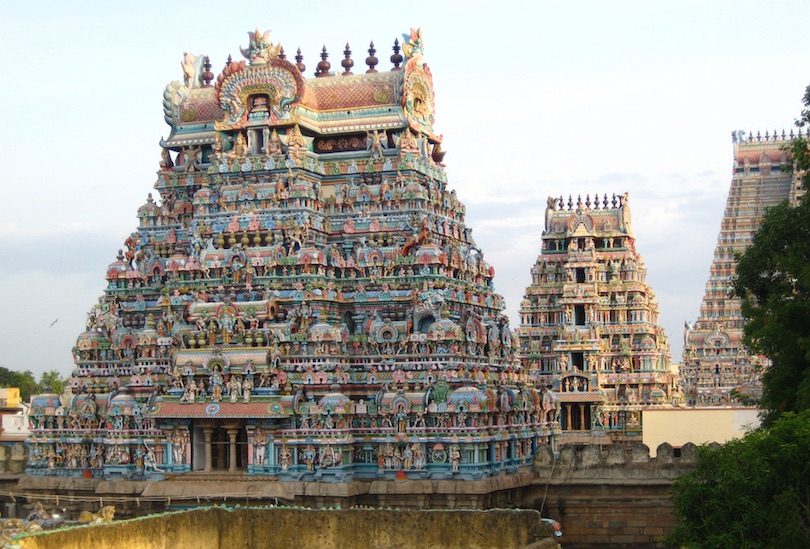 flickr/Melanie M
flickr/Melanie MDedicated to Lord Ranganatha (a reclining form of Lord Vishnu), the
Sri Ranganathaswamy Temple in Srirangam is an important shrine that
receives millions of visitors and pilgrims every year. With an area of
156 acres (6,31,000 m²), the Sri Ranganathaswamy Temple is one of the
largest temples in the world. In fact, the temple can be easily termed
as the largest functioning Hindu temple complex in the world. The oldest
structure of the temple dates back to the 10th century. There are 21
gopurams (tower), among which the Rajagopuram is the biggest temple in
South India. It is 73 meters (240 feet) in height, and dates from the
17th century, although it was only completed in 1987.
4. Akshardham Temple
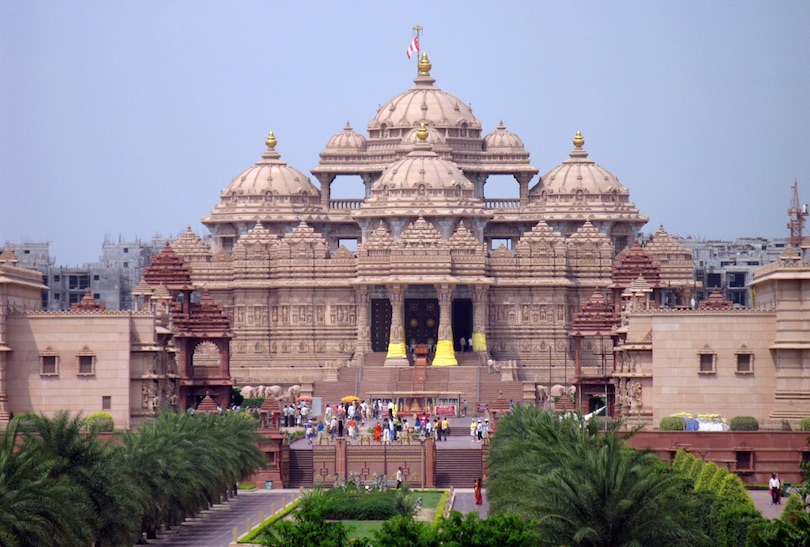 flickr/Gaurav Trivedi
flickr/Gaurav TrivediCompleted in 2005 by the spiritual organization BAPS, no expense has
been spared in decorating the Akshardham temple. The building was
inspired and moderated by Pramukh Swami Maharaj, the current head of
Swaminarayan Hinduism. The central monument is 43 meters (141 feet)
high, 96 meters (316 feet) wide, and 110 meters (370 feet) long, and is
covered top to bottom with carved details of flora, fauna, dancers,
musicians, and deities. It is constructed entirely from Rajasthani pink
sandstone and Italian Carrara marble, and has no support from steel or
concrete.
3. Borobudur

Located on the Indonesian island
of Java, 40 km (25 miles) northwest of Yogyakarta, the Borobudur is the
largest Buddhist temple in the world. The temple was built over a
period of some 75 years in the 8th and 9th centuries by the kingdom of
Sailendra, out of an estimated 2 million blocks of stone. The Borobodur
can be divided into three groups: base, body, and top, which resembles
the three major division of a human body. The base is a 123×123 meters
(403.5×403.5 feet) square in size and 4 meters (13 feet) high of walls.
The total surface area is approximately 2,500 m2. The body is composed
of 5 square platforms each with diminishing heights. The top is a
monumental stupa with a main dome at the center . The dome has a height
of 35 meters (115 feet) from the ground level.
2. Karnak (Great Hypostyle Hall)
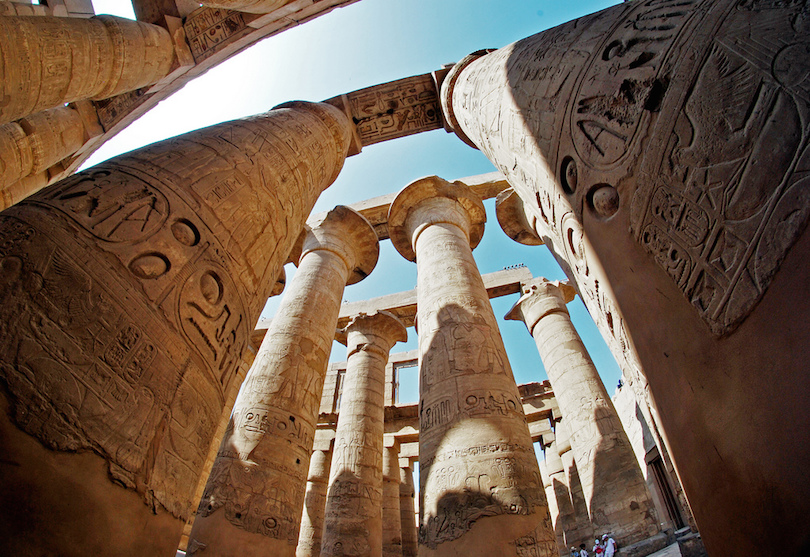 flickr/Mr. Theklan
flickr/Mr. TheklanAlthough badly ruined, few sites in Egypt
are more impressive than Karnak. It is the largest ancient temple
complex in the world, and represents the combined achievement of many
generations of Egyptian builders. Karnak actually consists of several
temples. One of most famous structures of Karnak is the Hypostyle Hall, a
hall area of 5,000 m2 (50,000 sq ft). The 134 massive columns arranged
in 16 rows supported a roof that has now fallen. At a height of 24
meters (80 feet) the 2 middle rows are higher than the others.
1. Angkor Wat Temple
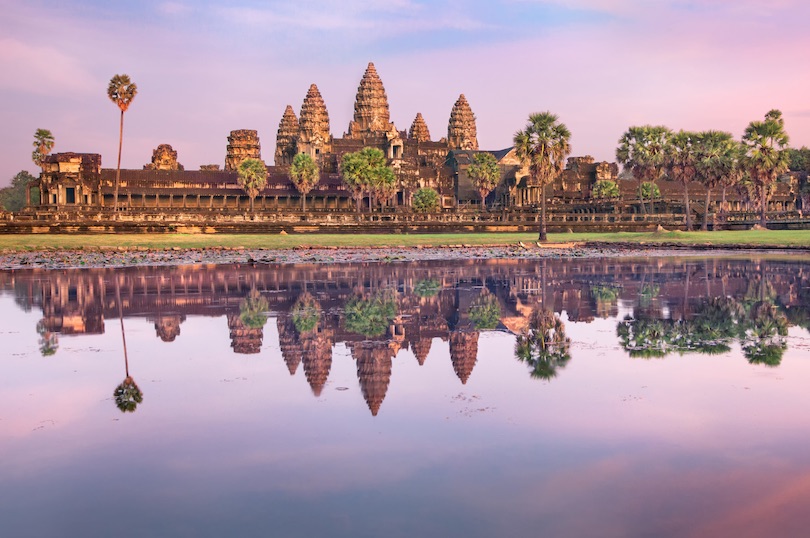
Angkor s a vast temple complex in Cambodia
featuring the magnificent remains of several capitals of the Khmer
Empire, from the 9th to the 15th century AD. These include the famous
Angkor Wat temple, the largest temple in the world. The Angkor temple
stands on a raised terrace above the rest of the city. It is made of
three rectangular galleries rising to a central tower, each level higher
than the last. The outer gallery of the Angkor Wat temple measures 187 x
215 meters (614 x 705 feet). After this, the next two galleries are
connected to each other. On the second level, it measures 100 x 115
meters (328 x 377 feet). The inner gallery is a 60 x 60 meter (197 x 197
feet) square area. The tower above the central shrine rises 65 meters
(213 feet) above the ground.
10 Man Made Wonders of the World
The
earliest lists of Seven Wonders of the Ancient World were made more
than 2,000 years ago by ancient Hellenic tourists. Except for the Great
Pyramid of Giza those wonders no longer exist. They were destroyed by
earthquakes, fires and in one case by an angry mob. Many lists of
wonders have been made since than. Today we list our selection of 10
wonders of the world.
10. Parthenon
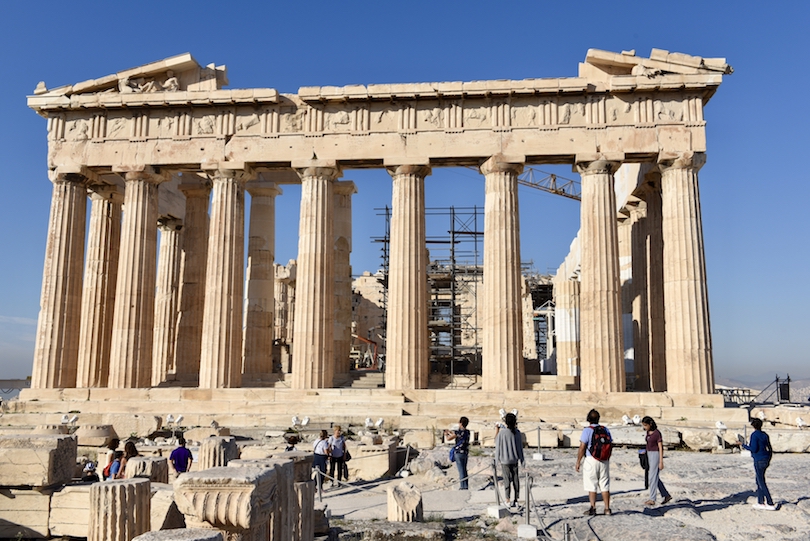 dreamstime/© Jim Roberts
dreamstime/© Jim RobertsThe Parthenon on top of the Acropolis is one of the most famous buildings in the world and a visit to Athens
is not complete without visiting this temple. The construction of the
Parthenon started in in 447 BC, replacing and older temple that was
destroyed by the Persians, and completed in 432 BC. The purpose of the
Parthenon was to house a massive statue of Athena Parthenos made from
ivory, silver and gold. Sometime in the 5th century the statue was
looted by one of the Roman Emperors, and taken to Constantinople, where
it was later destroyed. During its long life the Parthenon has also
served as a fortress, a church, a mosque and as a powder magazine.
9. Easter Island

The world famous moai are monolithic statues located on Easter
Island, one of the most isolated islands on Earth. The statues were
carved by the Polynesian colonizers of the island, mostly between circa
1250 AD and 1500 AD. In addition to representing deceased ancestors, the
moai were also regarded as the embodiment of powerful living or former
chiefs. The tallest moai erected, called Paro, was almost 10 meters (33
ft) high and weighed 75 tonnes. The statues were till standing when
Europeans first visited the island, but most would be cast down during
later conflicts between clans. Today about 50 moai have been re-erected
on Easter Island or museums elsewhere.
8. Taj Mahal
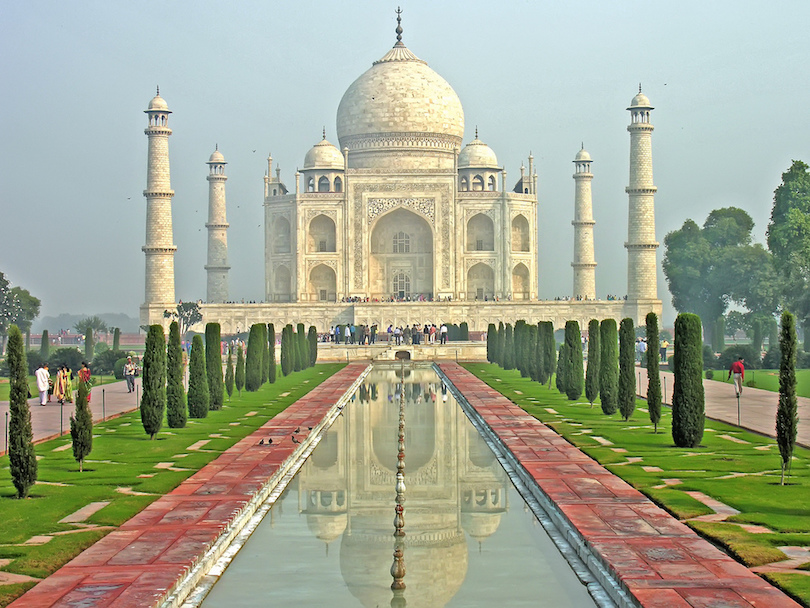 flickr/Dennis Jarvis
flickr/Dennis JarvisThe Taj Mahal is an immense mausoleum of white marble, built between
1632 and 1653 by order of the Mughal emperor Shah Jahan in memory of his
favorite wife. The Taj is one of the most well preserved and
architecturally beautiful tombs in the world, one of the masterpieces of
Mughal architecture, and one of the great sites of the world’s
heritage. Called “a teardrop on the cheek of eternity”, the monument is
actually an integrated complex of structures. Besides the white domed
marble mausoleum it includes several other beautiful buildings,
reflecting pools, and extensive ornamental gardens with flowering trees
and bushes.
7. Colosseum

The Colosseum is the largest and most famous amphitheater ever built
in the Roman Empire. Its construction was started by emperor Vespasian
of the Flavian dynasty in 72 AD and was finished by his son Titus in 80
AD. During the Colosseum’s opening ceremonies, spectacles were held for
100 days in which 5,000 of animals and 2,000 gladiators were killed. The
Colosseum was capable of holding some 50,000 spectators who could enter
the building through no less than 80 entrances. Spectators were
protected from the rain and heat of the sun by sail,s called the
“velarium”, around the top of the attic. It is one of Rome’s most popular tourist attractions and has become an iconic symbol of Imperial Rome.
6. Angkor
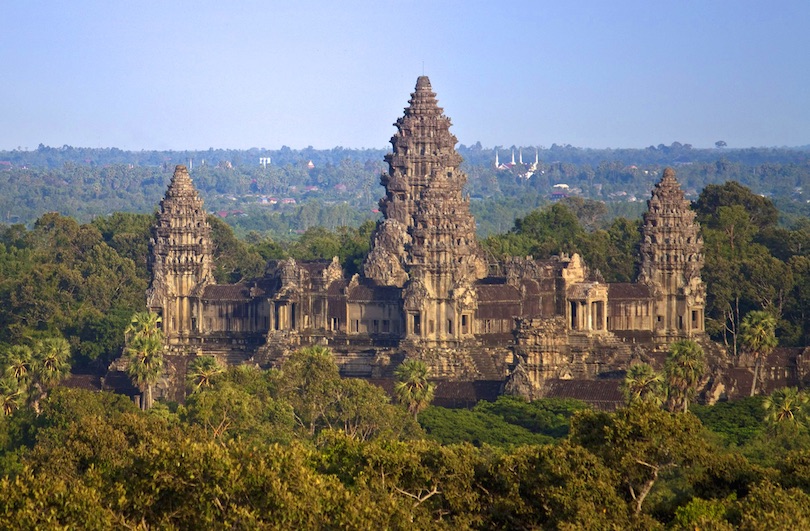
Angkor Wat is a vast temple complex featuring the magnificent remains
of several capitals of the Khmer Empire, from the 9th to the 15th
century AD. These include the famous Angkor Wat temple, the world’s
largest single religious monument, and the Bayon temple (at Angkor Thom)
with its multitude of massive stone faces. During it’s long history Angkor
went through many changes in religion converting between Hinduism to
Buddhism several times. It has become a symbol of Cambodia, appearing on
its national flag, and it is the country’s prime attraction for
visitors.
5. Teotihuacan
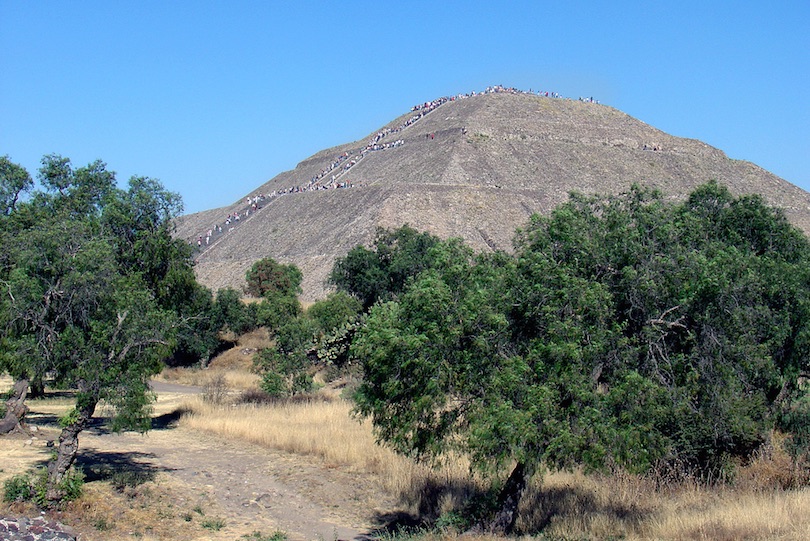 flickr/ZeroOne
flickr/ZeroOneIn the 2nd century BC a new civilization arose in the valley of
Mexico. This civilization built the flourishing metropolis of
Teotihuacán and it’s huge step pyramids.
The Pyramid of the Sun was built around 100 AD and is 75 meters (246 ft
(75) high making it the largest building in Teotihuacán and one of the
largest in Mesoamerica. The construction of the smaller Pyramid of the
Moon started a century later and was finished in 450 A.D. Seven
centuries after the demise of the Teotihuacán empire the pyramids were
honored and utilized by the Aztecs and became a place of pilgrimage.
4. Petra
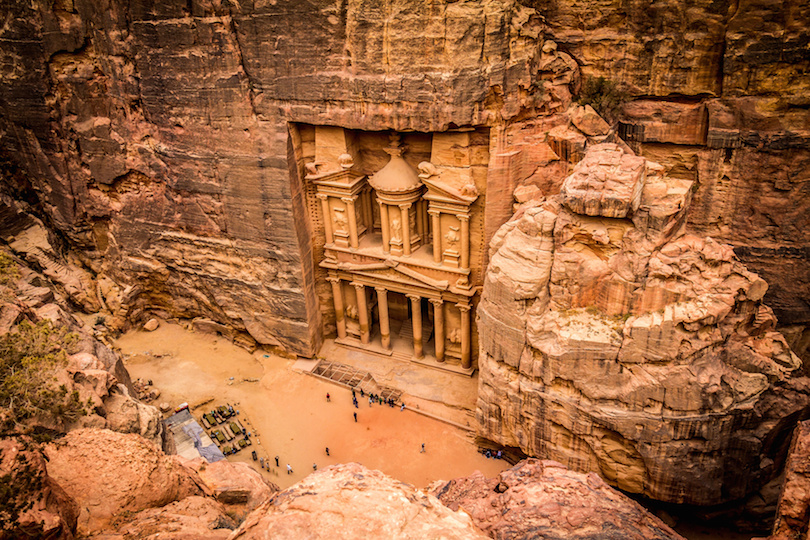
Petra, the fabled “rose red city, half as old as time”, was the
ancient capital of the Nabataean kingdom. It is without a doubt Jordan’s
most valuable treasure and greatest tourist attraction. A vast, unique
city, carved into the side of the Wadi Musa Canyon centuries ago by the
Nabataeans, who turned it into an important junction for the silk and
spice routes that linked China, India and southern Arabia with Egypt,
Greece and Rome. The most elaborate building in Petra is Al Khazneh
(“The Treasury”), carved out of a sandstone rock face, it’s massive
façade dwarfing everything around it.
3. Machu Picchu
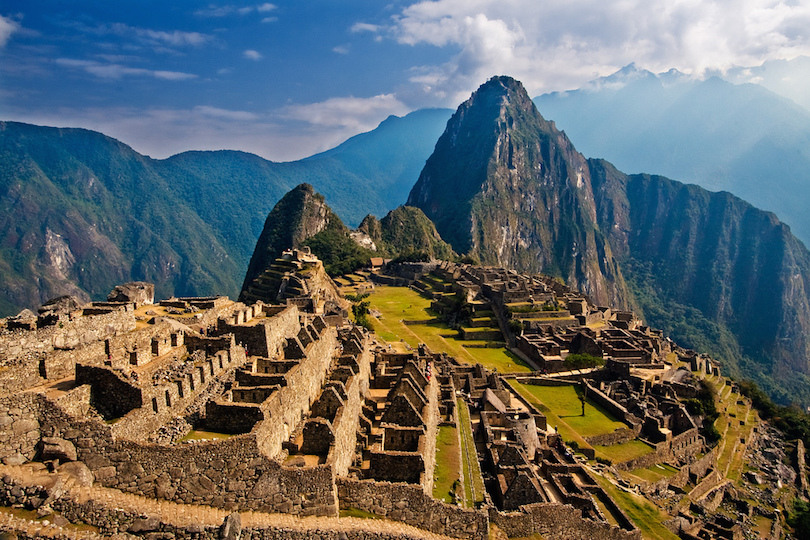 flickr/Pedro Szekely
flickr/Pedro SzekelyOne of the most beautiful and impressive ancient sites in the world, Machu Pichu
was rediscovered in 1911 by Hawaiian historian Hiram after it lay
hidden for centuries above the Urubamba Valley. The “Lost City of the
Incas” is invisible from below and completely self-contained, surrounded
by agricultural terraces and watered by natural springs. Although known
locally, it was largely unknown to the outside world before being
rediscovered in 1911. Since then, Machu Picchu has become the most
important tourist attraction in Peru.
2. Great Wall of China
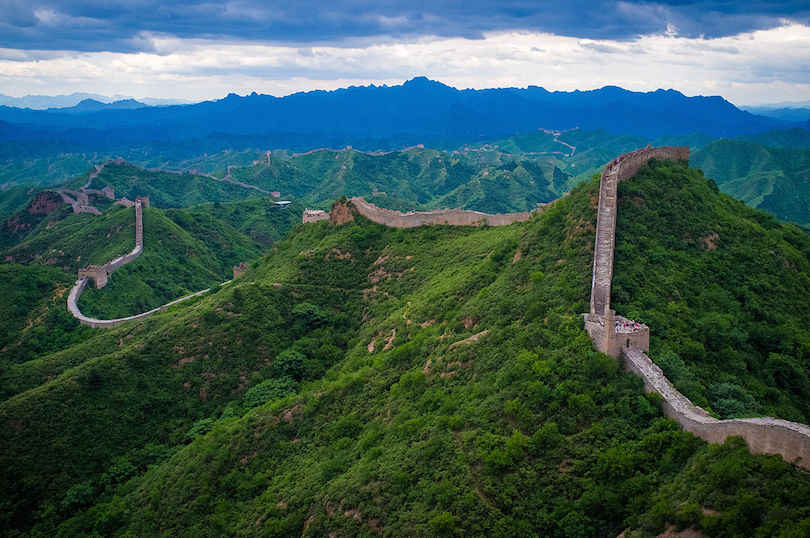 wikipedia/Severin.stalder
wikipedia/Severin.stalderThe Great Wall of China built, rebuilt, and maintained between the
5th century BC and the 16th century to protect the northern borders of
the Chinese Empire from the attacks of the Xiongnu tribes. Several walls
have been built that were referred to as the Great Wall. One of the
most famous is the wall built between 220–206 BC by the first Emperor of
China but little of that wall remains. The majority of the existing
wall were built during the Ming Dynasty (1368-1644 AD). The most
comprehensive archaeological survey has recently concluded that the
entire Great Wall, with all of its branches, stretches for 8,851.8
kilometers (5,500.3 miles).
1. Pyramids of Giza
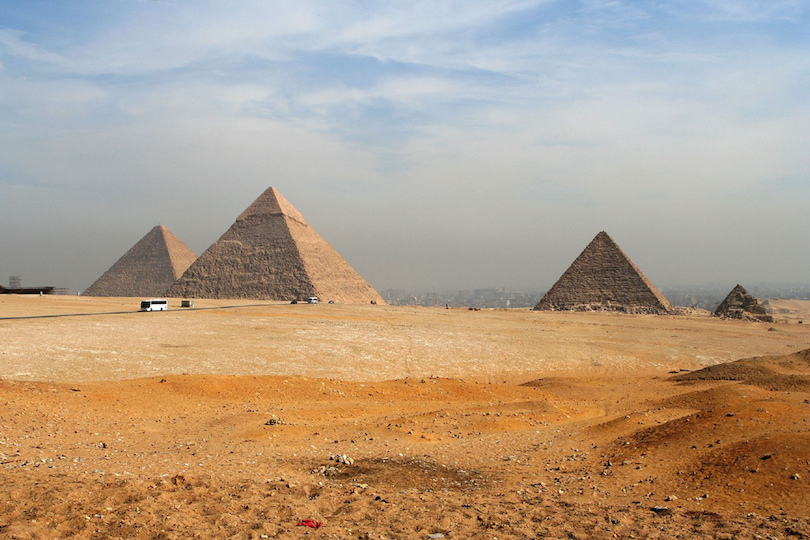 flickr/Tommy Wong
flickr/Tommy WongThe Giza necropolis, situated in the immediate vicinity of the
southwestern suburbs of Cairo is probably the most famous ancient site
in the world. The pyramids in Giza were built over the span of three
generations – by Khufu, his second reigning son Khafre, and Menkaure.
The Great Pyramid of Khufu is the oldest and sole remnant of the Seven
Wonders of the Ancient World. Over 2 million blocks of stone were used
to construct the pyramid, during a 20 year period concluding around 2560
BC. The pyramid is an awe-inspiring 139 meters (455 feet) high making
it the largest pyramid in Egypt, although nearby Khafre’s Pyramid
appears to be larger as it is build at a higher elevation.
30) Classical Esperanto-Klasika Esperanto,
Malkovro de Vekita Kun Konscia Universo (DAOAU)
SN 22.59 (S iii 66)
Anattalakkhana Sutta
- La karakterizo de senmemo -
[anattā · lakkhaṇa]
En ĉi tiu tre fama sutta, Budho unuafoje klarigas sian instruadon pri anatta.
Dum unu okazo, la Bhagavā loĝis ĉe Bārāṇasi en la Cervo-Arbareto ĉe Isipatana. Tie, li alparolis la grupon de kvin bekhoj:
- Bhikkhus.
- Bhadante, la monstroj respondis. La Bhagavā diris:
- Rūpa, bhikkhus, estas anatta. Kaj se ĉi tiu rūpa estus atta, bhikkhus, ĉi tiu rūpa ne pruntedonus malfortiĝi, kaj ĝi povus [diri] pri rūpa: ‘Mia rūpa estu tiel, mia rūpa ne estu tiel.’ Sed ĉar rūpa estas anatta, ke rūpa pruntedonas sin al malsano, kaj ke ĝi ne povas [diri] pri rūpa: ‘Mia rūpa estu tiel, mia rūpa ne estu tiel.’
Vedanā, bhikkhus, estas anatta. Kaj se ĉi tiu vedanā estus atta, bhikkhus, ĉi tiu vedanā ne pruntedonus malfortiĝi, kaj ĝi povus [diri] pri vedanā: “Mia vedanā estu tiel, mia vedanā ne estu tiel.” Sed ĉar vedanā estas anatta, vedanā pruntedonas sin al malsano, kaj ke ĝi ne povas [esti dirita] pri vedanā: “Mia vedanā estu tiel, mia vedanā ne estu tiel.”
Saññā, bhikkhus, estas anatta. Kaj se ĉi tiu saññā estus atta, bhikkhus, ĉi tiu saññā ne pruntedonus malfortiĝi, kaj ĝi povus [diri] pri saññā: ‘Mia saññā estu tiel, mia saññā ne estu tiel.’ Sed tio estas ĉar saññā estas anatta, ke saññā pruntedonas sin al malsano, kaj ke ĝi ne povas [esti dirita] pri saññā: “Mia saññā estu tiel, mia saññā ne estu tiel.”
Saṅkhāras, bhikkhus, estas anatta. Kaj se ĉi tiuj saṅkhāras estus atta, bhikkhus, ĉi tiuj saṅkhāras ne pruntedonus sin malfortigi, kaj ĝi povus [diri] pri saṅkhāras: ‘Mia saṅkhāras estu tiel, mia saṅkhāras ne estu tiel.’ Sed ĝi estas ĉar saṅkhāras estas anatta, ke saṅkhāras pruntedonas sin al malstreĉiĝo, kaj ke ĝi ne povas [esti dirita] pri sahkhāras: ‘Mia saṅkhāras estu tiel, mia saṅkhāras ne estu tiel.’
Viññāṇa, bhikkhus, estas anatta. Kaj se ĉi tiu viññāṇa estus atta, bhikkhus, ĉi tiu viññāṇa ne pruntedonus malfortiĝi, kaj ĝi povus [diri] pri viññāṇa: “Mia viññāṇa estu tiel, mia viññāṇa ne estu tiel.” Sed ĉar viññāṇa estas anatta, viññāṇa pruntedonas sin al malsano, kaj ke ĝi ne povas [esti dirita] pri viññāṇa: “Mia viññāṇa estu tiel, mia viññāṇa ne estu tiel.”
Kion vi pensas pri ĉi tio, bhikkhus: ĉu Rūpa estas konstanta aŭ anika?
portempa
- Anicca, Bhanthdhe
- Kaj tio, kio estas anicca, ĉu dukkha aŭ sukha? {1}
- Dukkha, Bhante.
- Kaj tio, kio estas anika, dukkha, laŭ naturo ŝanĝebla, ĉu konvenas konsideri ĝin kiel: ‘Ĉi tio estas mia. Mi estas ĉi tio. Jen mia atta? ‘
- Ne, Bhante.
- Ĉu Vedanā estas konstanta aŭ anika?
- Anicca, Bhante.
- Kaj tio, kio estas anicca, ĉu dukkha aŭ sukha?
- Dukkha, Bhante.
- Kaj tio, kio estas anika, dukkha, laŭ naturo ŝanĝebla, ĉu konvenas konsideri ĝin kiel: ‘Ĉi tio estas mia. Mi estas ĉi tio. Jen mia atta? ‘
- Ne, Bhante.
- Ĉu Saññā estas konstanta aŭ anicca?
- Anicca, Bhante.
- Kaj tio, kio estas anicca, ĉu dukkha aŭ sukha?
- Dukkha, Bhante.
- Kaj tio, kio estas anika, dukkha, laŭ naturo ŝanĝebla, ĉu konvenas konsideri ĝin kiel: ‘Ĉi tio estas mia. Mi estas ĉi tio. Jen mia atta? ‘
- Ne, Bhante.
- Ĉu Saṅkhāras estas konstanta aŭ anicca?
- Anicca, Bhante.
- Kaj tio, kio estas anicca, ĉu dukkha aŭ sukha?
- Kaj tio, kio estas anika, dukkha, laŭ naturo ŝanĝebla, ĉu konvenas konsideri ĝin kiel: ‘Ĉi tio estas mia. Mi estas ĉi tio. Jen mia atta? ‘
- Ne, Bhante.
- Ĉu Viññāṇa estas konstanta aŭ anika?
- Anicca, Bhante.
- Kaj tio, kio estas anicca, ĉu dukkha aŭ sukha?
- Dukkha, Bhante.
- Kaj tio, kio estas anika, dukkha, laŭ naturo ŝanĝebla, ĉu konvenas konsideri ĝin kiel: ‘Ĉi tio estas mia. Mi estas ĉi tio. Jen mia atta? ‘
- Ne, Bhante.
- Tial, bhikkhus, kia ajn rūpa, estu pasinta, estonta aŭ nuna, interna aŭ ekstera, malpura aŭ subtila, malsupera aŭ ekzaltita, malproksima aŭ proksima, iu rūpa estas videbla yathā · bhūtaṃ kun taŭga paññā tiamaniere: ‘ Ĉi tio ne estas mia, mi ne estas ĉi tio, ĉi tio ne estas mia atta. ‘
Kio ajn vedanā, ĉu ĝi estas pasinta, estonta aŭ ĉeestanta, interna aŭ ekstera, kruda aŭ subtila, malsupera aŭ ekzaltita, malproksima aŭ proksima, iu ajn vedana estas videbla yathā · bhūtaṃ kun taŭga paññā tiamaniere: ‘Ĉi tio ne estas mia, Mi ne estas ĉi tio, ĉi tio ne estas mia atta. ‘
Kio ajn saññā, ĉu ĝi estas pasinta, estonta aŭ nuna, interna aŭ ekstera, kruda aŭ subtila, malsupera aŭ ekzaltita, malproksima aŭ proksima, ia saññā estas videbla yathā · bhūtaṃ kun taŭga paññā tiamaniere: ‘Ĉi tio ne estas mia, Mi ne estas ĉi tio, ĉi tio ne estas mia atta. ‘
Kiaj ajn saṅkhāras, estu ili pasintaj, estontaj aŭ nunaj, internaj aŭ eksteraj, krudaj aŭ subtilaj, malsuperaj aŭ ekzaltitaj, malproksimaj aŭ proksimaj, iuj saṅkhāras estas videblaj yathā · bhūtaṃ kun taŭga paññā tiamaniere: ‘Ĉi tio ne estas mia, Mi ne estas ĉi tio, ĉi tio ne estas mia atta. ‘
Kio ajn viññāṇa, ĉu ĝi estas pasinta, estonta aŭ nuna, interna aŭ ekstera, malneta aŭ subtila, malsupera aŭ ekzaltita, malproksima aŭ proksima, iu viññāṇa videblas yathā · bhūtaṃ kun taŭga paññā tiamaniere: ‘Ĉi tio ne estas mia, Mi ne estas ĉi tio, ĉi tio ne estas mia atta. ‘Tiel vidata, klera nobla disĉiplo seniluziiĝas pri Raba, malkontenta pri doloro, seniluziigita per morto, seniluziigita per ĉakroj kaj seniluziigita per Via. Seniluziigita, li emociiĝas. Tra depresio, li estas senzorgigita. Kun liberigo, isa: “liberigita.” Li komprenas: “Naskiĝo finiĝis, bramina vivo vivas, farendaĵo estas farita, ekzistas nenio alia por ĉi tiu ekzisto.”
Jen kion diris Bhagwar. La grupo de kvin mona monoj ravitaj ĝojis pro liaj vortoj.
Kiam ĉi tiu revelacio ricevis, la citadeloj de la grupo de kvin mona monoj, sengluiĝintaj, estis liberigitaj de la morto.
31) Classical Estonian- klassikaline eesti keel,
Teadvuse universumiga äratatud avastamine (DAOAU)
SN 22.59 (S iii 66)
Anattalakkhana Sutta
- mitte-mina omadus -
[anattā · lakkhaṇa]
Selles väga kuulsas suttas selgitab Buddha esimest korda oma õpetust anatast.
Ühel korral viibis Bhagavā Isipatanas Hirvesalvas Bārāṇasis. Seal pöördus ta viie bhikkhuse rühma poole:
- Bhikkhus.
- Bhadante, vastas bhikkhus. Bhagavā ütles:
- Rūpa, bhikkhus, on anatta. Ja kui see rūpa oleks atta, bhikkhus, ei pakuks see rūpa ennast kergeks ja võiks öelda: [Rääpast] võiks öelda: “Las mu rūpa olla selline, ärgu minu rūpa selline olema.” Kuid just seetõttu, et rūpa on anatta, kipub rūpa end kergendama ja et ei saa [öelda] rūpa kohta: “Las mu rūpa olla selline, ärgu minu rūpa selline olema.”
Vedanā, bhikkhus, on anatta. Ja kui see vedanā oleks atta, bhikkhus, ei võimaldaks see vedanā ennast kergendada ja vedanā kohta võiks [öelda]: “Las mu vedanā olla selline, ärgu minu vedanā olema selline.” Kuid just sellepärast, et vedanā on anatta, sobib vedanā ennast kergesti leevendada ja et vedanā kohta ei saa öelda: „Las mu vedanā olgu selline, ärgu minu vedanā selline olema.”
Saññā, bhikkhus, on anatta. Ja kui see saññā oleks atta, bhikkhus, ei annaks see saññā endast kergust ja saññā kohta võiks [öelda]: “Las mu saññā olla selline, siis minu saññā ei tohi olla selline.” Kuid just sellepärast, et saññā on anatta, võib saññā end kergendada ja saññā kohta ei saa öelda: „Las minu saññā olla selline, ärgu minu saññā selline olema”.
Saṅkhārad, bhikkhus, on anattad. Ja kui need saṅkhārad oleksid atta, bhikkhud, ei annaks need saṅkhārad end halvaks ja saṅkhārade kohta võiks [öelda]: „Las mu saṅkhārad oleksid sellised, ärgu minu saṅkhārad sellised olema”. Kuid sellepärast, et saṅkhārad on anattad, pakuvad saṅkhārad end halvaks ja et saṅkhārade kohta ei saa öelda: „Las mu saṅkhārad olla sellised, ärgu minu saṅkhārad sellised olema”.
Viññāṇa, bhikkhus, on anatta. Ja kui see viññāṇa oleks atta, bhikkhus, ei võimaldaks see viññāṇa ennast kergendada ja viññāṇa kohta võiks [öelda]: „Las mu viññāṇa olla nii, siis ei tohi minu viññāṇa olla selline”. Kuid sellepärast, et viññāṇa on anatta, kipub viññāṇa ennast kergendama ja et viññāṇa kohta ei saa [öelda]: “Las minu viññāṇa olla selline, ärgu minu viññāṇa nii olema.”
Mida sa sellest arvad, bhikkhus: kas Rūpa on püsiv või anicca?
ajutine
- Anicca, Bhanthdhe
- Ja see, mis on anicca, kas see on dukkha või sukha? {1}
- Dukkha, Bhante.
- Ja seda, mis on anicca, dukkha, võib oma olemuselt muutuda, kas seda on õige pidada: “See on minu. Ma olen see. See on minu atta? ‘
- Ei, Bhante.
- Kas Vedanā on püsiv või anicca?
- Anicca, Bhante.
- Ja see, mis on anicca, kas see on dukkha või sukha?
- Dukkha, Bhante.
- Ja seda, mis on anicca, dukkha, võib oma olemuselt muutuda, kas seda on õige pidada: „See on minu. Ma olen see. See on minu atta? ‘
- Ei, Bhante.
- Kas Saññā on püsiv või anicca?
- Anicca, Bhante.
- Ja see, mis on anicca, kas see on dukkha või sukha?
- Dukkha, Bhante.
- Ja seda, mis on anicca, dukkha, võib oma olemuselt muutuda, kas seda on õige pidada: “See on minu. Ma olen see. See on minu atta? ‘
- Ei, Bhante.
- Kas Saṅkhāras on püsiv või anicca?
- Anicca, Bhante.
- Ja see, mis on anicca, kas see on dukkha või sukha?
- Ja seda, mis on anicca, dukkha, võib oma olemuselt muutuda, kas seda on õige pidada: „See on minu. Ma olen see. See on minu atta? ‘
- Ei, Bhante.
- Kas Viññāṇa on püsiv või anicca?
- Anicca, Bhante.
- Ja see, mis on anicca, kas see on dukkha või sukha?
- Dukkha, Bhante.
- Ja seda, mis on anicca, dukkha, võib oma olemuselt muutuda, kas seda on õige pidada: „See on minu. Ma olen see. See on minu atta? ‘
- Ei, Bhante.
- Seetõttu tuleb bhikkhusi, olenemata sellest, kas see on minevik, tulevik või olevik, sisemist või välist, rasket või peent, alamat või kõrgemat, kaugel või lähedal, näha mis tahes rūpa yathā · bhūtaṃ korraliku paññā’ga: ‘ See pole minu, ma pole see, see pole minu atta. ‘
Mis iganes vedanā, olgu see siis minevik, tulevik või olevik, sisemine või väline, jäme või peen, alam või kõrgem, kaugel või lähedal, tuleb mis tahes vedanat näha yathā · bhūtaṃ koos õige paññā’ga sel viisil: „See pole minu, Ma ei ole see, see pole minu atta. ‘
Mis iganes saññā, olgu see siis minevik, tulevik või olevik, sisemine või väline, jäme või peen, alam või kõrgem, kaugel või lähedal, tuleb mis tahes saññā’t näha yathā · bhūtaṃ koos õige paññāga sel viisil: „See pole minu, Ma pole see, see pole minu atta. ‘
Ükskõik, mis saṅkhārasid olgu, olgu need siis minevik, tulevik või olevik, sisemisi või väliseid, jämedaid või peeneid, alamaid või kõrgemaid, kaugel või lähedal, tuleb mis tahes sahkhārasid näha yathā · bhūtaṃ koos õige paññā’ga sel viisil: „See pole minu, Ma ei ole see, see pole minu atta. ‘
Mis iganes viññāṇa, olgu see siis minevik, tulevik või olevik, sisemine või väline, jäme või peen, alam või kõrgem, kaugel või lähedal, tuleb mis tahes viññāṇat näha yathā · bhūtaṃ korraliku paññā’ga sel viisil: „See pole minu, Ma pole see, see pole minu atta. ‘Niimoodi vaadatuna on valgustatud üllas jünger Rabas pettunud, valus rahulolematu, surmas pettunud, tšakrates pettunud ja Via pettunud. Pettununa muutub ta emotsionaalseks. Depressiooni kaudu on ta kergendatud. Vabanemisega on isa: ‘vabastatud’. Ta saab aru: “Sünd on läbi, Brahmini elu on elatud, see, mida tuleb teha, on tehtud, selle olemasolu jaoks pole midagi muud.”
Seda ütles Bhagwar. Rõõmus viiest mungarühmast rõõmustasid tema sõnad.
Kui see ilmutus anti, vabastati viiest munkast koosneva rühma tsitadellid ilma kleepumiseta surmast.
32) Classical Filipino klassikaline filipiinlane,
Pagtuklas ng Awakened One na may Awcious Universe (DAOAU)
SN 22.59 (S iii 66)
Anattalakkhana Sutta
- Ang katangian ng walang-Sarili -
[anattā · lakkhaṇa]
Sa napakatanyag na sutta na ito, ang Buddha ay nagpapaliwanag sa kauna-unahang pagkakataon ng kanyang pagtuturo sa anatta.
Sa isang okasyon, ang Bhagavā ay nanatili sa Bārāṇasi sa Deer Grove at Isipatana. Doon, hinarap niya ang pangkat ng limang mga bhikkhus:
- Bhikkhus.
- Bhadante, sumagot ang mga bhikkhus. Sinabi ng Bhagavā:
- Ang Rūpa, bhikkhus, ay anatta. At kung ang rūpa na ito ay atta, bhikkhus, ang rūpa na ito ay hindi magpapahiram sa kanyang sarili upang mawala ang loob, at masasabi ito tungkol kay rūpa: Ngunit ito ay dahil ang rūpa ay anatta na pinahiram ni rūpa ang sarili upang mawala ang kalagayan, at hindi ito masasabing tungkol sa rūpa:
Si Vedanā, bhikkhus, ay anatta. At kung ang vedanā na ito ay atta, bhikkhus, ang vedanā na ito ay hindi magpapahiram sa sarili, at maaaring [masabi] ng vedanā: ‘Hayaan ang aking vedanā na ganito, huwag ang aking vedanā ay maging ganito.’ Ngunit dahil sa ang vedanā ay anatta na pinahiram ni vedanā ang kanyang sarili upang mawala ang kalagayan, at hindi ito masasabing tungkol sa vedanā: ‘Hayaan ang aking vedanā na ganito, huwag ang aking vedanā ay maging ganito.’
Si Saññā, bhikkhus, ay anatta. At kung ang saññā na ito ay atta, bhikkhus, ang saññā na ito ay hindi magpapahiram sa sarili, at maaaring [masabi] ng saññā: ‘Hayaang maging ganito ang aking saññā, hayaan ang aking saññā na huwag maging ganito.’ Ngunit dahil sa saññā ay anatta na pinahiram ni saññā ang kanyang sarili na mawala, at hindi ito masasabing saññā: ‘Hayaang maging ganito ang aking saññā, hayaan ang aking saññā na hindi maging ganito.’
Saṅkhāras, bhikkhus, ay anatta. At kung ang mga saṅkhāras na ito ay atta, bhikkhus, ang mga saṅkhāras na ito ay hindi magpapahiram sa kanilang sarili upang mawala ang loob, at maaaring [masabi] ng saṅkhāras: ‘Hayaang ang aking mga saṅkhāras ay ganito, huwag ang aking mga saṅkhāras ay ganon. Ngunit dahil saṅkhāras ay mga anatta na pinahiram ni saṅkhāras ang kanilang sarili na mag-dis · easy, at hindi ito masasabing saṅkhāras: ‘Gawin ang aking mga saṅkhāras, huwag nang ganon ang aking mga saṅkhāras.’
Ang Viññāṇa, bhikkhus, ay anatta. At kung ang viññāṇa na ito ay atta, bhikkhus, ang viññāṇa na ito ay hindi magpapahiram sa sarili, at maaaring [masabi] ng viññāṇa: ‘Hayaan ang aking viññāṇa na ganito, hayaan ang aking viññāṇa na huwag maging ganito.’ Ngunit dahil sa ang viññāṇa ay anatta na pinahiram ni viññāṇa ang kanyang sarili upang mawala ang loob, at hindi ito masasabing tungkol kay viññāṇa: ‘Hayaan ang aking viññāṇa na ganyan, hayaan ang aking viññāṇa na huwag maging ganito.’
Ano ang palagay mo tungkol dito, bhikkhus: ang Rūpa ay permanente o anicca?
pansamantala
- Anicca, Bhanthdhe
- At ang alin ang anicca, ito ba ay dukkha o sukha? {1}
- Dukkha, Bhante.
- At ang kung ano ang anicca, dukkha, sa likas na pagbabago ng pagbabago, nararapat na isaalang-alang ito bilang: ‘Akin ito. Ako ito Ito ang aking atta? ‘
- Hindi, Bhante.
- Ang Vedanā ay permanente o anicca?
- Anicca, Bhante.
- At ang alin ang anicca, ito ba ay dukkha o sukha?
- Dukkha, Bhante.
- At ang kung ano ang anicca, dukkha, sa likas na pagbabago ng pagbabago, nararapat na isaalang-alang ito bilang: ‘Akin ito. Ako ito Ito ang aking atta? ‘
- Hindi, Bhante.
- Ang Saññā ba ay permanente o anicca?
- Anicca, Bhante.
- At ang alin ang anicca, ito ba ay dukkha o sukha?
- Dukkha, Bhante.
- At ang kung ano ang anicca, dukkha, sa likas na pagbabago ng pagbabago, nararapat na isaalang-alang ito bilang: ‘Akin ito. Ako ito Ito ang aking atta? ‘
- Hindi, Bhante.
- Ang Saṅkhāras ay permanente o anicca?
- Anicca, Bhante.
- At ang alin ang anicca, ito ba ay dukkha o sukha?
- At ang kung ano ang anicca, dukkha, sa likas na pagbabago ng pagbabago, nararapat na isaalang-alang ito bilang: ‘Akin ito. Ako ito Ito ang aking atta? ‘
- Hindi, Bhante.
- Ang Viññāṇa ba ay permanente o anicca?
- Anicca, Bhante.
- At ang alin ang anicca, ito ba ay dukkha o sukha?
- Dukkha, Bhante.
- At ang kung ano ang anicca, dukkha, sa likas na pagbabago ng pagbabago, nararapat na isaalang-alang ito bilang: ‘Akin ito. Ako ito Ito ang aking atta? ‘
- Hindi, Bhante.
- Samakatuwid, mga bhikkhus, anuman ang rūpa, maging ito ay nakaraan, hinaharap, o kasalukuyan, panloob o panlabas, malubha o banayad, mababa o mataas, malayo o malapit, ang anumang rūpa ay makikita yathā · bhūtaṃ na may wastong paññā sa ganitong paraan: ‘ Hindi ako ito, hindi ako ito, hindi ito ang aking atta. ‘
Anumang vedanā, maging ito ay nakaraan, hinaharap, o kasalukuyan, panloob o panlabas, malaki o banayad, mababa o mataas, malayo o malapit, ang anumang vedanā ay makikita yathā · bhūtaṃ na may wastong paññā sa ganitong paraan: ‘Hindi ito akin, Hindi ako ito, hindi ito ang aking atta. ‘
Anuman ang saññā, maging ito ay nakaraan, hinaharap, o kasalukuyan, panloob o panlabas, masama o banayad, mas mababa o mataas, malayo o malapit, ang anumang saññā ay makikita yathā · bhūtaṃ na may wastong paññā sa ganitong paraan: ‘Hindi ito akin, Hindi ako ito, hindi ito ang aking atta. ‘
Anumang mga saṅkhāras, maging nakaraan, hinaharap, o kasalukuyan, panloob o panlabas, malubha o banayad, mababa o mataas, malayo o malapit, ang anumang mga saṅkhāras ay makikita yathā · bhūtaṃ na may wastong paññā sa ganitong paraan: ‘Hindi ito akin, Hindi ako ito, hindi ito ang aking atta. ‘
Anumang viññāṇa, maging ito ay nakaraan, hinaharap, o kasalukuyan, panloob o panlabas, malaki o banayad, mababa o mataas, malayo o malapit, ang anumang viññāṇa ay makikita yathā · bhūtaṃ na may wastong paññā sa ganitong paraan: ‘Hindi ito akin, Hindi ako ito, hindi ito ang aking atta. ‘Nakita sa ganitong paraan, ang isang napaliwanagan na marangal na alagad ay nabigo kay Raba, hindi nasiyahan sa sakit, nabigo sa kamatayan, nabigo sa mga chakra, at nabigo sa Via. Nadismaya, naging emosyonal siya. Sa pamamagitan ng depression, gumaan ang pakiramdam niya. Sa paglaya, isa: ‘napalaya.’ Nauunawaan niya: ‘Tapos na ang kapanganakan, ang buhay Brahmin ay nabuhay, kung ano ang kailangang gawin ay tapos na, wala nang iba pa para sa pag-iral na ito.’
Ito ang sinabi ni Bhagwar. Ang pangkat ng limang monghe na natuwa sa kanyang mga salita.
Nang ibigay ang paghahayag na ito, ang mga citadel ng pangkat ng limang monghe, nang hindi nananatili, ay napalaya mula sa kamatayan.
33) Classical Finnish- Klassinen suomalainen,
Herätyn löytäminen tietoisuusuniversumilla (DAOAU)
SN 22.59 (S iii 66)
Anattalakkhana Sutta
- Ei-Itsen ominaisuus -
[anattā · lakkhaṇa]
Tässä hyvin kuuluisassa suttassa Buddha kertoo ensimmäistä kertaa opetuksestaan anattasta.
Eräässä tapauksessa Bhagavā oleskeli Bārāṇasissa Peura-lehdossa Isipatanassa. Siellä hän puhui viiden bhikkhus-ryhmän ryhmälle:
- Bhikkhus.
- Bhadante, bhikkhus vastasi. Bhagavā sanoi:
- Rūpa, bhikkhus, on anatta. Ja jos tämä rūpa olisi atta, bhikkhus, tämä rūpa ei antaisi itsensä hajoavaksi, ja rupasta voitaisiin [sanoa]: ‘Olkoon minun rupani näin, älkää olko minun ruppa sellaisia.’ Mutta siksi, että rūpa on anatta, joka huolehtii itsestään ja että siitä ei voida sanoa: ‘Olkoon minun rūpa näin, älkää olko minun rūpa sellaisia.’
Vedanā, bhikkhus, on anatta. Ja jos tämä vedanā olisi atta, bhikkhus, tämä vedanā ei antaisi itsensä hajoavaksi, ja vedanasta voitaisiin [sanoa]: ‘Olkoon minun vedanani näin, älköön minun vedanaani olevan sellainen. Mutta koska vedanā on anatta, vedanā taipuu itsestään hajoamaan, eikä vedanasta voida sanoa: ‘Olkoon vedanani näin, älköön vedanaani näin.’
Saññā, bhikkhus, on anatta. Ja jos tämä saññā olisi atta, bhikkhus, tämä saññā ei antaisi itsensä hajoavaksi, ja saññāsta voitaisiin [sanoa]: ‘Olkoon minun saññāni näin, älköön minun saññāni näin.’ Mutta siksi, että saññā on anatta, joka saññā taipuu itsestään hajoamaan, eikä sitä voida sanoa saññā: “Olkoon minun saññāni näin, älköön minun saññāni olevan näin.”
Saṅkhārat, bhikkhus, ovat anatta. Ja jos nämä saṅkhārat olisivat atta, bhikkhuja, nämä saṅkhārat eivät antaisi itsensä epämukavaksi, ja saṅkhāroista voitaisiin [sanoa]: ”Olkoon minun saaskhārani sellaiset, älköön minun saṅkhāransa oleman”. Mutta koska saṅkhārat ovat anattoja, jotka saṅkhārat antavat itsensä epämukavaksi, eikä saṅkhāroista voida sanoa: ”Olkoon minun saṅkhārani sellaiset, älköön minun saṅkhāransa olkoot sellaisia.”
Viññāṇa, bhikkhus, on anatta. Ja jos tämä viññāṇa olisi atta, bhikkhus, tämä viññāṇa ei antaisi itsensä hajoavaksi, ja viññāṇasta voitaisiin [sanoa]: ‘Olkoon minun viññāṇa näin, älköön minun viññāṇa oleman näin.’ Mutta koska viññāṇa on anatta, viññāṇa taipuu itsestään hajoamaan ja että viññāṇasta ei voida [sanoa]: ‘Olkoon viññāṇa näin, älköön minun viññāṇa oleman näin.’
Mitä mieltä olet tästä, bhikkhus: onko Rūpa pysyvä vai anicca?
väliaikainen
- Anicca, Bhanthdhe
- Ja mikä on anicca, onko se dukkha vai sukha? {1}
- Dukkha, Bhante.
- Ja mikä on anicca, dukkha, luonteeltaan muuttuvan, onko asianmukaista pitää sitä: ‘Tämä on minun. Minä olen tämä. Tämä on minun atta? ‘
- Ei, Bhante.
- Onko Vedanā pysyvä vai anicca?
- Anicca, Bhante.
- Ja mikä on anicca, onko se dukkha vai sukha?
- Dukkha, Bhante.
- Ja mikä on anicca, dukkha, luonteeltaan muuttuvan, onko asianmukaista pitää sitä: ‘Tämä on minun. Minä olen tämä. Tämä on minun atta? ‘
- Ei, Bhante.
- Onko Saññā pysyvä vai anicca?
- Anicca, Bhante.
- Ja mikä on anicca, onko se dukkha vai sukha?
- Dukkha, Bhante.
- Ja mikä on anicca, dukkha, luonteeltaan muuttuvan, onko asianmukaista pitää sitä: ‘Tämä on minun. Minä olen tämä. Tämä on minun atta? ‘
- Ei, Bhante.
- Ovatko Saṅkhāras pysyviä vai anicca?
- Anicca, Bhante.
- Ja mikä on anicca, onko se dukkha vai sukha?
- Ja mikä on anicca, dukkha, luonteeltaan muuttuvan, onko asianmukaista pitää sitä: ‘Tämä on minun. Minä olen tämä. Tämä on minun atta? ‘
- Ei, Bhante.
- Onko Viññāṇa pysyvä vai anicca?
- Anicca, Bhante.
- Ja mikä on anicca, onko se dukkha vai sukha?
- Dukkha, Bhante.
- Ja mikä on anicca, dukkha, luonteeltaan muuttuvan, onko asianmukaista pitää sitä: ‘Tämä on minun. Minä olen tämä. Tämä on minun atta? ‘
- Ei, Bhante.
- Siksi bhikkhus, mitä tahansa rūpa, olipa se menneisyyttä, tulevaisuutta tai nykyisyyttä, sisäinen tai ulkoinen, karkea tai hienovarainen, ala-arvoinen tai korotettu, kaukana tai lähellä, mikä tahansa rūpa on katsottava yathā · bhūtaṃ: lla asianmukaisella paññalla tällä tavalla: ‘ Tämä ei ole minun, en ole tämä, tämä ei ole minun atta. ‘
Mikä tahansa vedanā, olipa se menneisyyttä, tulevaisuutta tai läsnäoloa, sisäinen tai ulkoinen, karkea tai hienovarainen, ala-arvoinen tai korotettu, kaukana tai lähellä, minkä tahansa vedanan on katsottava olevan yathā · bhūtaṃ oikean paññan kanssa tällä tavalla: ‘Tämä ei ole minun, En ole tämä, tämä ei ole minun atta. ‘
Mikä tahansa saññā, olipa se menneisyyttä, tulevaisuutta tai läsnäoloa, sisäinen tai ulkoinen, karkea tai hienovarainen, alempi tai korotettu, kaukana tai lähellä, minkä tahansa saññan on katsottava olevan yathā · bhūtaṃ oikean paññan kanssa tällä tavalla: ‘Tämä ei ole minun, En ole tämä, tämä ei ole minun atta. ‘
Mikä tahansa saṅkhāras, olkoon ne menneisyys, tulevaisuus tai läsnäolo, sisäinen tai ulkoinen, karkea tai hienovarainen, alempi tai korotettu, kaukana tai lähellä, minkä tahansa saṅkhāran on katsottava olevan yathā · bhūtaṃ oikean paññan kanssa tällä tavalla: ‘Tämä ei ole minun, En ole tämä, tämä ei ole minun atta. ‘
Mikä tahansa viññāṇa, olipa se menneisyyttä, tulevaisuutta tai läsnäoloa, sisäinen tai ulkoinen, karkea tai hienovarainen, alempi tai korotettu, kaukana tai lähellä, mikä tahansa viññāṇa on nähtävä yathā · bhūtaṃ asianmukaisella paññalla tällä tavalla: ‘Tämä ei ole minun, En ole tämä, tämä ei ole minun atta. ‘Tällä tavalla katsottuna valaistunut jalo opetuslapsi on pettynyt Rabaan, tyytymätön kipuun, pettynyt kuolemaan, pettynyt chakroihin ja pettynyt Viaan. Pettyneenä hänestä tulee emotionaalinen. Masennuksesta hän on helpottunut. Vapautumisen myötä isa: ‘vapautettu’. Hän ymmärtää: ‘Syntymä on ohi, Brahminin elämää eletään, mitä on tehtävä, se tehdään, tälle olemassaololle ei ole mitään muuta.’
Tämän Bhagwar sanoi. Viiden munkin ryhmä, joka oli iloinen, ilahtui hänen sanoistaan.
Kun tämä ilmoitus annettiin, viiden munkin ryhmän linnoitukset vapautuivat kuolemasta.
34) Classical French- Français classique,
Découverte de l’Éveillé avec l’Univers de la Conscience (DAOAU)
SN 22,59 (S iii 66)
Anattalakkhana Sutta
- La caractéristique du non-soi -
[anattā · lakkhaṇa]
Dans ce sutta très célèbre, le Bouddha expose pour la première fois son enseignement sur l’anatta.
À une occasion, le Bhagavā séjournait à Bārāṇasi dans le bosquet des cerfs à Isipatana. Là, il s’est adressé au groupe de cinq bhikkhus:
- Bhikkhus.
- Bhadante, répondirent les bhikkhus. Le Bhagavā a dit:
- Rūpa, bhikkhus, est anatta. Et si ce rūpa était atta, bhikkhus, ce rūpa ne se prêterait pas à la maladie, et on pourrait [dire] de rūpa: «Que mon rūpa soit ainsi, que mon rūpa ne soit pas ainsi. Mais c’est parce que rūpa est anatta que rūpa se prête à la maladie, et qu’il ne peut [être dit] de rūpa: «Que mon rūpa soit ainsi, que mon rūpa ne soit pas ainsi.
Vedanā, bhikkhus, est anatta. Et si ce vedanā était atta, bhikkhus, ce vedanā ne se prêterait pas à la maladie, et on pourrait [dire] de vedanā: «Que mon vedanā soit ainsi, que mon vedanā ne soit pas ainsi. Mais c’est parce que vedanā est anatta que vedanā se prête à la maladie, et qu’il ne peut [être dit] de vedanā: «Que mon vedanā soit ainsi, que mon vedanā ne soit pas ainsi.
Saññā, bhikkhus, est anatta. Et si ce saññā était atta, bhikkhus, ce saññā ne se prêterait pas à la maladie, et on pourrait [dire] de saññā: «Que mon saññā soit ainsi, que mon saññā ne soit pas ainsi. Mais c’est parce que saññā est anatta que saññā se prête à la maladie, et qu’on ne peut pas [dire] de saññā: «Que mon saññā soit ainsi, que mon saññā ne soit pas ainsi.
Les Saṅkhāras, les bhikkhus, sont des anatta. Et si ces saṅkhāras étaient atta, bhikkhus, ces saṅkhāras ne se prêteraient pas à la maladie, et on pourrait [dire] des saṅkhāras: «Que mes saṅkhāras soient ainsi, que mes saṅkhāras ne soient pas ainsi». Mais c’est parce que les saṅkhāras sont anatta que les saṅkhāras se prêtent à la maladie, et qu’il ne peut [être dit] des saṅkhāras: «Que mes saṅkhāras soient ainsi, que mes saṅkhāras ne soient pas ainsi».
Viññāṇa, bhikkhus, est anatta. Et si ce viññāṇa était atta, bhikkhus, ce viññāṇa ne se prêterait pas à la maladie, et on pourrait [dire] de viññāṇa: «Que ma viññāṇa soit ainsi, que ma viññāṇa ne soit pas ainsi. Mais c’est parce que viññāṇa est anatta que viññāṇa se prête à la maladie, et qu’il ne peut [être dit] de viññāṇa: “Que ma viññāṇa soit ainsi, que ma viññāṇa ne soit pas ainsi.”
Que pensez-vous de cela, bhikkhus: Rūpa est-il permanent ou anicca?
temporaire
- Anicca, Bhanthdhe
- Et ce qui est anicca, est-ce dukkha ou sukha? {1}
- Dukkha, Bhante.
- Et ce qui est anicca, dukkha, par nature sujet au changement, est-il approprié de le considérer comme: «Ceci est à moi. Je suis ce. C’est mon atta?
- Non, Bhante.
- Vedanā est-il permanent ou anicca?
- Anicca, Bhante.
- Et ce qui est anicca, est-ce dukkha ou sukha?
- Dukkha, Bhante.
- Et ce qui est anicca, dukkha, par nature sujet au changement, convient-il de le considérer comme: «Ceci est à moi. Je suis ce. C’est mon atta?
- Non, Bhante.
- Saññā est-il permanent ou anicca?
- Anicca, Bhante.
- Et ce qui est anicca, est-ce dukkha ou sukha?
- Dukkha, Bhante.
- Et ce qui est anicca, dukkha, par nature sujet au changement, est-il approprié de le considérer comme: «Ceci est à moi. Je suis ce. C’est mon atta?
- Non, Bhante.
- Les Saṅkhāras sont-ils permanents ou anicca?
- Anicca, Bhante.
- Et ce qui est anicca, est-ce dukkha ou sukha?
- Et ce qui est anicca, dukkha, par nature sujet au changement, est-il approprié de le considérer comme: «Ceci est à moi. Je suis ce. C’est mon atta?
- Non, Bhante.
- Viññāṇa est-il permanent ou anicca?
- Anicca, Bhante.
- Et ce qui est anicca, est-ce dukkha ou sukha?
- Dukkha, Bhante.
- Et ce qui est anicca, dukkha, par nature sujet au changement, est-il approprié de le considérer comme: «Ceci est à moi. Je suis ce. C’est mon atta?
- Non, Bhante.
- Par conséquent, bhikkhus, quel que soit le rūpa, qu’il soit passé, futur ou présent, interne ou externe, grossier ou subtil, inférieur ou exalté, loin ou proche, tout rūpa doit être vu yathā · bhūtaṃ avec le paññā approprié de cette manière: ‘ Ce n’est pas à moi, je ne suis pas ceci, ce n’est pas mon atta.
Quel que soit le vedanā, qu’il soit passé, futur ou présent, interne ou externe, grossier ou subtil, inférieur ou exalté, loin ou proche, tout vedanā doit être vu yathā · bhūtaṃ avec le paññā approprié de cette manière: ‘Ceci n’est pas le mien, Je ne suis pas ceci, ce n’est pas mon atta.
Quel que soit le saññā, qu’il soit passé, futur ou présent, interne ou externe, grossier ou subtil, inférieur ou exalté, loin ou proche, tout saññā doit être vu yathā · bhūtaṃ avec le paññā approprié de cette manière: ‘Ceci n’est pas le mien, Je ne suis pas ceci, ce n’est pas mon atta.
Quels que soient les saṅkhāras, qu’ils soient passés, futurs ou présents, internes ou externes, grossiers ou subtils, inférieurs ou exaltés, éloignés ou proches, tous les saṅkhāras doivent être vus yathā · bhūtaṃ avec le paññā approprié de cette manière: ‘Ceci n’est pas le mien, Je ne suis pas ceci, ce n’est pas mon atta.
Quel que soit le viññāṇa, qu’il soit passé, futur ou présent, interne ou externe, grossier ou subtil, inférieur ou exalté, loin ou près, tout viññāṇa doit être vu yathā · bhūtaṃ avec le paññā approprié de cette manière: ‘Ceci n’est pas le mien, Je ne suis pas ceci, ce n’est pas mon atta.Vu de cette manière, un noble disciple éclairé est déçu de Raba, insatisfait de la douleur, déçu de la mort, déçu des chakras et déçu de Via. Déçu, il devient émotif. Grâce à la dépression, il est soulagé. Avec la libération, isa: «libéré». Il comprend: “La naissance est finie, la vie brahmane est vécue, ce qui doit être fait est fait, il n’y a rien d’autre pour cette existence.”
C’est ce que Bhagwar a dit. Le groupe de cinq moines ravis était ravi de ses paroles.
Lorsque cette révélation fut donnée, les citadelles du groupe de cinq moines, sans coller, furent libérées de la mort.
35) Classical Frisian- Klassike Frysk,
Untdekking fan Awakened One with Awareness Universe (DAOAU)
SN 22.59 (S iii 66)
Anattalakkhana Sutta
- It skaaimerk fan nee-sels -
[anattā · lakkhaṇa]
Yn dizze heul ferneamde sutta leit de Boeddha foar it earst syn lear oer anatta út.
Ien kear bleau de Bhagavā te Bārāṇasi yn ‘e Deer Grove by Isipatana. Dêr spruts hy de groep fan fiif bhikkhus oan:
- Bhikkhus.
- Bhadante, antwurde de bhikkhus. De Bhagavā sei:
- Rûpa, bhikkhus, is anatta. En as dizze rûpa atta wie, bhikkhus, soe dizze rûpa him net liene foar ûntspanning, en it koe [wurde sein] fan rûpa: ‘Lit myn rûpa sa wêze, lit myn rûpa net sa wêze.’ Mar it is om’t rûpa anatta is dat rûpa him lient om te ûntlêsten, en dat it net kin wurde [sein] fan rûpa: ‘Lit myn rûpa sa wêze, lit myn rûpa net sa wêze.’
Vedana, Bhikkhus, is anatta. En as dizze vedanā atta wie, bhikkhus, soe dizze vedanā him net liene foar ûntspanning, en it koe [wurde sein] fan vedanā: ‘Lit myn vedanā sa wêze, lit myn vedanā net sa wêze.’ Mar it is om’t vedanā anatta is dat vedanā him lient om te ûntlêsten, en dat it net kin [wurde] fan vedanā: ‘Lit myn vedanā sa wêze, lit myn vedanā net sa wêze.’
Saññā, bhikkhus, is anatta. En as dizze saññā atta, bhikkhus wie, soe dizze saññā him net lije litte, en it koe [wurde sein] fan saññā: ‘Lit myn saññā sa wêze, lit myn saññā net sa wêze.’ Mar it is om’t saññā anatta is dat saññā him lient te ûntlêsten, en dat it fan saññā net kin wurde sein: ‘Lit myn saññā sa wêze, lit myn saññā net sa wêze.’
Saṅkhāras, bhikkhus, binne anatta. En as dizze saṅkhāras atta wiene, bhikkhus, soene dizze saṅkhāras har net liene, en it koe fan sa saidkhāras sein wurde: ‘Lit myn saṅkhāras sa wêze, lit myn saṅkhāras net sa wêze.’ Mar it is om’t saṅkhāras anatta binne dat saṅkhāras har liene om te ûntlêsten, en dat it fan saṅkhāras net kin wurde sein: ‘Lit myn saṅkhāras sa wêze, lit myn saṅkhāras net sa wêze.’
Viññāṇa, bhikkhus, is anatta. En as dizze viññāṇa atta, bhikkhus wie, soe dizze viññāṇa him net liene om te ûntlêsten, en it koe [wy] sizze fan viññāṇa: ‘Lit myn viññāṇa sa wêze, lit myn viññāṇa net sa wêze.’ Mar it is om’t viññāṇa anatta is dat viññāṇa him lient te ûntspanning, en dat it fan viññāṇa net kin wurde sein: ‘Lit myn viññāṇa sa wêze, lit myn viññāña net sa wêze.’
Wat tinke jo hjirfan, bhikkhus: is Rûpa permanint as anicca?
tydlik
- Anicca, Bhanthdhe
- En wat anicca is, is it dukkha of sukha? {1}
- Dukkha, Bhante.
- En dat wat anicca, dukkha is, fan nature ûnderwerp fan feroaring, is it goed om it te beskôgjen as: ‘Dit is fan my. Ik bin dit. Dit is myn atta? ‘
- Nee, Bhante.
- Is Vedanā permanint as anicca?
- Anicca, Bhante.
- En dat wat anicca is, is it dukkha as sukha?
- Dukkha, Bhante.
- En wat anicca, dukkha is, fan nature ûnderwerp fan feroaring, is it goed om it te beskôgjen as: ‘Dit is fan my. Ik bin dit. Dit is myn atta? ‘
- Nee, Bhante.
- Is Saññā permanint as anicca?
- Anicca, Bhante.
- En dat wat anicca is, is it dukkha as sukha?
- Dukkha, Bhante.
- En wat anicca, dukkha is, fan nature ûnderwerp fan feroaring, is it goed om it te beskôgjen as: ‘Dit is fan my. Ik bin dit. Dit is myn atta? ‘
- Nee, Bhante.
- Binne Saṅkhāras permanint as anicca?
- Anicca, Bhante.
- En dat wat anicca is, is it dukkha as sukha?
- En dat wat anicca, dukkha is, fan nature ûnderwerp fan feroaring, is it goed om it te beskôgjen as: ‘Dit is fan my. Ik bin dit. Dit is myn atta? ‘
- Nee, Bhante.
- Is Viññāṇa permanint as anicca?
- Anicca, Bhante.
- En dat wat anicca is, is it dukkha as sukha?
- Dukkha, Bhante.
- En dat wat anicca, dukkha is, fan nature ûnderwerp fan feroaring, is it goed om it te beskôgjen as: ‘Dit is fan my. Ik bin dit. Dit is myn atta? ‘
- Nee, Bhante.
- Dêrom, bhikkhus, watfoar rûpa dan ek, ferline, takomst, as hjoeddeistich, ynterne as eksterne, grof as subtyl, ynferieur of ferheven, fier as tichtby, elke rûpa is op dizze manier te sjen yathā · bhūtaṃ mei juste paññā: ‘ Dit is net fan my, ik bin dit net, dit is net myn atta. ‘
Wat vedanā ek is, is it ferline, takomst, of oanwêzich, ynterne as eksterne, grof of subtyl, ynferieur of ferheven, fier as tichtby, elke vedanā is te sjen yathā · bhūtaṃ mei juste paññā op dizze manier: ‘Dit is net mines, Ik bin dit net, dit is net myn atta. ‘
Hokker saññā ek is, ferline, takomst, as hjoeddeistich, ynterne as eksterne, grof of subtyl, ynferieur of ferheven, fier as tichtby, elke saññā is te sjen yathā · bhūtaṃ mei juste paññā op dizze manier: ‘Dit is net mines, Ik bin dit net, dit is net myn atta. ‘
Hokker saṅkhāras ek binne, binne se ferline, takomst, of oanwêzich, ynterne as eksterne, grof of subtyl, ynferieur of ferheven, fier as tichtby, elke saṅkhāras binne te sjen op dizze manier yathā · bhūtaṃ mei juste paññā: ‘Dit is net fan my, Ik bin dit net, dit is net myn atta. ‘
Hokker viññāṇa ek is, is it ferline, takomst, as oanwêzich, ynterne as eksterne, grof as subtyl, ynferieur of ferheven, fier as tichtby, elke viññāṇa is te sjen yathā · bhūtaṃ mei juste paññā op dizze manier: ‘Dit is net fan my Ik bin dit net, dit is net myn atta. ‘Op dizze manier sjoen wurdt in ferljochte aadlike learling teloarsteld mei Raba, ûntefreden mei pine, teloarsteld mei de dea, teloarsteld mei chakras, en teloarsteld mei Via. Teloarsteld wurdt hy emosjoneel. Troch depresje is hy reliëf. Mei befrijing isa: ‘befrijd.’ Hy begrypt: ‘Berte is foarby, Brahmaan libben wurdt libbe, wat moat wurde dien wurdt dien, d’r is neat oars foar dit bestean.’
Dit is wat Bhagwar sei. De groep fan fiif muontsen dy’t bliid wiene, wiene bliid troch syn wurden.
Doe’t dizze iepenbiering waard jûn, waarden de sitadellen fan ‘e groep fan fiif muontsen, sûnder te hâlden, befrijd fan’ e dea.
https://www.touropia.com/national-parks-in-france/
10 Most Beautiful National Parks in France
From
its beautiful beaches in the south to the indomitable Alps and rustic
roving countryside; France has an incredible array of natural sights
that are sure to astound and entice visitors to this marvelous country
and that’s without even mentioning its stunning overseas territories!
With fantastic cities such as Paris, Lyon and Bordeaux to explore, there are a plethora of things to see and do in France
and one could spend months taking in all the sights on offer. One of
the most popular countries in the world for tourists, France will
continually delight and enamour visitors who are sure to revel in its
historical sites, world-renowned cuisine and vibrant cultural heritage.
To help you out on your trip, here are all ten national parks in France
for you enjoy.
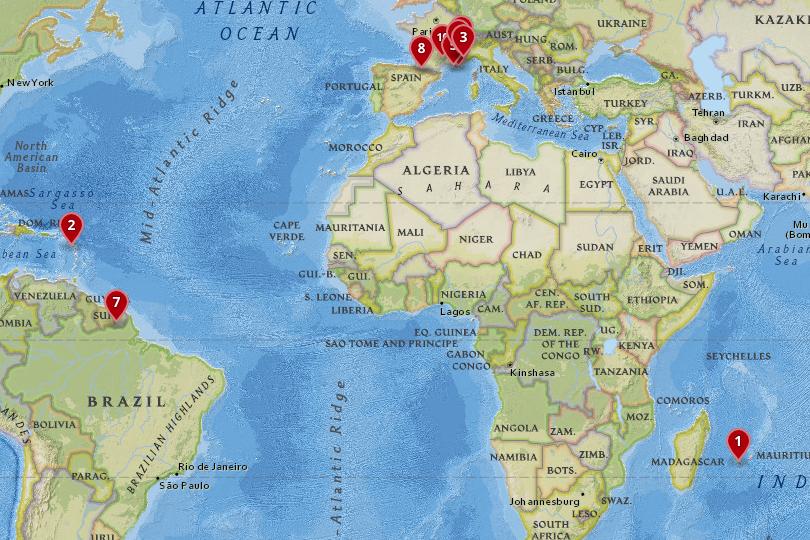 © OpenStreetMap contributors © Esri — National Geographic
© OpenStreetMap contributors © Esri — National GeographicMap of National Parks in France
10. Cevennes National Park
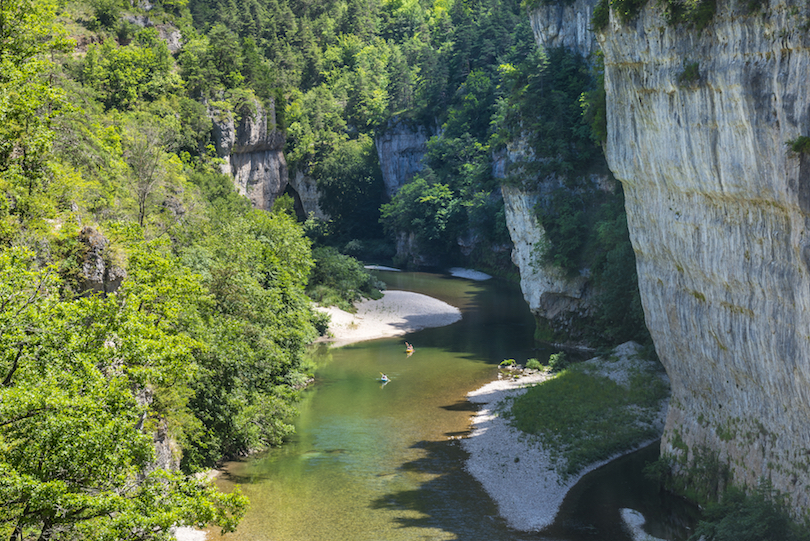 dreamstime/© Colombo
dreamstime/© ColomboWith a wide variety of different landscapes on offer, Cevennes
National Park makes for some delightful hiking as the scenes slowly
merge into each other and change before your very eyes. The array of
mountains and plateaus located within the park have rolling valleys and
hills that fall away from their peaks and these are beautiful to behold
from up high.
Forests and meadows provide a lovely contrast to the barren rock of
the cliffs and plateaus and a number of peaceful rivers and streams
meander their way between the hills. Fauna and flora spring out at you
from every nook and cranny and the wild flowers only add to the scenic
feel of this charming national park in Southern France.
9. Port-Cros National Park
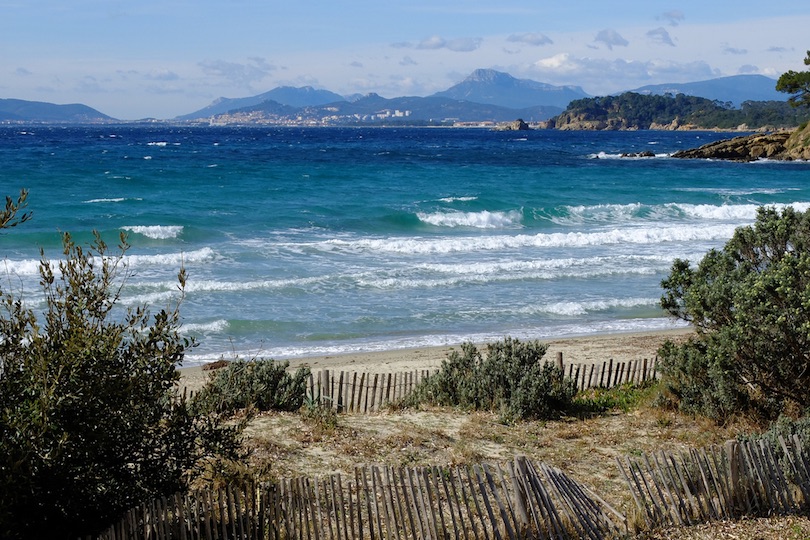

Located in the Mediterranean, this delightful national park is
situated on the island of Port-Cros that gives it its name. Three
neighboring small islands are also included within its boundaries and
their serene turquoise waters welcome you into their warm embrace.
The beige rocks and sandy beaches that line the islands´ shores stand
out beautifully between the green fauna of their interiors and the
blues waters that surround them. The maritime waters around the national
park are protected as are the fragile ecosystems of the islands
themselves and tourism is strictly managed to ensure the environments
remain in pristine condition.
Arriving by boat is a memorable affair as the idyllic islands appear
in the distance before you, slowly growing in size until finally they
are right there in front of you in all of their glory.
8. Pyrenees National Park
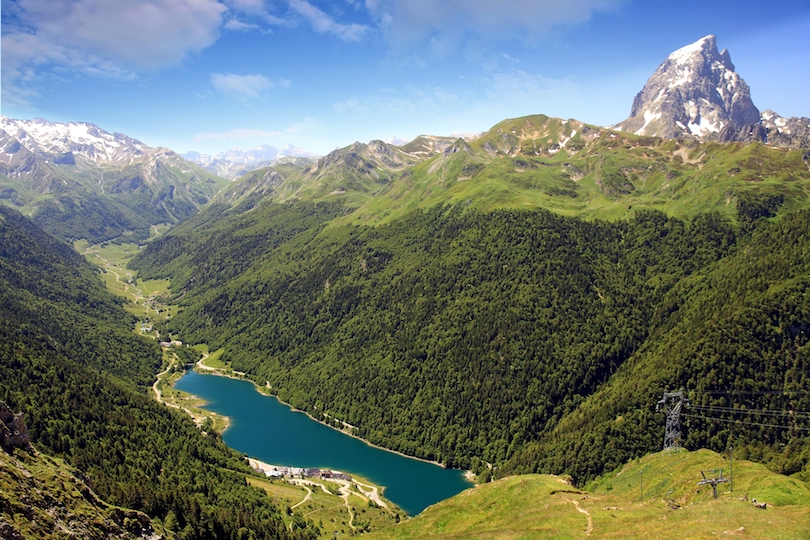 dreamstime/© Jose Lledo
dreamstime/© Jose LledoSimply spectacular. This incredible national park has a plethora of
beautiful views and panoramas just waiting for you to discover. Located
on the border between France and Spain, the park is named after the
mountain range that dominates its area and there are certainly an
amazing array of landscapes for you to enjoy.
Your spirit will soar, free and unencumbered by the worries of the
world you can let go and revel in the unforgettable scenery all around
you. Picturesque and perfect in their beauty the mountains rear
dramatically about you and their snow-capped peaks dominate the skyline.
As such, there are a myriad of lovely trails and climbing routes for
you to explore and it is also possible to go skiing in the higher
echelons of the mountains.
Pyrenees National Park is definitely well worth a visit as the greens
of the valleys give way to the grey rocks of the mountainside which in
turn changes to dazzling white snow and beautiful blue skies.
7. Guiana Amazonian National Park

Established to protect the Amazon rainforest located in French
Guiana, this expansive national park is one of the largest in the world
and as such there is an unfathomable number of things to see and do.
Undeveloped, untouched and consequently pristine, wild and free, this
remote part of the world is only accessible by plane or pirogue.
The dense rainforest is home to a wide array of animals and birds,
not to mention the fauna and flora that proliferates absolutely
everywhere. From the overgrowth, Mount Galbao rears up dramatically
towards the heavens while rivers course between the endless trees.
Canoeing along the waters if an unforgettable experience and one of
the most popular places to visit is the spectacular Gobaya Soula falls.
With sixty meter trees crowding around you at times, Guiana Amazonian
National Park is a once in a lifetime place to visit.
6. Vanoise National Park
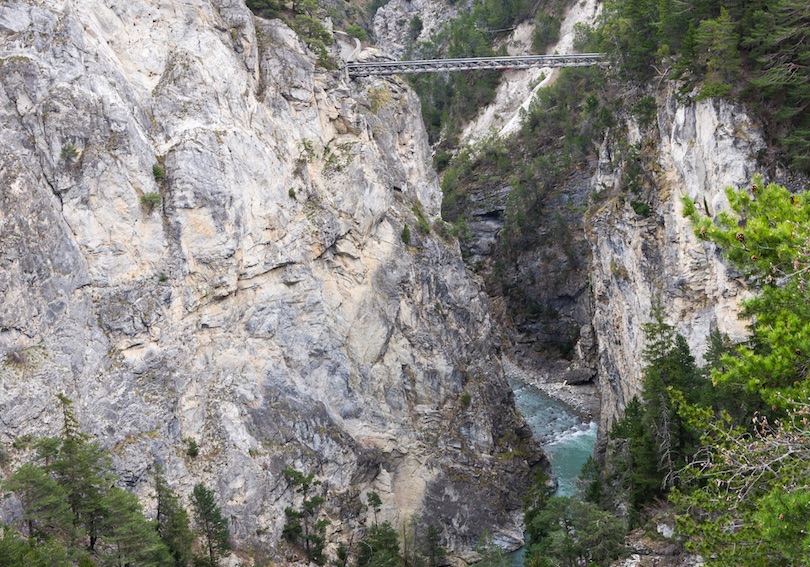 dreamstime/© Yulia Belousova
dreamstime/© Yulia BelousovaThe largest national park in mainland France is a marvel to visit due
to the incredible scenery on offer. Located in the French Alps, it is
the heart achingly beautiful mountains that are the main attraction and
hikers, mountaineers and skiers will never want to leave its astounding
premises.
La Vanoise offers up the quintessential image of the French Alps with
the domineering mountains, sweeping valleys and gorgeous lakes all
contributing to the picture-perfect scenes. The panoramas and views are
endless and up amidst the clouds, the world below appears to be in
miniature. The Grand Casse is the highest peak in the park and with the
massif surrounding it, it is awe-inspiring to behold.
5. Calanques National Park
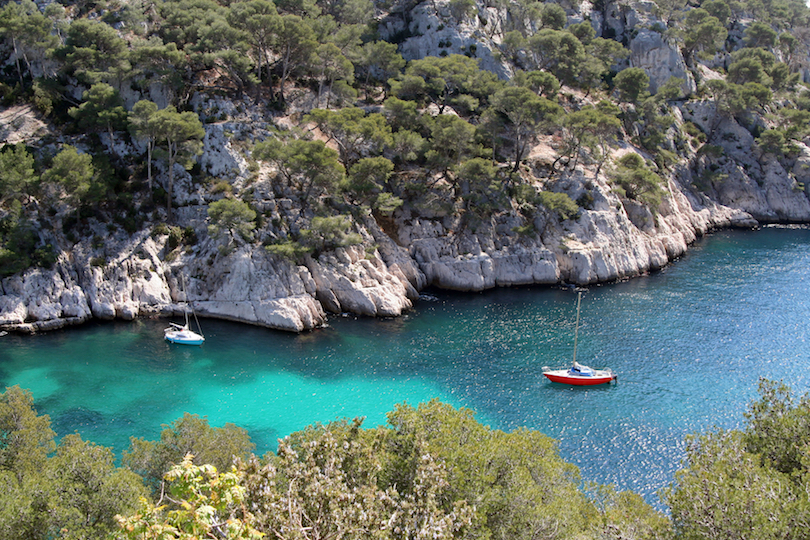 dreamstime/© Thierry Maffeis
dreamstime/© Thierry MaffeisLying between Marseille and Cassis, this coastal park has a
picturesque albeit slightly daunting clifftop walk which hikers will
adore. Following the at times treacherous path, you weave your way
amidst the rock-strewn terrain as the cliff face plunges away to the
side of you. Below, the glistening turquoise waters only add to the
stunning scenery on show.
The rugged white cliffs and craggy rock faces have delightful tufts
of green growing from them and the vivid colors make this a delightful
part of the world to explore. Sailing along the Calanques Massif which
gives the national park its name is awe-inspiring and in the protected
waters, dolphins and turtles can be found swimming about.
4. Ecrins National Park
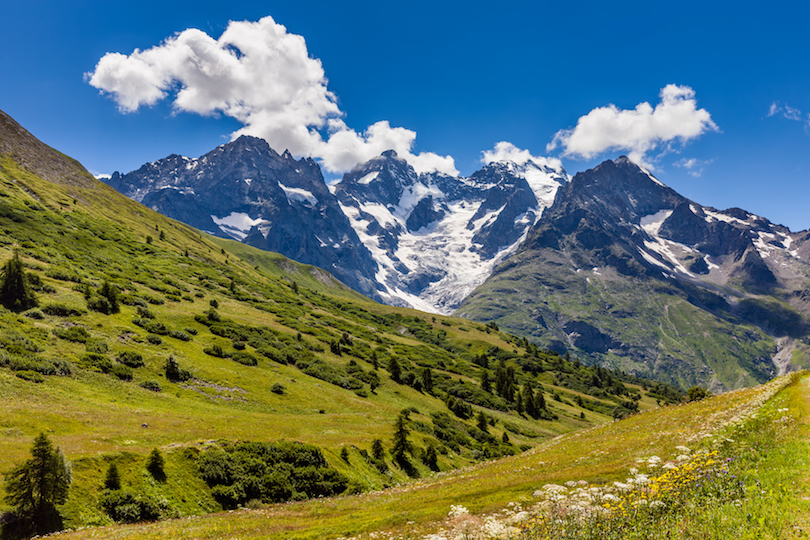 dreamstime/© Francoisroux
dreamstime/© FrancoisrouxThis massive national park is so large that it has over a hundred
mountain peaks contained within it as well as sixty lakes that so
beautifully reflect the mountains above them. The landscapes on offer
are to die for such is their splendor and magnificence.
Centered around the Massif des Ecrins, it is these lofty realms which
are part of the Dauphine Alps that form the main body of the incredible
scenery and mountaineers and hikers will adore all that there is to see
and do. The forested valleys and green slopes of the mountains
eventually give way to rocky mountainside and snow amidst the higher
realms of the peaks.
Breathtakingly beautiful, there are over 700 kilometers of trails for
visitors to enjoy and it is also a great place for skiers as there are a
number of ski resorts for them to frequent.
3. Mercantour National Park
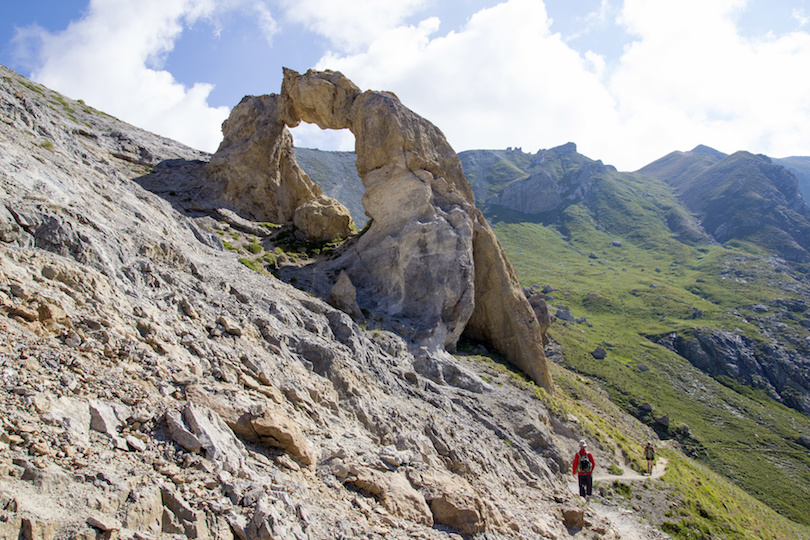
With seven rolling valleys to explore, rustic villages, mountain
peaks and more; Mercantour National Park certainly has a lot going for
it. Fauna and flora abounds and amidst all of the nature on show,
marmots, ibex and chamois can be found when walking along the park´s
many trails and paths.
Adventurous visitors may dare to hang-glide and throw themselves off
of one of the steep cliff faces to dazzle at the world below. History
lovers on the other hand will want to head to the Vallee des Merveilles
where there are over 36,000 rock engravings to delight in.
On top of these attractions, the maritime Alps provide an ever
changing and beautiful backdrop to the valleys and lakes interspersed
amongst them. Among all the natural wonders on show, the Gordolasque
Valley and the river that runs through it are particularly lovely to
behold.
2. Guadeloupe National Park
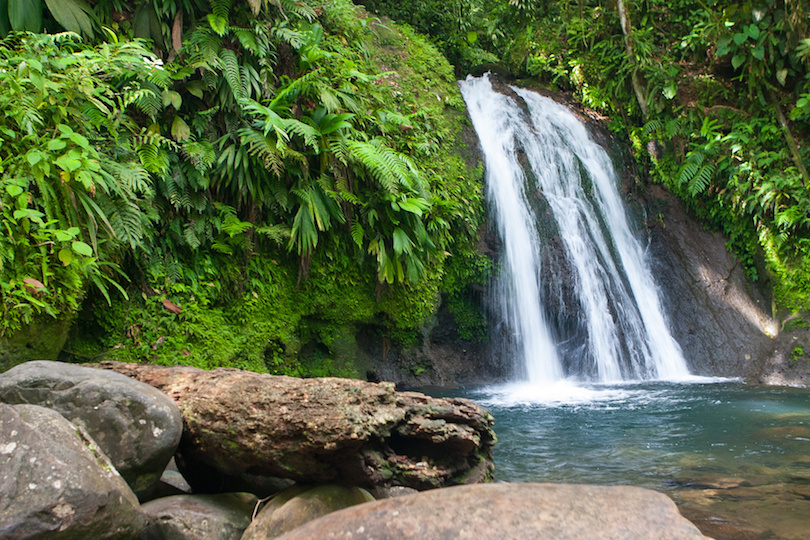 flickr/Bernard Dupont
flickr/Bernard DupontThis biodiversity hotspot is fascinating to visit for all of the
amazing things there are to see and do although it certainly is quite
the trip from mainland France! Situated in the Caribbean, this national
park is well worth visiting if you have the chance as the tropical
rainforest and impressive massif of the mountains are home to a wide
array of mammals, birds and insects.
Beautiful to behold, amidst the dense and steamy undergrowth are a
number of mesmerizing waterfalls for you to discover. On the slopes of
La Soufriere volcano for instance, there are the Carbet Falls – a series
of waterfalls that plunge great depths with pristine tropical foliage
surrounding them on either side. Hiking here is spectacular and the
sounds of the rainforest will echo in your ears long after you have left
this earthly paradise.
1. Reunion National Park
 dreamstime/© Vladvitek
dreamstime/© VladvitekPhwoar. This idyllic island is an absolute dream to visit and lucky
tourists will never want to leave such is the natural beauty on offer.
Located in the Indian Ocean, this national park in the French overseas
territory of La Reunion has a volcanic landscape that is home to a
variety of ecosystems.
Consequently, it is a biodiversity hotspot and is popular with hikers
and mountaineers due to the extensive paths and routes that weave their
way through the mountainous region. With rainforests, dazzling
waterfalls and an abundant range of fauna and flora also on offer,
nature lovers will adore this special place.
The two volcanoes comprising the towering Piton des Neiges and
domineering Piton de la Fournaise are just two places from which
visitors may gaze out over the spectacular scenes around them. An
unbelievable place, La Reunion National Park is certainly worth the
effort of getting there!
and disobedience movement against all governments till the curfew like
lockdown is lifted and normalcy is retained in where 99.9% Awakened
Aboriginal Societies have decided to move freely without caring CURFEW LIKE LOCKDOWNS’

Awakened People with Awareness have come together to make their voices
heard against mandatory vaccinations, mandatory masks, mandatory
anything really. No more curfew like lockdowns, no more second wave
business’.’TOP DOCTORS AND NURSES SPEAKING OUT TRUTH AGAINST GOVERNMENT
PUSHING FEAR AND IGNORING SCIENCE.’ means Discovery
of Awakened One with Awareness Universe (DAOAU) For The Welfare,
Happiness, Peace of All Sentient and Non-Sentient Beings and for them to
Attain Eternal Peace as Final Goal.
